
The May 2022 Financial Stability Review (FSR) has been prepared against the backdrop of the devastating invasion of Ukraine. We do not yet know how the war will be resolved. But we do know that the human suffering it has caused is enormous. We hope for peace.
This war is also affecting the economy, in Europe and beyond. The invasion and the associated uncertainty have prompted some repricing in global financial markets, albeit with much less turmoil than seen in March 2020, and dampened the confidence of businesses and consumers that are only just emerging from the tight restrictions imposed during the coronavirus (COVID-19) pandemic. Higher energy and commodity prices are pushing up inflation and slowing the economic recovery. Elevated volatility has highlighted some liquidity risks, notably in some commodity derivatives markets. However, the main threat to euro area financial stability comes from the impact through macroeconomic channels. This implies additional challenges for indebted businesses at a point in time when countries’ fiscal space is very limited and support may need to be more targeted than the broad fiscal policy response to the pandemic.
With these developments in mind, this FSR assesses financial stability vulnerabilities and their implications for financial markets, debt sustainability, bank resilience, the non-bank financial sector and macroprudential policies.
This issue of the FSR also includes two special features on topics that are increasingly part of our routine financial stability assessment at the ECB. The first focuses on recent advances in the monitoring of financial stability risks stemming from climate change, building on previous special features on the topic. The second special feature explores risks arising from crypto-assets – which have been increasing over time, as this sector grows both in its size and in its integration with the core financial system.
This issue of the FSR has been prepared with the involvement of the ESCB Financial Stability Committee, which assists the decision-making bodies of the ECB in the fulfilment of their tasks. The FSR exists to promote awareness of systemic risks among policymakers, the financial industry and the public at large, with the ultimate goal of promoting financial stability.
Luis de Guindos
Vice-President of the European Central Bank
Overview
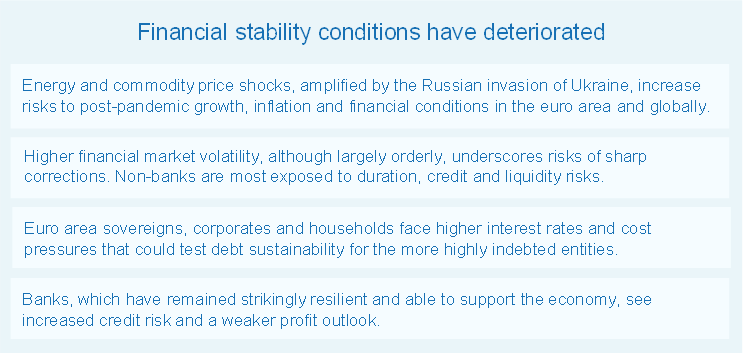
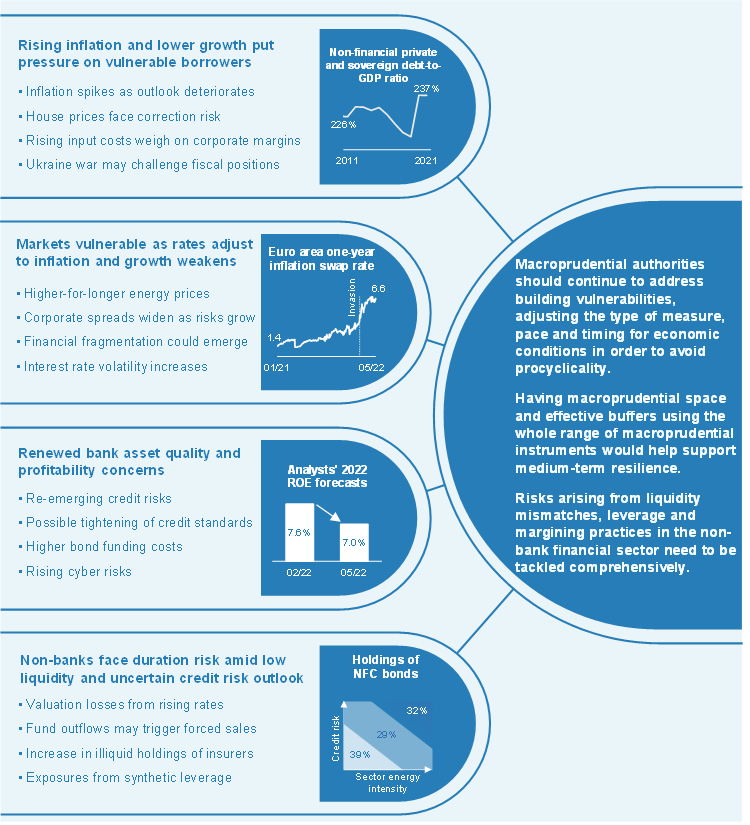
Higher prices, exacerbated by the Russia-Ukraine war, weaken the recovery and increase global risks
Financial stability conditions have deteriorated, as the post-pandemic recovery has been tested by higher inflation and Russia’s invasion of Ukraine. Since late 2021, rising inflationary pressures have threatened to slow the momentum of the recovery in 2022. Upside risks to euro area inflation and downside risks to growth rose sharply following the outbreak of the Russia-Ukraine war (Chart 1, panel a). In particular, large rises in commodity and energy prices (Chart 1, panel b) and ongoing global supply chain pressures are expected to prolong the period of elevated inflation. The course and consequences of the Russia-Ukraine war are still hard to predict. While peace could reverse some pressures, a protracted conflict could imply sustained higher inflation and even lower growth outturns than currently expected. Risks to inflation, growth and global financial conditions could also be triggered by other global events, such as a broader resurgence of the coronavirus (COVID-19), emerging market weakness or a sharper economic slowdown in China (Box 4).
Chart 1
Risks of higher inflation and lower growth outturns in the euro area amplified by an intensified commodity and energy price shock
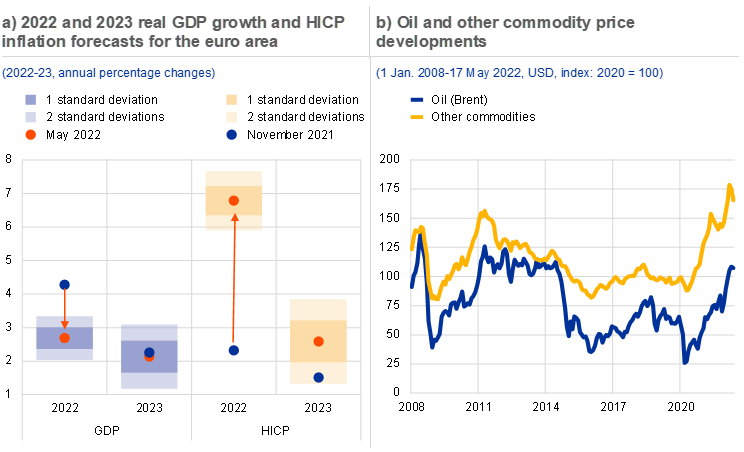
Sources: Consensus Economics Inc., Refinitiv, Hamburg Institute of International Economics and ECB calculations.
Note: Panel a: shaded areas display one and two standard deviations in Consensus expectations for euro area real GDP growth and HICP inflation. HICP stands for Harmonised Index of Consumer Prices. Panel b: other commodities include food (cereals, oilseeds/oils and tropical beverages/sugar) and industrial raw materials (agricultural raw materials, non-ferrous metals and iron-ore/scrap).
Higher inflation and lower growth could increase market volatility and challenge debt servicing capacity as financing costs rise. The consequences of the war and the shift to a lower-growth, higher-inflation environment affect virtually every aspect of economic activity and financing conditions. In turn, these developments might not only amplify, but could also trigger the materialisation of pre-existing financial stability vulnerabilities identified in previous issues of the FSR. These include heightened debt sustainability concerns in non-financial sectors or the possibility of corrections in both financial and tangible asset markets (Box 3).
Initial risk-off reaction in markets largely orderly, but asset price correction concerns remain
The Russian invasion of Ukraine triggered a large but, in most cases, short-lived market reaction. In early 2022, markets, positioning for solid growth, a temporary spike in inflation and relatively modest policy tightening, saw a repricing in global equity and bond markets. The outbreak of the war, which increased the risk of a higher-inflation, lower-growth scenario, saw market volatility increase, credit spreads widen and equity indices decline (Chart 2, panels a and b). The market response was substantial, but more modest than at the onset of the pandemic. Movements in commodity markets were most pronounced, as Russia and Ukraine are key suppliers. Euro area assets, given greater proximity and links to Russia and Ukraine, experienced larger losses than US assets. By the end of March, euro area markets had recovered most of the initial losses, but commodity prices remained elevated. Over the course of April and May, concerns about the global growth outlook and central banks’ response to higher inflation rates led to renewed weakness in risky asset valuations.
Chart 2
The initial market correction to the war was largely orderly, but liquidity pressures arose in some derivatives markets
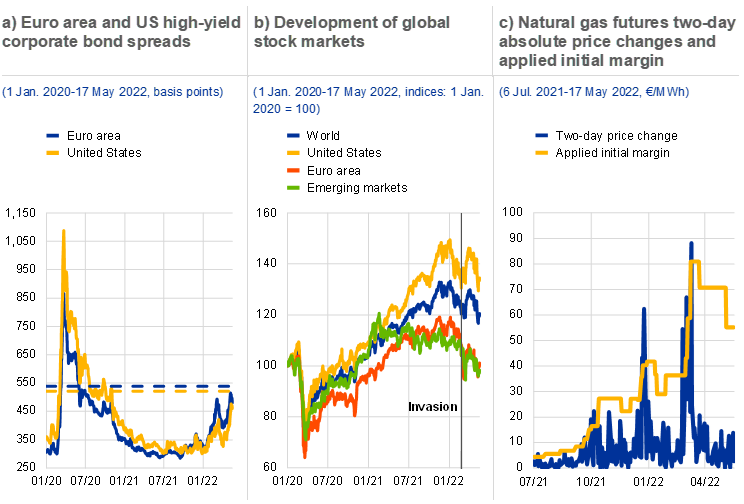
Sources: Bloomberg Finance L.P., EPFR Global, ICE Clear Europe and ECB calculations.
Notes: Panel a: dashed lines represent the long-term average over the past two decades. Government option-adjusted spreads are employed. Panel b: equity indices shown are the MSCI All Country World Index, the MSCI USA Index, the MSCI Euro Index and the MSCI Emerging Markets Index. Panel c: data on margins are provided by ICE Clear Europe in accordance with the Terms of Use. Applied initial margins are based on the scanning ranges published by ICE Clear Europe. Full initial margins should be computed with the CCPs’ proprietary risk models, in this case those of ICE Clear Europe, taking into account all risk parameters and full exposures.
Further corrections in financial markets could be triggered by an escalation of the war, even weaker global growth or if monetary policy needs to adjust faster than expected. Despite recent asset price corrections, valuations remain stretched in the light of the deterioration in macro-fundamentals, and further sharp corrections are a risk. Such corrections could be triggered by a further escalation of the war, emerging market stresses or by more persistent inflation than currently foreseen, which might prompt faster monetary policy normalisation by major central banks. Higher interest rates could challenge the valuations of riskier assets, such as equities. Euro area sovereign and high-yield credit spreads have widened over the course of 2022. Spread increases are in part related to the rise in underlying risk-free rates, as the latter mechanically have a larger impact on the earnings and budget deficits of more indebted firms and sovereigns.
Large shifts in commodity prices and related margin requirements have posed challenges to liquidity management for some derivative market participants. Commodity derivatives markets are used by a wide range of firms, including energy producers, suppliers and distributors, and users, to manage risks arising from volatile commodity prices, and enable them to fulfil contracts with corporates and households. In response to the recent rise in commodity price volatility, central clearing counterparties (CCPs) and clearing members have increased the initial margins for commodity derivatives (Chart 2, panel c). Margin requirements must be met by posting cash or highly liquid collateral. For some firms, these liquidity requirements may become prohibitive, while for others, the cost of hedging may have started to outweigh the perceived benefit. As a result, some firms may choose to reduce their hedging activities, or switch to contracts with lower collateralisation needs, including non-centrally cleared derivatives (Chapter 2). In the latter case, both the firm and the counterparty could be more exposed to counterparty credit risk. Sufficient margining is an important safeguard in the financial system. But recent developments do raise the question of whether margining practices (including those between the clearing member and their client) might be unnecessarily procyclical, and whether they are sufficiently transparent (Chapter 5).
Investment funds saw manageable outflows following the invasion, but euro area non-banks remain vulnerable to a further market correction, given high duration, credit and liquidity risk. Limited aggregate exposure to Russian and Ukrainian assets meant that only a few of the more specialist investment funds were suspended. That said, since early 2022, there has been a rotation from corporate to sovereign bond funds, as well as from growth to value equity funds. After the start of the war, there had been renewed interest in inflation-protected bond funds in anticipation of higher inflation, and in commodity-related equity funds in the light of the surge in energy prices. These trends slowed down or reversed again in late April in line with weaker performance of these asset classes (Chart 3, panel a). Some duration risk for non-banks has started to materialise in recent quarters, and further valuation losses may arise. Non-banks also have large exposures to weaker corporates which may be especially vulnerable to higher inflation and lower growth. The risk that investment funds could amplify a market correction due to fire sales remains, given low liquidity buffers (Chart 3, panel b). For some non-banks, additional vulnerabilities stem from their excessive synthetic leverage via derivatives (Box 7) or investments in crypto-assets, where growing institutional investor interest is deepening the linkages with the mainstream financial system (Special Feature B). In the medium term, however, a higher interest rate environment could reduce the non-bank sector’s incentives to search for yield and benefit the insurance and pension fund sector because of its negative duration gap, thereby mitigating overall financial stability risks (Chapter 4).
Chart 3
Non-banks proved largely resilient to the market impact of the invasion, but underlying credit, duration and liquidity risks remain causes for concern

Sources: EPFR Global, ECB (Investment Funds Balance Sheet Statistics and Securities Holding Statistics) and ECB calculations.
Note: Panel b: average residual maturity is a proxy for duration risk and is used here because of the longer available time series.
Input price increases and higher financing cost add strains for more indebted firms and sovereigns
Euro area corporates face renewed headwinds as input prices have soared and the economic outlook has become more clouded. A solid economic recovery helped measures of aggregate corporate vulnerability to improve towards the end of 2021 (Chapter 1.3). Gross profits recovered to 7% above pre-pandemic levels, while policy support measures have kept corporate insolvencies at historic lows. However, a weaker economic growth outlook, coupled with growing margin pressure as a result of soaring input prices, has led to some increase in expected corporate default rates (Chart 4, panel a).
There is a sizeable cohort of more vulnerable and pandemic-strained firms, some of which are also sensitive to commodity prices. The most vulnerable corporates which are more indebted, less liquid and have lower sales levels might face particular challenges in the event of a pronounced economic slowdown (Box 1). Higher energy and commodity prices could hurt activity in economic sectors which have not yet fully recovered from the pandemic, such as air transport, accommodation, and food and beverages (Chart 4, panel b), or which have low pricing power to pass on higher costs (Chapter 2). These vulnerabilities are compounded by the prospect of tighter financing conditions that would adversely affect the debt servicing capacity of lower-rated firms in particular. This could also fuel corporate downgrade risk, as the bulk of issuance activity in recent years has taken place in the lowest investment grade bucket (BBB).
Chart 4
Signs of renewed risks for the corporate sector, with some pandemic-strained sectors highly exposed to higher energy prices
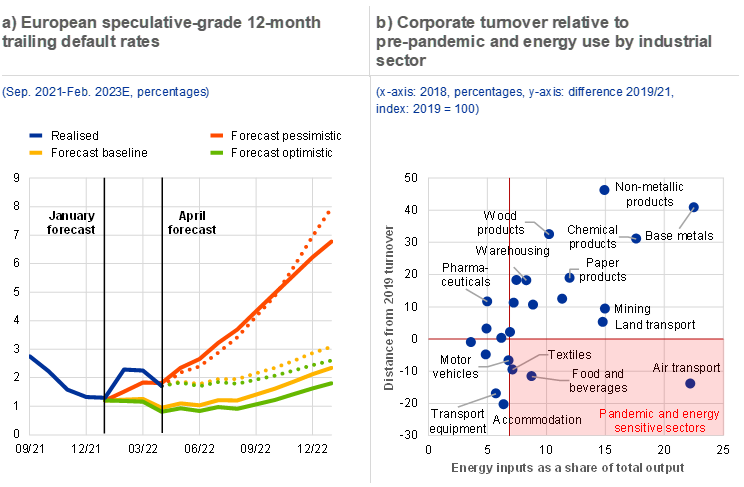
Sources: Moody’s Analytics, OECD Trade in Value Added (TiVA) database (2018), Eurostat and ECB calculations.
Notes: Panel a: European speculative-grade default rates forecast by Moody’s Analytics as at January 2022 (solid lines) and April 2022 (dotted lines). The baseline forecasts incorporate low refinancing risk and healthy corporate fundamentals. The optimistic scenario builds on the favourable baseline, expecting markets to remain very supportive of speculative-grade issuers in 2022, while showing exceptional demand for high-yield debt in the search for yield. By contrast, the pessimistic scenario acknowledges a particularly weak ratings mix among European speculative-grade issuers. For more details on the different scenarios, see the Moody’s website. There is a structural break in the time series of realised rates as of March 2022, as defaulting and non-defaulting Russian issuers whose ratings were recently withdrawn have been excluded. Panel b: energy use includes direct and indirect use of: (i) electricity, gas, steam and air conditioning; (ii) mining and quarrying; and (iii) coke and refined petroleum products as a share of total output. Energy inputs by industry are classified according to the United Nations International Standard Industrial Classification for All Economic Activities (ISIC), Rev. 4, and are attributed to each sector based on the four-digit SIC code. The red vertical line represents the median usage of energy inputs as share of total output across all sectors of economic activity. Out of 42 NACE sectors, 24 are shown in the chart.
Euro area fiscal positions also face challenges as they now encounter a weaker recovery and tighter financial conditions. In 2021, as the euro area economy began recovering from the COVID-19 shock, governments gradually withdraw the stimulus they provided during the pandemic. As a result, fiscal positions in 2022 are expected to improve compared to 2021. However, the repercussions of the war in Ukraine may create new draws on public finances. While immediate stress in euro area sovereign bond markets remained low, short-term fiscal pressures have increased in a number of countries (Chart 5, panel a). This is attributable to measures aimed at cushioning the adverse impact of higher energy prices on households and corporates, as well as the cost of managing the flow of refugees and higher defence spending in some countries. Market participants estimate the associated additional fiscal impact for the largest euro area countries at around 1.2 percentage points of GDP on average. Also, where coupled with lower economic growth than previously anticipated, higher interest rates may translate into higher refinancing needs (Chart 5, panel b). This could put sovereign debt dynamics on an unfavourable trajectory, especially in higher-debt countries.
Additional fiscal space to cushion the economy from future shocks may have become more limited in some euro area countries. This, coupled with debt sustainability concerns, could contribute to a reassessment of sovereign risk by market participants and spur fragmentation pressures in sovereign bond markets. That said, countries with higher sovereign risk have taken advantage of low rates to prolong their debt maturity profile, which reduces their vulnerability to abrupt changes in market sentiment. To the extent that higher sovereign vulnerabilities coincide with fragilities in the corporate and banking sectors, risks materialising in any of these sectors (in isolation or combination) may lead to adverse feedback loops between sovereign, banks and corporates (Box 1).
Chart 5
Euro area sovereigns transition from pandemic support to tackling the repercussions of the war, as higher rates and lower growth challenge more indebted sovereigns
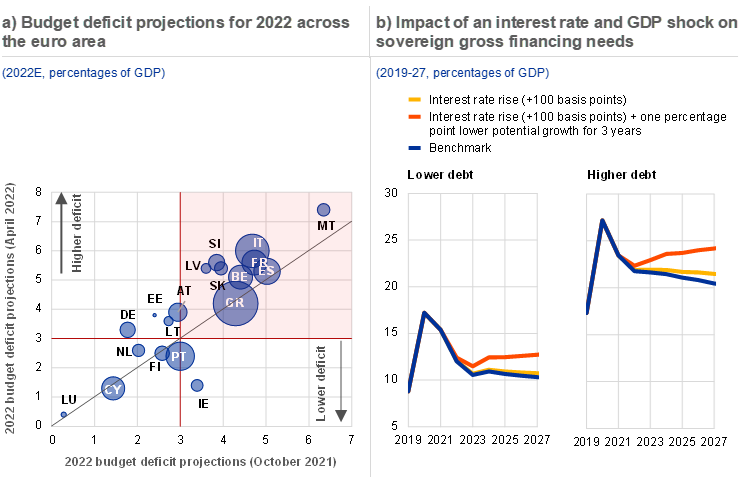
Sources: IMF Fiscal Monitor, ECB and ECB calculations.
Notes: Panel a: the horizontal and vertical red lines represent the 3% of GDP Maastricht threshold for the budget deficit. The size of the bubble represents the general government gross debt-to-GDP ratio in 2021. Panel b: the aggregate of higher-debt countries includes euro area countries with a 2021 general government debt-to-GDP ratio above 90%. The lower-debt aggregate includes the remaining euro area countries. The threshold of 90% of GDP for sovereign debt is based on findings in the empirical literature. See, for example, Checherita and Rother*. The benchmark refers to the main scenario of the debt sustainability analysis simulations based on the December 2021 Eurosystem staff macroeconomic projection exercise for the period 2021-24 and assumes broad minimum compliance of the fiscal path thereafter with the Stability and Growth Pact (gradual convergence to countries’ specific medium-term fiscal objectives, with current debt rule requirements not included in the simulations). In the first scenario, a permanent increase in interest rates of 100 basis points is applied to all new and refinancing operations as of 2023 across the whole yield curve over a ten-year horizon. In the second scenario, the increase in interest rates is combined with a fall in potential GDP growth by one percentage point for three years over the period 2023-2025. No catching-up effect is expected after 2025, leading to a permanent downward shift of 3% in the potential GDP level.
*) Checherita, C. and Rother, P., “The impact of high and growing government debt on economic growth – an empirical investigation for the euro area”, Working Paper Series, No 1237, ECB, 2010.
Expansion continues in residential real estate markets, increasing the vulnerability to corrections
Vulnerabilities in euro area residential real estate markets continued to build. Euro area house prices increased at a rate of almost 10% in the final quarter of 2021 – the fastest pace observed in the last 20 years (Chart 6, panel a). The trend was driven among other things by changes in housing preferences triggered by the pandemic, low interest rates and supply-side constraints (Box 2). At the same time, the buoyant growth of residential real estate prices is coupled with robust mortgage lending (Section 1.5). The associated rise in vulnerabilities led to the European Systemic Risk Board issuing new warnings and recommendations in December 2021, strengthening the case for macroprudential action in some countries (Chapter 5). While house price pressures are buttressed in the near term by tight supply conditions and continued demand amid household and investor preference for housing, signs of overvaluation render some housing markets prone to price corrections. In particular, an abrupt increase in real interest rates could induce house price corrections (Box 2).
Chart 6
Euro area households could face the triple challenge of possible corrections in residential real estate markets, higher interest rates and an income squeeze

Sources: Eurostat, ECB and ECB calculations.
Notes: Panel a: construction price expectations refer to the three months ahead. RRE price growth is shown until the fourth quarter of 2021 and lending for house purchase until March 2022. Panel b: the red horizontal and vertical lines represent the euro area aggregate values. The debt service ratio is calculated as debt service cost divided by income following Drehmann et al.* Compensation of employees is used to measure the income of households.
*) Drehmann, M., Illes, A., Juselius, M. and Santos, M., “How much income is used for debt payments? A new database for debt service ratios”, BIS Quarterly Review, September 2015.
Risks from mortgage indebtedness are amplified by the impact of higher costs on the debt servicing capacity of euro area households. Despite rising indebtedness since the start of the pandemic (Section 1.4), balance sheet fundamentals of euro area households remained relatively solid overall. However, higher inflation and energy price outturns may reduce households’ purchasing power, unless wages catch up sufficiently without destabilising inflation expectations. The associated squeeze may particularly affect lower-income households, which spend a larger portion of their incomes on food and energy. At the same time, the currently relatively favourable financial and employment situations of euro area households could worsen, should prolonged economic weakness translate into a growing number of corporate insolvencies and restructurings. In an environment of deteriorating income positions and higher interest rates, households’ debt servicing capacity could be challenged, particularly in countries with elevated debt levels and high debt servicing needs (Chart 6, panel b). That said, the shift towards more fixed-rate mortgage lending in recent years will shield many households from the immediate impact of higher interest rates (Chart 7, panel c). Similarly, active use of macroprudential policies in most euro area countries, notably through borrower-based measures, are helping to improve the resilience of borrowers.
Euro area banks show resilience, but profitability prospects worsen as asset quality concerns resurface
The positive market sentiment towards euro area banks in 2021 reversed sharply following the Russian invasion of Ukraine. Marked corrections in bank share prices (Chart 7, panel a) erased the gains made in 2021 amid improved earnings and expectations of higher interest rates. After the initial shock, markets reversed some of the losses as it became apparent that only a few banks had material direct exposures to Russia and Ukraine. In addition, the majority of banks signalled their commitment to previously announced dividend and share buyback plans for 2022.
After a remarkable recovery in bank profitability in 2021, projections for 2022 have been revised down as credit risks have increased. Bank profitability surpassed pre-pandemic levels in 2021, driven by higher operating income and lower loan loss provisions, but profitability prospects have worsened in line with a weaker macroeconomic backdrop. Profitability remained solid at the start of 2022 too, but bank analysts revised down their 2022 return on equity (ROE) forecasts for euro area banks to around 7% (Chart 7, panel a) – a level which is still low by international standards. While banks showed resilience and credit risks associated with direct exposures are limited, the banking sector could be indirectly affected by the repercussions of the war. For example, it may be exposed to greater corporate and household credit risks as a result of higher commodity prices and disrupted global supply chains. In fact, a further major energy price shock could translate into higher corporate probabilities of default (PDs), including in some sectors that were badly hit by the pandemic, such as accommodation and food services (Chart 7, panel b). However, a broader vulnerability exercise suggests that overall the banking sector is resilient to the second-round effects arising from the Russia-Ukraine war (see Box 6).
A rise in interest rates may provide some support to bank margins in the short run, but some banks might face challenges in the medium term. A higher interest rate environment and steeper yield curve will mechanically support interest income and, in turn, bank profitability, but funding low-yielding assets profitably may become challenging in the medium term. In particular, the large-scale shift over the last decade from floating to fixed-rate lending, especially for households, may dampen some of the benefits that banks enjoy from higher interest rates (Chart 7, panel c). This may pose a risk to banks’ medium-term profitability prospects in cases where such interest rate exposures are less well hedged (Box 5). As interest rates rise, banks could also face higher credit risks, given growing exposures to vulnerabilities in the non-financial sector in recent years.
Chart 7
Bank stock prices reflect an uncertain outlook amid resurfacing asset quality concerns and rising interest rate risks for some banks
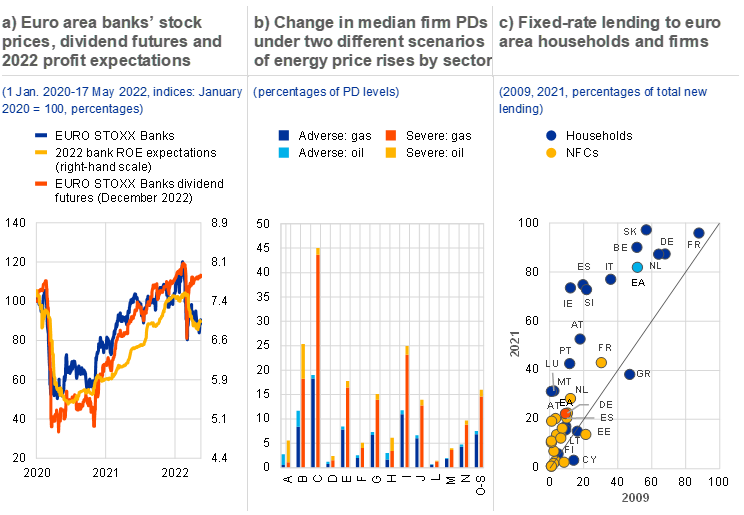
Sources: Bloomberg Financial L.P., Urgentem, Moody's Analytics, Bureau van Dijk – Orbis database, ECB and ECB calculations.
Notes: Panel a: 2022 bank ROE expectations indicate the weighted average of a sample of 32 listed euro area banks. Panel b: adverse scenario: +69% on gas price and +24% on oil price; severe scenario: +138% on gas and +48% on oil price. The energy price assumptions are consistent with the scenario analysis conducted in the context of the March 2022 ECB staff macroeconomic projections. NACE codes and corresponding economic activities: A – Agriculture, forestry and fishing, B – Mining and quarrying, C – Manufacturing, D – Electricity, gas, steam and air conditioning supply, E – Water supply; sewerage, waste management and remediation activities, F – Construction, G – Wholesale and retail trade; repair of motor vehicles and motorcycles, H – Transportation and storage, I – Accommodation and food service activities, J – Information and communication, L – Real estate activities, M – Professional, scientific and technical activities, N – Administrative and support service activities, O – Public administration and defence; compulsory social security, P – Education, Q – Human health and social work activities, R – Arts, entertainment and recreation, S – Other service activities. Panel c: NFCs stands for non-financial corporations.
Long-standing structural challenges, together with a greater need to manage cyber risk, continue to weigh on the outlook for euro area banks. Longer-term challenges associated with low cost-efficiency, limited revenue diversification and overcapacity compound growing cyclical headwinds. In addition, euro area banks urgently need to press ahead with their digital transformation, not least to be able to manage the growing threat of cyber risks. However, having focused on cost-cutting in recent years to boost profits, parts of the banking sector continue to lag behind global peers in terms of IT infrastructure investment (Chapter 3). Heightened uncertainty surrounding the outlook and lower profit expectations may now further delay the transformation plans of euro area banks, which would have an adverse impact on their competitiveness.
Financial institutions and markets need to accelerate the transition to a low-carbon economy
Banks and non-banks alike need to step up their efforts to support the move towards a net-zero economy. Metrics of financial institutions’ exposure to climate-related risks show little evidence of a decline over the last few years. In fact, while euro area NFCs have reduced actual emissions, loans to more polluting firms still represent around two-thirds of banks’ credit exposures (Special Feature A). Similarly, banks and non-banks have reduced their holdings of securities issued by firms with higher emission levels only slightly over the last five years (Chart 8, panel a). The Russian war in Ukraine has highlighted the risks that can arise from high dependency on fossil fuels, whose price and supply can be volatile.
Chart 8
The carbon footprint of financial institutions’ portfolios has not decreased significantly, and greenwashing risks remain high in financial markets
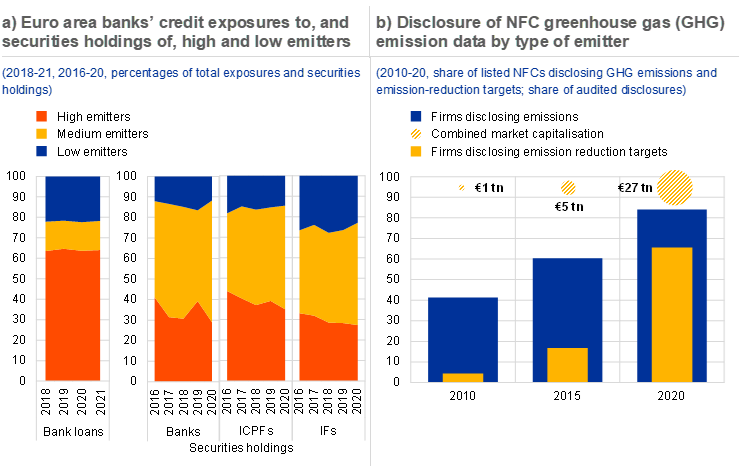
Sources: ECB (AnaCredit and Securities Holding Statistics), Bureau van Dijk – Orbis database, Refinitiv, Urgentem and ECB calculations.
Notes: Panel a: ICPFs stands for insurance corporations and pension funds; IFs stands for investment funds. High/low emitters are defined as firms with reported emission intensity in the top/bottom 33% of the distribution across euro area banks’ borrowers as of end-2020, i.e. firms with annual emission intensity registered in 2020 above 556 tCO2e/USD million and below 47 tCO2e/USD million. ICPFs stands for insurance corporations and pension funds, IFs stands for investment funds. Panel b: combined market capitalisation refers only to firms disclosing emission-reduction targets.
While green financial markets continue to deepen, there is a need to monitor greenwashing risks. Sustainable financial markets continued to grow at a brisk pace in 2021, amid growing investor interest in green finance. Firms are increasingly disclosing their exposure to transition risk as well as their commitments to reduce emissions (Chart 8, panel b), indicating increasing awareness of the need to transition to a low-carbon economy. That said, greenwashing risks do remain in capital markets. These need to be tackled using better, more consistent information and enhanced standards for financial instruments, to ensure that green finance effectively supports the transition to a low-carbon economy.
Macroprudential policy needs to strengthen resilience to handle future shocks
The euro area financial stability outlook has deteriorated as inflation has risen, especially since the start of the Russia-Ukraine war. Upside risks to inflation, especially from energy prices, and downside risks to growth are amplifying pre-existing vulnerabilities identified in previous issues of the FSR, such as those associated with mispricing in some financial and tangible asset markets, as well as the legacy of higher debt levels in non-financial sectors. The vulnerabilities identified could be exacerbated by shocks such as (i) a further escalation of the Russia-Ukraine war or further economic sanctions imposed in response to the war; (ii) unexpected changes in growth or inflation; or (iii) a resurgence in COVID-19 infections, with a greater economic impact than currently expected. The potential for these vulnerabilities to materialise simultaneously and possibly amplify each other further increases the medium-term risks to financial stability.
As economic conditions allow, further building resilience in a timely manner remains a sound policy strategy. Banks currently have ample capital headroom on top of their regulatory requirements, and a vulnerability analysis specifically assessing the adverse implications of the war in Ukraine indicates that the euro area banking system remains resilient under the scenarios considered. Nevertheless, macroprudential policy action would further enhance resilience against vulnerabilities that have already accumulated, including those in residential real estate markets, and mitigate the risk of bank de-leveraging if systemic risk materialises. As long as economic conditions do not deteriorate significantly, existing bank capital generation capacity and headroom should mitigate a detrimental impact on credit supply from increasing capital buffers. In addition, there are also costs associated with delayed action, especially if uncertainty persisted into the medium term and vulnerabilities remained unaddressed or continued to build. Overall, if the economic costs of activating additional capital buffers remain low and the financial cycle is expected to remain on an upward trend, as was the case prior to the outbreak of the war, when policy tightening commenced in some countries, authorities can continue to act appropriately while taking into account the uncertainty related to the war to avoid procyclical effects. Authorities should tailor their policy strategy to the national context by using the whole range of macroprudential instruments that are at their disposal, including borrower-based measures as already in place in several countries.
Creating additional macroprudential space while also enhancing the effectiveness of the existing countercyclical capital buffer would support the resilience of the financial system over the medium term. In its input to the European Commission’s review of the macroprudential framework, the ECB has called for more macroprudential space in the form of a higher amount of releasable capital buffers that could further improve banks’ loss absorption capacity while maintaining the provision of key services in a downturn. In addition, increasing the flexibility in the existing countercyclical capital buffer (CCyB) framework could facilitate timely policy action in both the activation and release phases. The ECB’s response also included additional proposals to fill other gaps in the policy toolkit, promote the implementation of instruments at the national level, streamline the activation and coordination procedures for macroprudential measures and address global risks.
Regulatory initiatives to tackle risks from liquidity mismatches, leverage and margining practices in the non-bank financial sector should continue to progress. Developing a comprehensive macroprudential approach for non-banks remains essential to address structural vulnerabilities and strengthen the sector’s resilience. The focus of the international policy agenda has now shifted to structural liquidity mismatches in the investment fund sector and should prioritise a better alignment of asset liquidity with redemption terms. The use of leverage by non-banks in a highly interconnected global financial system is a key concern for financial stability and needs to be tackled using a range of measures across entities and activities. In addition, recent events have underlined the need to make further progress with international efforts to assess financial stability risks arising from margining practices.
1 Macro-financial and credit environment
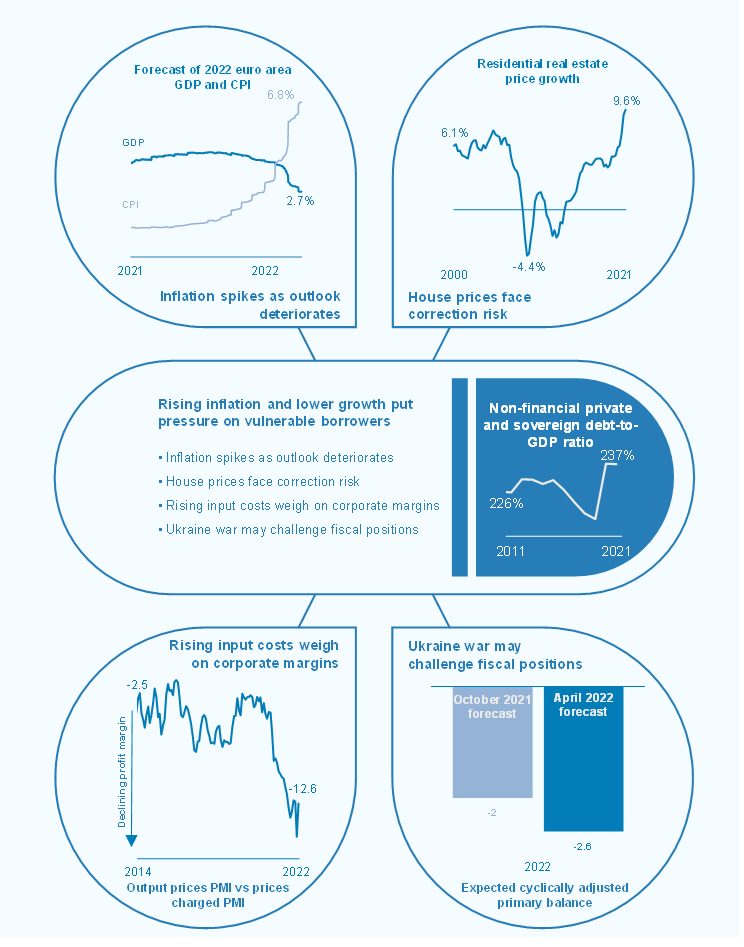
1.1 Euro area economic outlook weakens on the back of global cost pressures and the war in Ukraine
Since the November 2021 Financial Stability Review, the economic outlook for the euro area has weakened, while inflation projections have been revised upwards. Private sector forecasters have downgraded their growth expectations significantly since the end of last year as the repercussions of the Russian war in Ukraine reverberate globally, likely slowing the economic recovery. The supply chain and cost pressures that built up during the coronavirus (COVID-19) pandemic have been amplified by the war, which has prompted further increases in commodity prices, affected supply chains and substantially weakened consumer confidence. As a result, consensus expectations for real GDP growth in the euro area in 2022 have been downgraded to 2.7% (down 1 percentage points since late February), while inflation expectations have been revised upwards to 6.8% (up 2.6 percentage points since late February) (Chart 1.1, panel a).
Chart 1.1
Forecasters pare back growth prospects and raise inflation projections as sanctions slow the economic recovery and hit the Russian economy particularly hard
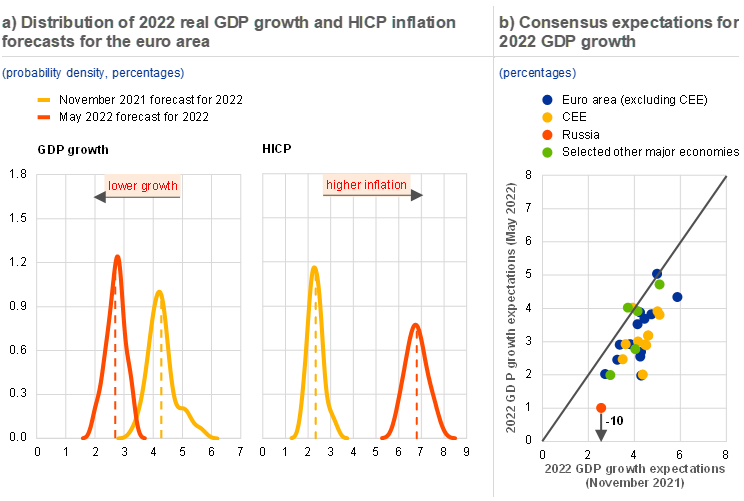
Sources: Consensus Economics Inc. and ECB calculations.
Notes: Panel a: HICP stands for the Harmonised Index of Consumer Prices measure of inflation. The dashed vertical lines represent the average forecast values. Panel b: selected other major economies include Australia, Canada, China, Japan and the United States. CEE stands for central and eastern Europe and includes Bulgaria, Czech Republic, Estonia, Latvia, Lithuania, Hungary, Poland, Romania, Slovenia and Slovakia. CEE and Russia forecasts show April 2022 consensus GDP growth expectations.
While the war in Ukraine has prompted material increases in energy and commodity prices, the more direct impact via euro area exports has been contained. Sanctions have served to significantly isolate Russia’s economy, which is reflected in a sharp downgrade of its economic growth outlook and a simultaneous increase in inflation expectations (Chart 1.1, panel b). The direct impact of the conflict on the euro area economy has been relatively modest. On aggregate, exports to Russia account for 3% of foreign demand, with some eastern European countries having significantly larger exposures (Chart 1.2, panel a). Imports from Russia, at around 4% of the total, are also modest. However, the relatively small headline figures for imports and exports conceal the euro area’s greater dependency in terms of energy supply. The euro area relies on Russian imports for 20% of its oil and 35% of its gas needs, with some larger economies showing even greater levels of dependency. Accordingly, those economies with a larger share of Russian energy in their total energy mix may face greater challenges in finding alternative sources and might be harder hit if further sanctions are imposed.
Chart 1.2
Trade links with Russia and Ukraine are modeston aggregate, but both countries are critical sources of some key commodities
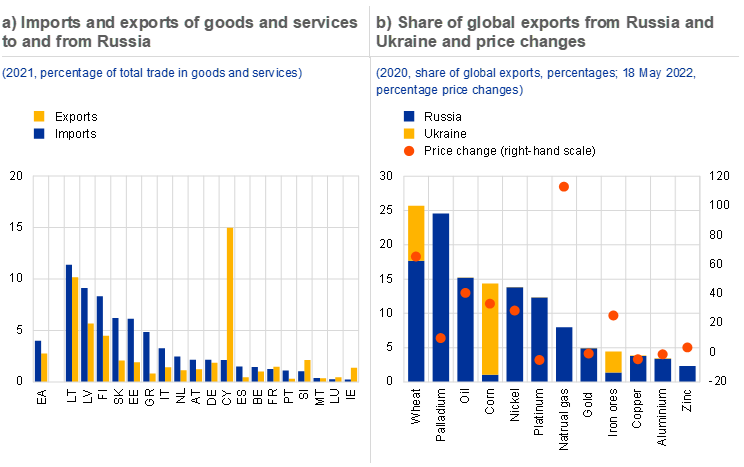
Sources: Bloomberg Finance L.P., UN Comtrade database, Eurostat, ECB and ECB calculations.
Note: Panel b: price change is based on active future contracts quoted by Bloomberg.
The conflict in Ukraine has added to pre-existing global inflationary pressures as the war has increased the prices of food and non-food commodities. Prices have increased strongly in those commodities of which Russia and Ukraine are major global exporters (Chart 1.2, panel b). Moreover, the sharp rise in commodity prices observed since the start of the conflict is adding to pre-existing inflationary pressures in commodities used in the extraction or processing of other commodities (e.g. steel, aluminium) and potash used to produce fertilisers and metals. Spiralling commodity prices are posing particular difficulties for importing emerging market economies. Moreover, emerging markets, such as India, Turkey, Mexico and developing CEE countries, may experience significant rises in headline figures on the back of the weighting of commodities in their consumption baskets. Added to these concerns is the prospect of global monetary tightening and associated spillovers, which could have a negative effect on debt sustainability in emerging markets (Chapter 2).
Supply chain bottlenecks continue to weigh on the global recovery and may intensify. Global supply chains have been under pressure since late 2020 on account of strong demand for manufactured goods, shortages in the supply of certain key inputs and disruptions in the logistics industry. As a result, suppliers’ delivery times in the euro area have lengthened considerably over the past year and have contributed to significantly higher input prices (Chart 1.3, panel a). Going forward, some supply chains are also likely to be affected by the war in Ukraine, given the significant role, among others, played by both Russia and Ukraine in global metal exports, among others (Chart 1.2, panel b). In addition, China’s zero-COVID policy has resulted in strict lockdowns being imposed in several economic centres, further disrupting the supply of certain goods. Moreover, although the euro area Purchasing Managers’ Index (PMI) remains comfortably in expansionary territory (55.8 in April 2022), disruptions continue to weigh on the business cycle, delaying the (global) recovery from the pandemic (Chart 1.3, panel b).
Chart 1.3
Supply chain disruptions increase input prices and depress the economic recovery
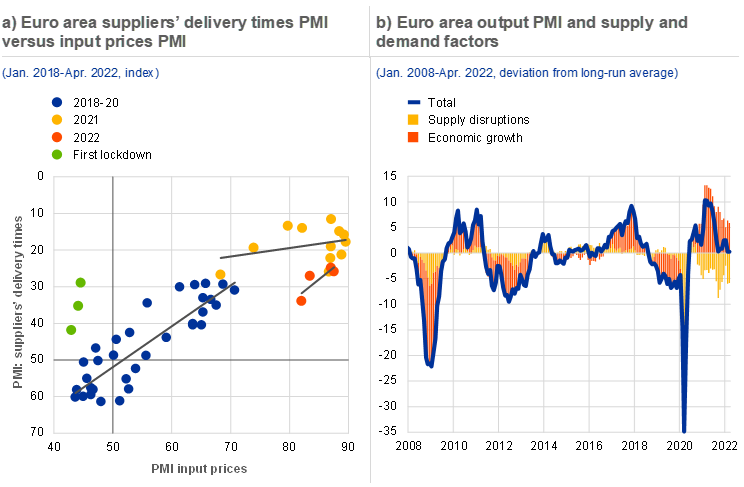
Sources: IHS Markit, ECB and ECB calculations.
Notes: Panel a: suppliers’ delivery times shown on an inverted scale; a lower reading indicates longer supplier delivery times. First lockdown refers to the period between March and May 2020. Panel b: historical decomposition of euro area output PMI, which was obtained using a two-variable Bayesian VAR with output PMI and suppliers’ delivery times component of PMI, identified through sign restrictions and estimated over the period from January 1999 to April 2022. See also the box entitled “Supply chain disruptions and the effects on the global economy”, Economic Bulletin, Issue 8, ECB, 2021. The identification strategy was inspired by Bhushan and Struyven*.
*) Bhushan, S. and Struyven, D., “Supply Chains, Global Growth, and Inflation”, Global Economics Analyst, Goldman Sachs Research, 20 September 2021.
The slowdown in the Chinese economy is adding to the vulnerabilities in emerging markets and is increasing the downside risks to the global recovery. The turmoil in China’s property development sector continued at the start of 2022, with growth in residential real estate sales remaining negative and house prices weakening further. In addition, strict pandemic containment policies are depressing economic activity, which is forecast to grow at around 5% annually in the period 2022-24, significantly below the long-term average of 8%. A slowing Chinese economy also poses additional challenges for emerging market economies with close financial links to China. All in all, these developments add further downside risks for global economic prospects, with a potentially significant spillover to the euro area (Box 4).
The new economic challenges come at a time when some sectors and countries are still recovering from the pandemic shock. Although high vaccination levels and the less deadly Omicron variant have allowed euro area economies to largely reopen since the start of the year, economic sectors continue to be affected asymmetrically by the pandemic. For example, activity in the arts and entertainment sector still lags pre-pandemic levels, while the technology sector has clearly benefited from the consumption trends observed during the pandemic (Chart 1.4, panel a). This sectoral fragmentation is also reflected in the economic recoveries of euro area countries. Some countries have only recently recovered from the pandemic but are currently facing high inflationary pressures (Chart 1.4, panel b). Moreover, depending on their degree of trade dependency with Russia and Ukraine, some euro area countries will be hit harder by the war in Ukraine than others, exacerbating asymmetries in growth and inflation rates.
Chart 1.4
While most euro area authorities have lifted major pandemic restrictions, some economic sectors and countries are still recovering
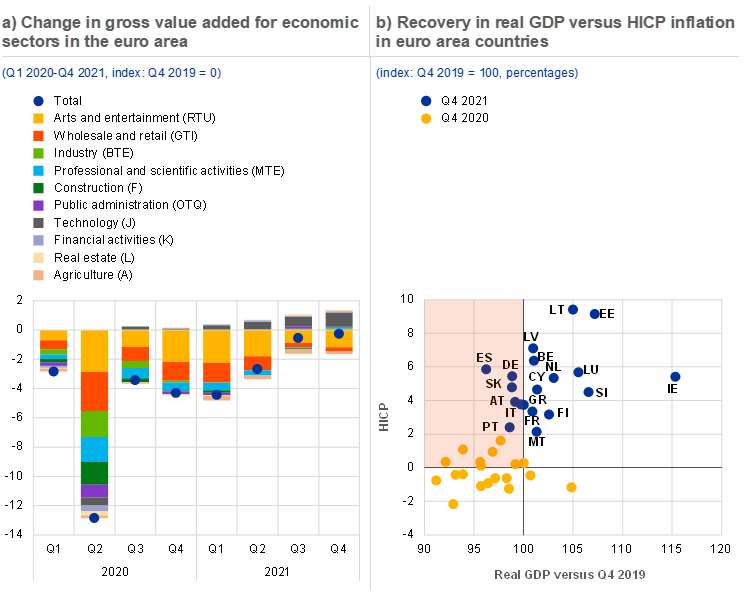
Sources: Eurostat and ECB calculations.
Notes: Panel a: capital letters reflect NACE codes; RTU = Arts, entertainment and recreation; other service activities; activities of household and extra-territorial organisations and bodies, GTI = Wholesale and retail trade, transport, accommodation and food service activities, BTE = Industry (except construction), MTE = Professional, scientific and technical activities; administrative and support service activities, F = Construction, OTQ = Public administration, defence, education, human health and social work activities, J = Information and communication, K = Financial and insurance activities, L = Real estate activities, A = Agriculture, forestry and fishing. Panel b: Q4 2019 reflects the pre-pandemic real GDP level.
1.2 Normalisation of fiscal positions is challenged by a slower economic recovery and the impact of the war
Downside risks to fiscal positions predominate as the recovery slows and governments cope with the economic impact of the Russia-Ukraine war. Before the war, it was expected that the euro area budget deficit would improve in response to lower discretionary spending on pandemic support measures, significant windfall revenues[1] and a lower cyclical component (Chart 1.5, panel a). However, fiscal assumptions and projections are currently surrounded by a high degree of uncertainty, given the implications of the war in Ukraine. Slower economic growth than previously anticipated will have a negative impact on deficits. In addition, governments will face increases in expenditure on account of several factors including measures to mitigate the impact of higher energy prices on households, the influx of refugees from Ukraine and the higher levels of defence spending announced by some euro area governments. This could result in a slightly lower cyclically adjusted primary balance in 2022 than previously anticipated (Chart 1.5, panel b).
Chart 1.5
Public finances could be challenged by a slower economic recovery, energy price support measures, refugee flows and increased defence spending
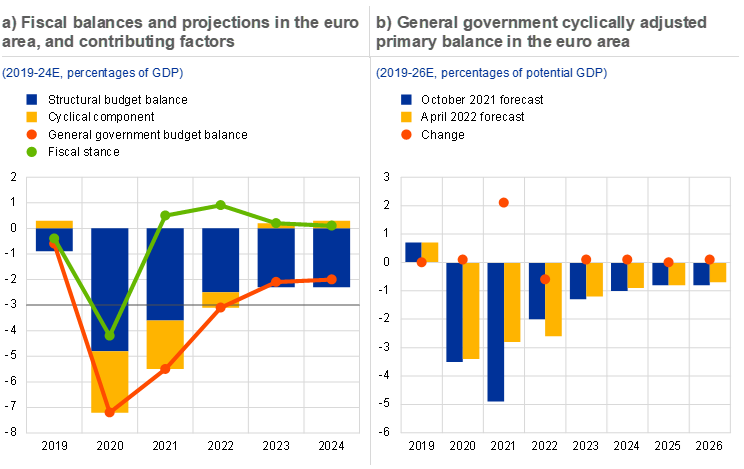
Sources: Eurostat, March 2022 and September 2021 ECB staff macroeconomic projections, IMF Fiscal Monitor and ECB calculations.
Notes: Panel a: the grey line depicts the 3% of GDP budget deficit threshold set in the Maastricht Treaty. The data refer to the aggregate general government sector of euro area countries. The fiscal stance is adjusted for the impact of Next Generation EU (NGEU) grants on the revenue side. The cyclical component refers to the impact of the economic cycle as well as temporary measures taken by governments, such as one-off revenues or one-off capital transfers. Panel b: the term “cyclically adjusted primary balance” is defined as the cyclically adjusted balance plus net interest payable/paid (interest expense minus interest revenue), following the IMF’s World Economic Outlook convention.
Higher than projected budget deficits and a slower economic recovery might make debt dynamics less favourable. Following the implementation of economic support measures of around 4.0% of GDP in 2020 in response to the pandemic, crisis and recovery spending is estimated to have increased to about 4.3% of GDP in 2021. Despite this sizeable fiscal support, the economic recovery and favourable financing conditions have helped to stabilise government debt-to-GDP ratios in euro area countries with higher or lower levels of debt, although debt levels continue to diverge widely between euro area countries (Chart 1.6, panel a). The projected improvement in the budget balance from 2022 onwards is expected to be driven by a higher cyclically adjusted primary balance, as many of the emergency measures not funded by NGEU grants will expire. As a result, euro area debt-to-GDP levels are projected to decline from 95.6% of GDP in 2021 to 88.7% in 2024. Going forward, however, risks to sovereign indebtedness are to the upside as governments face challenges from higher than anticipated deficits and slowing economic activity. As such, debt-to-GDP ratios might not follow the downward path currently envisaged under the baseline scenario (Overview).
Chart 1.6
Debt ratios have declined under favourable growth dynamics as sovereign stress has so far been contained
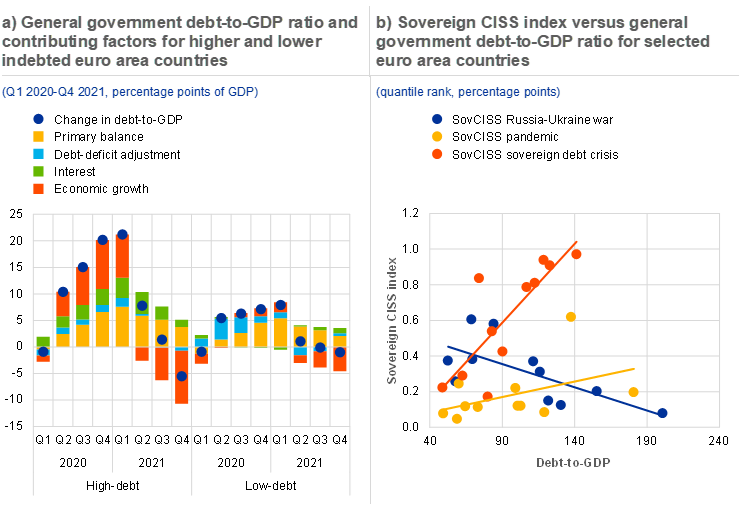
Sources: Eurostat, ECB and ECB calculations.
Notes: Panel a: the debt-deficit adjustment (DDA) captures the effects of the accumulation or sale of financial assets; see Kezbere and Maurer*. The aggregate of higher-debt countries includes euro area countries with a 2019 debt-to-GDP ratio above 90%. The lower-debt aggregate includes the remaining euro area countries. Figures are in nominal terms. Panel b: “sovereign debt crisis” refers to November 2011, “pandemic” refers to April 2020 and “Russia-Ukraine war” to April 2022. CISS stands for composite indicator of systemic stress. The chart shows the euro area countries for which a sovereign CISS Index is available, i.e. Belgium, Germany, Ireland, Greece, Spain, France, Italy, the Netherlands, Austria, Portugal and Finland.
*) Kezbere, L. and Maurer, H., “Deficit-debt adjustment (DDA) analysis: an analytical tool to assess the consistency of government finance statistics”, Statistics Paper Series, No 29, ECB, November 2018.
Higher than expected inflation can contribute to debt servicing pressures, especially in cases of high refinancing needs and relatively large shares of inflation-indexed securities. Although debt ratios would benefit from a declining real debt burden owing to first round effects (a favourable denominator effect), higher risk premia and slower economic growth could still contribute to increasing debt ratios in the medium term, particularly for high-debt countries.[2] As such, additional fiscal space to cushion the economy from future economic downturns might become more limited in some euro area countries. Moreover, the level of recovery from the pandemic and inflation rates diverge widely across euro area countries, contributing to higher fragmentation risks (Section 1.1).
Financing conditions for euro area sovereigns have remained favourable overall. Although government bond yields have increased of late, financing conditions have remained relatively favourable in recent months, despite the heightened uncertainty, increasing sovereign bond yields and deteriorating macroeconomic backdrop. Moreover, although measures of sovereign stress are rising, so far this has not affected higher-debt countries more than other euro area countries (Chart 1.6, panel b). In addition, governments had extended the average residual maturity to eight years by the end of March 2022, mostly by issuing longer-term securities, increasing their resilience to rising interest rates. At the same time, debt servicing needs remain elevated, with some euro area countries facing refinancing and interest expenditure in excess of 40% of GDP over the next two years. As such, a further deterioration in financial conditions could weigh on fiscal positions going forward.
All in all, risks to sovereign debt sustainability appear to be manageable in the short run, but sovereign risks could intensify in the event of a sustained rise in credit risk premia or more subdued growth outturns. Although sovereign yields have increased of late, the economic recovery at the end of 2021 and largely favourable financing conditions have helped to stabilise debt levels in the euro area. Going forward, fiscal policy will be affected by both exposure to the war and recovery from the pandemic. Moreover, the fundamental role of economic growth dynamics in determining fiscal sustainability underlines the need for fiscal policy to be growth-friendly. The NGEU package could provide additional cushioning for the euro area economy and trigger the kind of reforms required to boost long-term growth potential. Adding to sovereign risks, some sovereigns with higher debt are also exposed to weaker banks and exhibit a less robust, more fragmentated corporate landscape, increasing risks relating to a sovereign-bank-corporate nexus (Box 1). These adverse developments could trigger a reassessment of sovereign risk by market participants and reignite pressures on more vulnerable sovereigns.
1.3 Corporates face new headwinds as supply bottlenecks persist
Following the solid recovery seen in the second half of 2021, euro area corporates are now facing increasing headwinds from rising producer prices and supply chain pressures. Measures of aggregate corporate vulnerabilities improved as the economy experienced a robust recovery in the second half of 2021, with gross profits bouncing back to 7% above pre-pandemic levels. Moreover, the economic recovery and pandemic support measures have helped to keep financing conditions favourable, cushioning debt service needs and rollover risks. As a result, the composite indicator for euro area corporate vulnerabilities has remained well below its historical average (Chart 1.7, panel a). However, corporates now face new headwinds stemming from a slowing economy, higher interest rates, worsening supply chain bottlenecks and rising energy prices (Section 1.1).
Chart 1.7
Euro area non-financial corporates have benefited from favourable financing conditions and robust profits, but activity remains subdued

Sources: Eurostat, ECB, IHS Markit and ECB calculations.
Notes: Panel a: positive values indicate higher vulnerability and negative values indicate lower vulnerability. The shaded area represents a forecast. For the construction of the index in more detail, see the box entitled “Assessing corporate vulnerabilities in the euro area”, Financial Stability Review, ECB, November 2020. Panel b: total assets are the sum of total financial and non-financial assets (liabilities) of non-financial corporations. Sales and earnings before interest and taxes (EBIT) are approximated by the four-quarter moving average of gross value added and mixed income respectively, as reported in the quarterly sector accounts. Series multiplied by 100.
The sharp increase in input prices may squeeze corporate profit margins. Despite the robust recovery in corporate earnings, activity in the corporate sector remained subdued towards the end of 2021 (Chart 1.7, panels a and b). Moreover, corporate profitability partially recovered on account of higher profit margins, offsetting the more persistent loss in output since the start of the pandemic (Chart 1.7, panel b). Going forward, it might become harder for some sectors to sustain high profit margins as input prices soar in many sectors and the economy slows. Higher input prices currently translate into expectations of increased selling prices going forward, especially for sectors with high energy consumption and low inventories (Chart 1.8, panel a). At the same time, some firms have started to indicate that input prices are increasing faster than output prices, possibly resulting in margin compression. This seems to be the case for the corporates that still face challenges stemming from the pandemic and for corporates with high energy needs, such as manufacturers of metals (Chart 1.8, panel b). Historically, higher input prices are largely passed on to end users, particularly when the cost-push shock is global, although given the fact that the economic outlook has softened considerably some producers might have less pricing power going forward. Moreover, the magnitude of current price volatility could be a concern for companies with (unhedged) fixed contractual obligations, and which cannot easily adjust pricing, such as utilities and construction firms (Chapter 2).
Chart 1.8
Margins might come under pressure as input prices soar and the economy slows
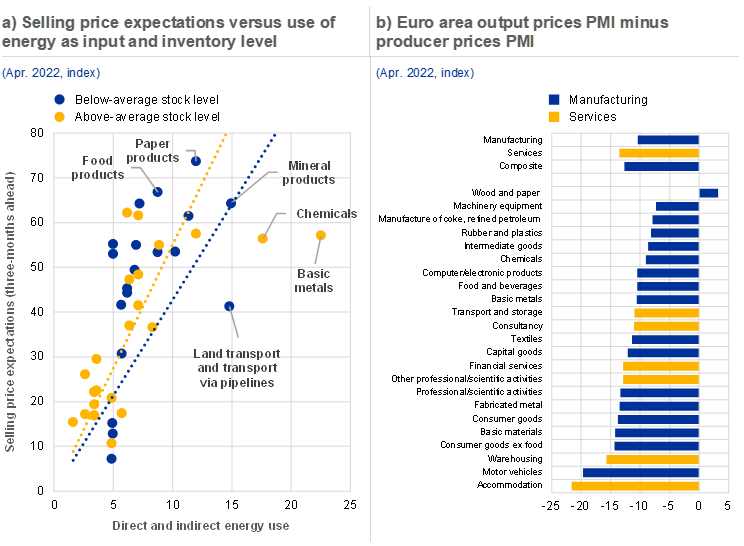
Sources: OECD Trade in Value Added (TiVA) database (2018), European Commission, Eurostat, IHS Markit and ECB calculations.
Notes: Panel a: energy intensity measured is measured by the average share of input from mining and quarrying, energy producing products, coke and refined petroleum product and the electricity, gas, steam and air-conditioning industries for each sector, classified according to the United Nations International Standard Industrial Classification for All Economic Activities (ISIC), Rev. 4. Rev. 4. ISIC codes are converted back to NACE codes and matched with survey data on selling price expectations. Selling price expectations reflect seasonally adjusted selling price expectations for the services, retail and industry sectors. The data are extracted on subsector level from the European Commission business and consumer surveys. Direct and indirect energy use reflect 2018 figures. Selling price expectations reflect expectations from the April 2022 European Commission Business and consumer surveys. Panel b: shown as the PMI output price index minus the producer prices PMI on sector level. A narrowing spread between output and producer prices PMIs can be interpreted as margin compression.
External financing needs have risen in response to robust economic activity, but the economic impact of the war in Ukraine might dampen credit growth going forward. Bank lending to corporates continued to increase in the first months of 2022, but moderated in March as credit standards tightened, and risk perceptions increased as a result of the war in Ukraine. During the first months of the year the demand for loans remained high on account of high working capital and fixed investment requirements. The need for higher working capital mainly reflects financing demands created by the pandemic situation, while the increase in fixed investment is driven by the economic recovery. Amid a wide range across firms and euro area countries, debt levels declined to 80% of GDP in the fourth quarter of 2021 but remained above the 75% of GDP recorded before the pandemic.[3] The increase in net debt has been much less pronounced, reflecting elevated working capital levels and liquid holdings (Chart 1.9, panel a). Going forward, corporate financing conditions might deteriorate when economic growth slows, inflation remains elevated and both markets and banks reassess the risk surrounding corporate activity (Chapter 2). Moreover, banks anticipate a stronger net tightening of credit standards in the future, reflecting the uncertain economic impact of the war. This might be particularly concerning for firms that exited the pandemic with high debt levels, subdued earnings and lower liquidity buffers (Chart 1.9, panel b, and Box 1).
Chart 1.9
The increase in debt levels has varied across firms and euro area countries as default rates might rise

Sources: Bank for International Settlements, Bloomberg Finance L.P., Moody’s Analytics, ECB and Eurostat.
Notes: Panel a: “Liquid assets” comprises currency and deposits; “Gross debt” refers to consolidated debt securities and loans of non-financial corporations; “Net debt” is the difference between gross debt and liquid assets. The debt service ratio (DSR) is defined as the ratio of interest payments plus amortisations to income. As such, the DSR provides a flow-to-flow comparison – the flow of debt service payments divided by the flow of income; see “How much income is used for debt payments? A new database for debt service ratios”, BIS Quarterly Review, September 2015. Panel b: earnings per share reflect Bloomberg consensus estimates for the sector level sub-indices of the STOXX EUROPE index. The total debt and current ratio are sub-index averages. The current ratio reflects the ratio of current assets to current liabilities and measures a firm’s ability to settle short-term liabilities with its short-term assets.
Insolvencies, which would normally be expected to rise as economic growth softens, have remained well below their pre-pandemic levels. Policy support measures have successfully mitigated solvency risks which, together with robust economic growth, kept insolvencies 20% below their pre-pandemic levels in the first quarter of 2022. Moreover, forward-looking measures for defaults remain subdued (Chart 1.9, panel c). At the same time, firms whose balance sheets weakened by the pandemic now face fresh challenges from strong input price inflation, softening economic growth and rising interest rates. Furthermore, results from the latest ECB bank lending survey show banks indicating that they are concerned that supply chain disruptions, high energy and other input prices, and corporate exposures to Russia, Ukraine and Belarus might amplify firms’ credit risks. As such, insolvencies could rise in the sectors most affected by supply chain disruptions and by an economic recovery that has proved fragile since the pandemic.
Overall, firms weakened by the pandemic now face additional challenges from intensifying cost pressures as the economic recovery slows. Some countries and sectors have experienced an increase in net debt levels since the start of the pandemic. Moreover, some corporates will also face significant debt servicing needs over the coming years (Chart 1.9, panel a). Although public guarantee schemes have helped corporates to attract longer-term funding during the pandemic and corporates have built significant cash buffers, a possible further rise in interest rates might impact non-financial corporations that borrow at variable rates. In addition, some firms have been less able to profit from the economic recovery over recent quarters as their business models have continued to be affected by pandemic containment measures. Some of these corporations also have higher debt, lower liquidity and lower sales levels and might face challenges when the economy slows or if they cannot pass on increases in input prices to end users in full (Box 1). Adding further to these vulnerabilities, weaker corporates are also concentrated in countries with greater sovereign and bank vulnerabilities.
Box 1
Identifying the corporates most vulnerable to price shocks following the pandemic
By the end of 2021, the aggregate profitability and debt positions of euro area non-financial corporations (NFCs) had recovered to pre-pandemic levels. While overall gross debt relative to gross value added remains elevated at around 160%, net debt has returned to its pre-pandemic level of around 100% of gross value added, with firms having increased precautionary cash buffers amid favourable financing conditions. However, these aggregate developments were mostly driven by large firms, while the net debt positions of small firms increased as they used credit to offset those cash flow losses that were not covered by government support measures. In addition, many corporates now face broad-based increases in input prices on the back of energy price rises and supply chain disruptions. Against this backdrop, this box uses firm-level balance sheet data for around 91,000 euro area non-financial corporations to identify vulnerable firms based on the Altman Z-score, a measure of insolvency risk that uses five balance sheet and income statement ratios and their joint importance.[4], [5], [6] It then matches bank and sovereign exposures to consider related risks associated with the sovereign-bank-corporate nexus.
1.4 Households face rising inflation and greater uncertainty
While the aggregate financial position of euro area households has remained stable, downside risks have increased in the light of higher inflation and the war in Ukraine. Throughout the second half of 2021, households benefited from the economic recovery, low unemployment and favourable financing conditions. The debt-to-disposable income ratio stabilised at 98%, as nominal income growth remained solid and debt servicing costs reached record lows (Chart 1.10, panel a). Supported by valuation gains in financial investments and house prices, households’ net worth surged to 785% of disposable income in the fourth quarter of 2021, up 26 percentage points on a year earlier, but remains unevenly distributed across households. At the same time, however, consumer sentiment became clouded by the pick-up in consumer prices and, when energy and food prices rose further following the Russian invasion of Ukraine, plunged back towards the low levels observed after the pandemic first broke out in Europe (Chart 1.10, panel b). In a tail risk scenario, the war may also indirectly affect households via labour markets, where conditions could deteriorate if a large number of firms fail to withstand the adverse effects of higher input prices and supply chain disruptions reinforced by sanctions on Russia.
Chart 1.10
Household debt levels remain contained, but rising inflation and the war in Ukraine have prompted a sharp deterioration in sentiment
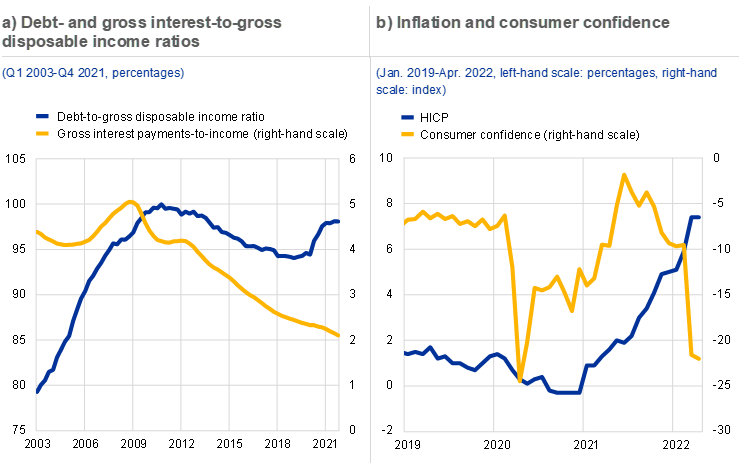
Sources: Eurostat and ECB calculations.
Notes: Panel a: debt is defined as total loans granted to households by all institutional sectors. Gross interest payments are measured before allocation of financial intermediation services indirectly measured (FISIM). Panel b: HICP stands for the Harmonised Index of Consumer Prices measure of inflation.
Inflation weighs on real household incomes and may have a disproportionate effect on both lower-income households and those with weaker debt servicing capacity. Nominal income growth returned to pre-pandemic levels in the fourth quarter of 2021. However, due to increases in consumer prices driven predominantly by energy and food items, real incomes shrunk in the same period (Chart 1.11, panel a). Many households may be able to temporarily cushion the impact of higher prices by scaling back saving or drawing on excess savings accumulated during the pandemic. But these savings are likely concentrated in higher-income households, whereas lower-income households are more exposed to the inflation shock as they spend a relatively larger share of their income on energy and food-related items (Chart 1.11, panel b). Accordingly, a share of households has to rely on fiscal relief measures or cut down on non-essential consumption. In general, some households may benefit from higher than expected inflation in the sense that it lowers the real cost of pre-existing debt, but it is unlikely that these households are sufficiently compensated for the rise in inflation through higher nominal income.
Chart 1.11
A decline in real incomes may disproportionately affect lower income households
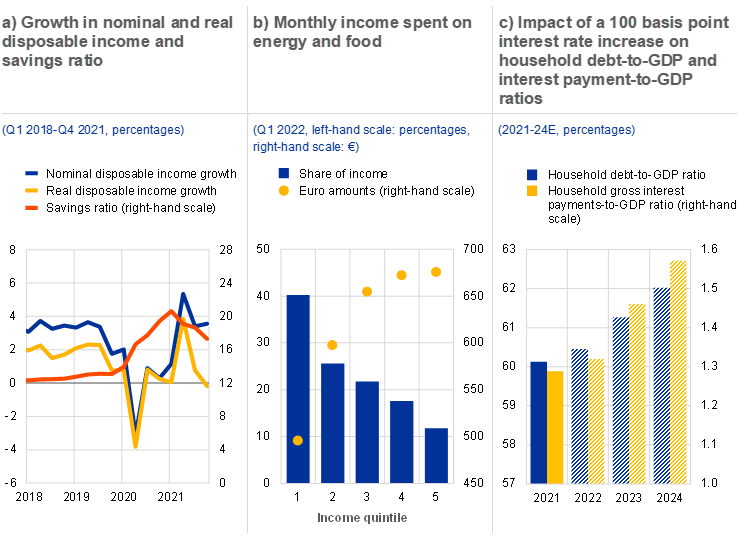
Sources: Eurostat, ECB (Consumer Expectations Survey) and ECB calculations.
Notes: Panel b: data cover surveys from Belgium, Germany, Spain, France, Italy and the Netherlands. The share of income spent on energy and food is calculated as the share of households’ reported spending on utilities, transport and food, beverages, groceries and tobacco divided by monthly income, where income is inferred from income buckets. Data shown are averages over the full period for which CES data are available, i.e. April 2020 to January 2022. Questions on spending are surveyed once per quarter. Accordingly, the data should be interpreted with caution and mainly as an illustration of differences across different income classes. Panel c: shaded bars show projections. The simulations capture the effects of a permanent one-off 100 basis point increase in short and long-term market interest rates in July 2022 (with higher rates kept constant thereafter) on gross interest payments (based on a national accounts concept before FISIM allocation) and consolidated gross indebtedness ½, 1½ and 2½ years after the shock. The results are based on models and tools used in the context of the Eurosystem projection exercises. They take into account the dampening impact of higher market interest rates on economic activity, prices and debt financing. The increase in the household debt-to-GDP ratio is mostly due to a denominator effect as GDP is projected to decline more than debt levels.
Vulnerabilities among households have picked up, albeit from generally moderate levels. With strong balance sheets thanks to excess savings, solid net wealth and low debt servicing costs, households are well positioned to weather economic headwinds. At the same time, rising inflation is having an adverse effect on households’ purchasing power, which could slow the economy’s return to its pre-pandemic growth path. Some households may have to limit consumption or become dependent on government support. While the impact of rising interest rates on aggregate household indebtedness and interest payments may be limited (Chart 1.11, panel c), some households’ debt servicing capacity could suffer. Vulnerabilities could build further over the medium term and concerns over household debt sustainability may rise, especially in countries where residential properties are overvalued, debt levels are elevated and a larger share of household debt has variable interest rates.
1.5 Vulnerabilities continue to build in euro area real estate markets
Prices in euro area residential real estate (RRE) markets rose at a record pace, resulting in increasingly stretched valuations. Nominal house prices rose by 9.6% year-on-year at the euro area level in the fourth quarter of 2021, the fastest rate observed in the last 20 years (Chart 6, panel a, Overview). The key factors putting upward pressure on prices are the low cost of borrowing coupled with stronger demand for housing stemming from shifts in household preferences (e.g. demand for home office space) and supply-side constraints. Shortages of both labour and materials are raising expectations of increasing prices in the construction sector, contributing to further upward pressure on house prices going forward. Such growing supply-side constraints, together with flight-to-safety effects amid higher inflation, may be exacerbated by the war in Ukraine. As house price dynamics exceed the fundamentals, estimates of overvaluation are also growing (Chart 1.12, panel a).
Accelerating mortgage lending has increased household indebtedness, raising concerns of further debt-fuelled house price rises. Lending for house purchase in the euro area remains robust, with the pace of growth at 5.4% in March 2022, contributing to the build-up of household debt. Patterns vary greatly from country to country: in some euro area countries, upward movements in both house prices and lending are pronounced, indicating that a price-loan spiral may have started emerging. Overall, while most euro area countries have macroprudential measures in place, a further build-up of medium-term vulnerabilities in some countries led the ESRB to issue new warnings and recommendations in December 2021 (Chart 1.12, panel b).[7] This strengthens the case for considering further macroprudential policy measures to build resilience, as economic conditions allow and taking into account the uncertainty related to the war (Chapter 5).
Chart 1.12
Rising RRE prices result in increasingly stretched valuations, underpinned in some countries by buoyant lending growth

Sources: ECB, Eurostat, European Systemic Risk Board (ESRB) and ECB calculations.
Notes: Panel a: the average valuation estimate is the simple average of the price-to-income ratio and an estimated Bayesian vector autoregression (BVAR) model. For details of the methodology, see Box 3 in the Financial Stability Review, ECB, June 2011, and Box 3 in the Financial Stability Review, ECB, November 2015. Overall, estimates from the valuation models are subject to considerable uncertainty and should be interpreted with caution. Alternative valuation measures can point to lower/higher estimates of overvaluation. Whiskers denote minimum and maximum values. For Belgium, Ireland, Finland and Austria the last observation is from Q3 2021. Panel b: latest available data are shown, RRE price growth and household debt-to-GDP ratio refer to Q4 2021 and mortgage lending growth refers to Q1 2022. Horizontal and vertical red lines indicate the euro area aggregate. The bubble size indicates the size of the household debt-to-GDP ratio.
Conditions in commercial real estate (CRE) markets appear to be stabilising, and markets have initially not priced in a major impact from the war in Ukraine. After suffering a tangible decline during the pandemic, price growth dynamics for prime CRE are beginning to stabilise (Chart 1.13, panel a). However, prime segments account for only a relatively small share of CRE markets. Conditions remain challenging in non-prime markets due to environmental, social and governance (ESG) concerns and changed patterns of behaviour in the wake of the pandemic. Comparing initial REIT price reactions with those in wider equity markets after the outbreak of the war in Ukraine suggests that investors see real estate as a sector less affected by the war (Chart 1.13, panel b). Nevertheless, demand for CRE assets would be affected by any economic downturn resulting from the war. A pronounced correction in CRE markets could have an adverse effect on the wider financial system and the real economy. This is because financial institutions may suffer from direct losses, increased credit risk and declines in collateral values, which could limit their ability to provide financing to non-financial corporations and may be exacerbated through negative feedback loops.
Chart 1.13
Conditions in commercial real estate markets appear to be stabilising as the initial impact of the war in Ukraine appears limited
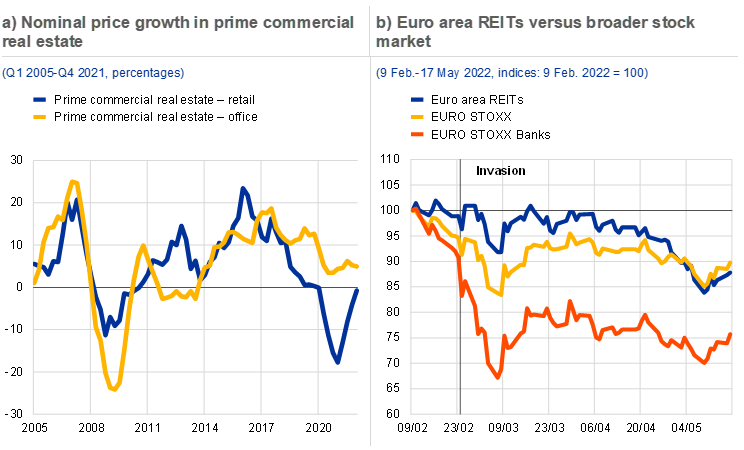
Sources: Jones Lang LaSalle, Bloomberg Finance L.P. and ECB calculations.
Notes: Panel b: 9 February 2022 corresponds to the peak of the EURO STOXX index before the invasion of Ukraine. REITs stands for real estate investment trusts. The FTSE EPRA Nareit Eurozone Index is shown here.
Uncertainty in real estate markets is rising as different factors put upward pressure on prices simultaneously while also increasing the risk of a price correction. RRE prices have continued to benefit from tight supply conditions and stable household and investor demand for housing. Over the medium term, this continued expansion and signs of overvaluation render some RRE markets prone to a correction. At the same time, an abrupt increase in real interest rates could induce house price corrections in the near term, with the current low level of interest rates making substantial house price reversals more likely (Box 2). In CRE markets, low-quality segments are under pressure from structural demand shifts. While resilience is supported by macroprudential measures and relative household strength (Section 1.4), the financial sector may be exposed to the risk of real estate market corrections, especially in those countries where debt levels are elevated, exposures are high and properties are overvalued.
Box 2
Drivers of rising house prices and the risk of reversal
House prices increased substantially during the pandemic, fuelling concerns about possible price reversals and their implications for financial stability. In many advanced economies, real house price growth exceeded 4% during the pandemic (Chart A, panel a), reaching 4.3% in the euro area in the fourth quarter of 2021[8] amid signs of exuberance in some countries.[9] At the same time, real mortgage lending rates in the euro area have fallen further to reach historic lows in the current low interest rate environment (Chart A, panel b).[10] Against this backdrop, this box discusses the main drivers of recent house price increases across advanced economies and in the euro area, and the associated risks of possible price reversals and the potential implications for financial stability.
2 Financial markets

2.1 War exacerbates existing trends of higher energy prices and higher inflation
The Russian invasion of Ukraine triggered a moderate, short-lived “risk-off” market reaction, during which market functioning remained largely orderly. In the immediate aftermath of the invasion, volatility increased (Chart 2.1, panel a), credit spreads widened, euro area equity indices fell (Chart 2.2, panel a) and government bond yields declined. Compared with the March 2020 market turmoil following the outbreak of the coronavirus (COVID-19) pandemic, the initial market reaction to the invasion was relatively mild. Despite the profound medium and long-term implications of the war, as discussed in detail below, this correction was followed by a relatively fast rebound. A significant further escalation, in economic and/or military terms, could still cause renewed market stress. However, regardless of how the conflict evolves (e.g. a ceasefire agreement, prolonged entrenchment or further escalation), several medium-term consequences have crystallised, as discussed below. Notably, the war increases the risk of a higher-inflation, lower-growth scenario resulting from higher energy prices and supply chain disruptions (Chapter 1). The policy response to higher inflation and concerns about the global growth outlook have contributed to renewed weakness in financial markets during the second quarter of 2022.
Chart 2.1
The initial risk-off market reaction to the invasion was temporary and limited, but energy prices are expected to be higher for longer and the upward trend in inflation swap rates accelerated after the invasion
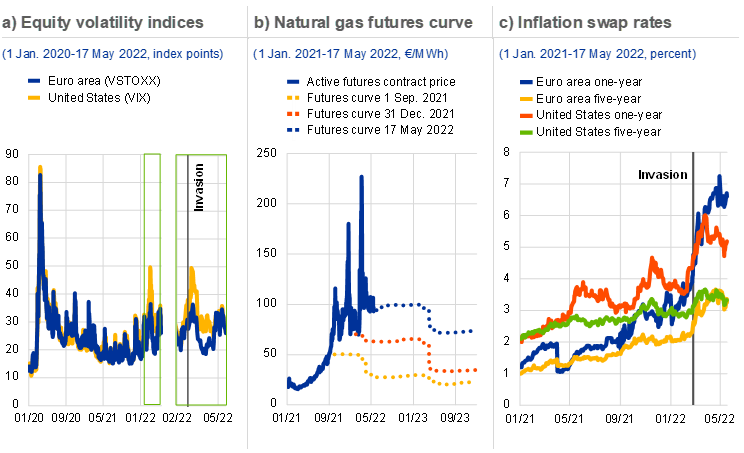
Sources: Bloomberg Finance L.P., Refinitiv and ECB calculations.
Notes: Panel b: futures curves are based on futures contracts for different delivery dates. The active futures contract price refers to the futures contract that matures in the next month. Futures contracts are traded on the Intercontinental Exchange (ICE) and linked to Dutch TTF natural gas. Panel c: inflation swap rates refer to the fixed rate at which contracts are opened, whereby the floating leg, with annual payments over the duration of the contract, is tied to an inflation index. Inflation swap rates do not purely reflect inflation expectations, as they also include a risk premium.
Commodity futures prices suggest that energy prices will remain higher for longer. Energy prices had already increased markedly before the start of the war in Ukraine: tensions had already risen in the second half of 2021, with strong demand for commodities as economies recovered from the pandemic. For example, the average natural gas price in the fourth quarter of 2021 was 550% higher than in the same quarter of 2020. As the conflict escalated, increases were not limited to spot prices. The natural gas forward curve now points to elevated prices up to and including the winter of 2023 (Chart 2.1, panel b).
The upward trend in inflation swap rates accelerated after the invasion was launched. Inflation swap rates surged, driven in part by rising energy prices (Chart 2.1, panel c). The euro area one-year inflation swap rate currently stands at around 6.6%,[11] its highest level since the introduction of the euro, up from around 3.4% at the end of 2021. The implications of higher than expected inflation are discussed from a conceptual point of view in Box 3, while empirically observed consequences for financial markets are discussed in this chapter.
Chart 2.2
A divergence between the United States and the more energy import-dependent euro area emerged after the start of the invasion of Ukraine
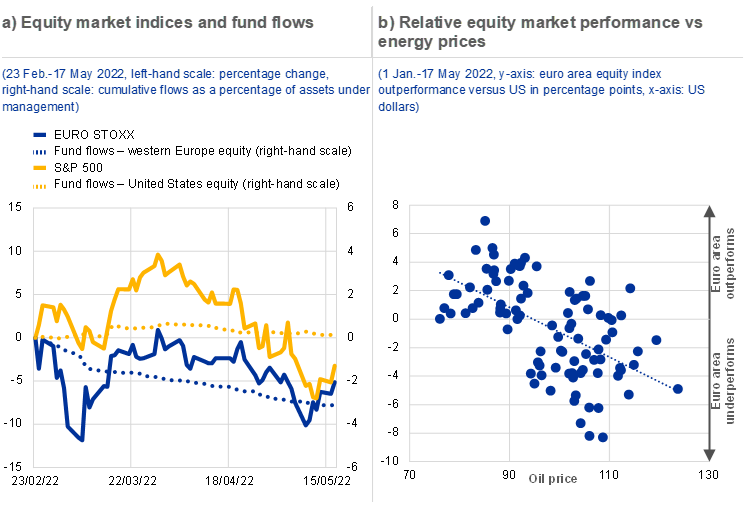
Sources: Bloomberg Finance L.P., EPFR Global, Refinitiv and ECB calculations.
Notes: Panel a: percentage change since 23 February 2022, fund flows as a share of assets under management. Western Europe equity refers to funds that invest in developed European markets, namely Austria, Belgium, Denmark, Finland, France, Germany, Greece, Italy, Ireland, the Netherlands, Norway, Portugal, Spain, Sweden, Switzerland and the United Kingdom. Panel b: daily data on relative performance in terms of the EURO STOXX price change versus the S&P 500 price change, as of 1 January 2022, mapped against the oil price in US dollars. The result is not driven by differences in the shares of the oil and gas sector between the indices.
Euro area equity markets experienced a relatively weak recovery during the first weeks after the invasion, as compared with US markets. While the EURO STOXX index had just returned to pre-invasion levels by the end of March, the S&P 500 index had already posted a 10% gain (Chart 2.2, panel a). Prior to the invasion, global fund managers were positive on European equities,[12] but this sentiment shifted with the start of the war, as evidenced by the outflows from funds with a focus on western European equities (Chart 2.2, panel a). The euro area’s high level of dependence on energy imports may explain much of this divergence: energy prices are correlated with performance differentials between US and euro area equities (Chart 2.2, panel b). At the same time, other factors also impact this differential, especially in April and May. Notably, more recent underperformance in US equity markets may be seen in the context of a repricing in bond markets consistent with a faster expected pace of US monetary policy normalisation.
Following the invasion, pre-existing emerging market underperformance was magnified by an increase in food and energy prices, along with a number of idiosyncratic factors (Chart 2.3). Equity indices covering eastern European countries fell by more than their western European peers and have not recovered to pre-invasion levels. This underperformance may be explained by these countries’ closer proximity to the conflict and stronger trade links with Russia. Some emerging markets (currencies and/or hard currency debt) may also experience pressures from US dollar strengthening. China has also underperformed in debt and equity markets (Chart 2.3), but for more idiosyncratic reasons. Its zero-COVID strategy and regulatory tightening (Chapter 1) have contributed to a further deterioration in conditions in the offshore dollar-denominated high-yield bond market, with spillovers to offshore investment-grade bonds (Chart 2.3, panel a). At the same time, the onshore renminbi-denominated bond market remains resilient. If these financial stresses were to intensify, it could affect developed markets through the global demand channel; the risk of direct spillovers to financial markets outside China is smaller (Box 4).
Chart 2.3
Emerging markets continue to show weakness, led by China
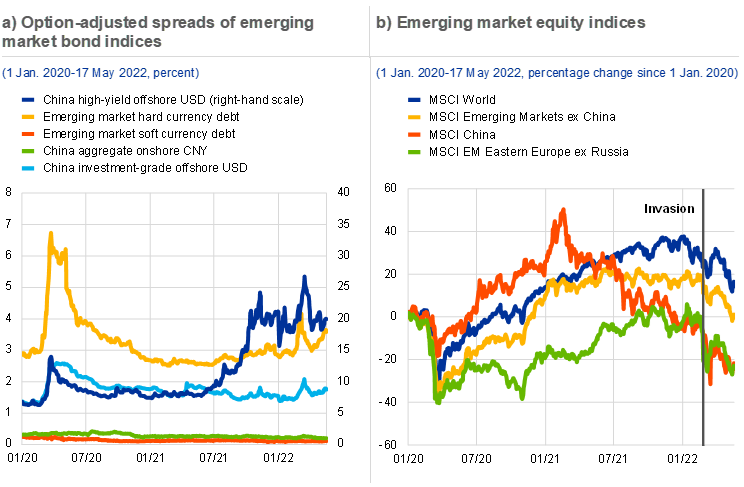
Sources: Bloomberg Finance L.P., Refinitiv and ECB calculations.
Note: Panel a: the emerging market hard currency debt index includes USD-, EUR- and GBP-denominated debt from sovereign, quasi-sovereign and corporate issuers.
2.2 Market sensitivity to pace of policy normalisation
Historically, episodes of (anticipated) monetary policy adjustment have been associated with elevated volatility. This section describes how recent market repricing is consistent with changing expectations around the pace of monetary policy normalisation. It also discusses the associated risks of financial fragmentation and a disorderly correction in markets for risky assets.[13]
In recent months, central banks around the world have moved towards reducing net asset purchases and signalled a tighter monetary policy stance ahead. Notably, the Federal Reserve System ended its net asset purchases as of March, while the ECB terminated its net purchases under the pandemic emergency purchase programme (PEPP) at the same time. In addition, the ECB’s Governing Council has stated that incoming data have reinforced its expectation for net asset purchases under the asset purchase programme (APP) to be concluded in the third quarter of 2022. This would mark an end to the rapid expansion of central bank balance sheets in response to the COVID-19 crisis (Chart 2.4, panel a). During that period, firms and governments benefited from favourable financing conditions supported by central bank purchases (Chart 2.4, panel b).
Chart 2.4
Firms and sovereigns face changing market conditions as central bank purchases are reduced
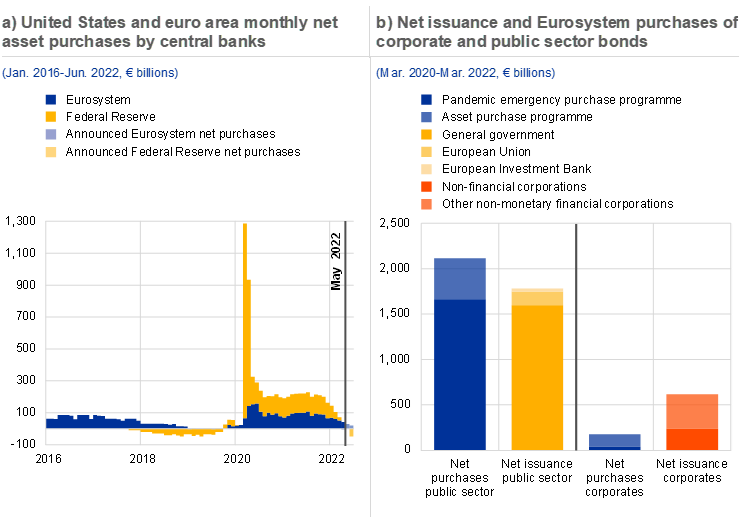
Sources: Bloomberg Finance L.P., ECB and Federal Reserve System.
Notes: Panel a: net asset purchases by the Federal Reserve shown include only those under System Open Market Account (SOMA) treasury transactions and SOMA agency MBS transactions; net asset purchases under the Eurosystem include those under the APP and PEPP. Net purchases are negative when monthly redemptions surpass gross purchases. Panel b: net issuance of debt securities by euro area public sector and corporate entities. The general government category is as defined in the European System of Accounts (ESA 2010).
Markets have repriced for a faster pace of policy normalisation in both the euro area and the United States, compared with 2021. Pricing for interest rate derivatives suggests that market participants now foresee more imminent policy rate hikes than previously (Chart 2.5, panel a).[14] Interest rates rebounded from a brief decline immediately after the invasion and continued their climb in subsequent weeks as market participants considered it increasingly likely that central banks would move faster towards monetary policy normalisation in response to inflationary pressures (Chart 2.5, panel b).
Differences in the pace of policy adjustment can lead to a spillover of risks from the United States to the euro area. Higher US yields may affect global capital flows and thereby indirectly affect euro area yields. In addition, elevated volatility in US markets can spill over to euro area markets and lead to a deterioration in risk sentiment.[15]
Chart 2.5
Markets are pricing in a faster pace of monetary policy tightening than previously

Sources: Bloomberg Finance L.P. and ECB calculations.
Notes: Panel a: EURIBOR futures curves are based on contracts traded on the Intercontinental Exchange (ICE) based on the underlying three-month EURIBOR. Panel b: real yields are shown as the nominal German government bond yield less the break-even inflation rate.
Volatility and uncertainty in interest rate and government bond markets, as well as potential upward pressure on real rates, could challenge risky asset valuations. Markets, already priced for faster increases in short-term rates (Chart 2.5, panel a), have become increasingly sensitive to information that could – as seen through the lens of market participants – affect the pace of policy normalisation. As inflationary pressures built over the course of 2021, implied volatility in euro area government bond markets increased, as did uncertainty[16] with regard to future short-term interest rates (Chart 2.6, panel a). In addition, there is now the potential for real interest rate rises after years of declines (Chart 2.5, panel b). All else equal, increases in both nominal and real rates are typically associated with investor de-risking, and may lead to pressures on valuations of risky assets such as equities. A theoretical exercise, with cyclically adjusted earnings and equity risk premia[17] held constant, shows that equity valuations could decline significantly for given, relatively limited increases in longer-term, risk-free real interest rates (Chart 2.6, panel b). Nevertheless, (euro area) real risk-free rates remain in negative territory. In addition, equities are also considered to have some inflation hedging properties, which can support valuations in the current inflation environment.
The first half of 2022 saw a sizeable market correction especially in higher-duration equities and more speculative asset classes. As set out in the November 2021 Financial Stability Review (FSR), equity markets have become increasingly sensitive to interest rate increases in recent years. As rates increased sharply since November 2021, higher duration equities, such as those in the technology sector, underperformed.[18] Market volatility also expanded into crypto-asset markets. Bitcoin lost 50% of its value (versus the US dollar),[19] and stresses emerged in markets for stablecoins.[20] While a number of stablecoins lost their peg against the US dollar, broader financial stability risks remain limited. At the same time, the implications of stresses on stablecoin Tether could be significant for the crypto-asset ecosystem. A failure of Tether may pose a threat to the stability of crypto-asset markets, as it provides a substantial amount of trading liquidity for buying and selling of other crypto-assets.[21] A run on Tether could disrupt trading and price discovery in crypto-asset markets, which could turn disorderly. Contagion effects for the broader financial system arising from a potential “crypto crash” still seem limited (Special Feature B), although individual investors may suffer significant losses.
Chart 2.6
Volatility and upward pressure on real rates could challenge valuations of risky assets

Sources: Bloomberg Finance L.P., Refinitiv and ECB calculations.
Notes: Panel a: the Swaption Merrill Option Volatility Estimate (SMOVE) is a yield curve-weighted index of the normalised implied volatility on three-month swaptions. It is the weighted average of volatilities on 2-year, 5-year, 10-year and 30-year maturity swaps. Panel b: equity price movements are projected for different levels of real risk-free rates. The excess cyclically adjusted price/earnings yield over the risk-free rate (“equity risk premium”) is assumed to be constant and equal to its value as at 1 January 2022. Dots indicate historically realised price changes in the EURO STOXX index compared with 1 January 2022.
Rising interest rates could present challenges to highly indebted firms and governments. An increase in interest rates exposes borrowers to higher (re)financing costs. For more indebted firms and sovereigns, the impact of higher financing costs on earnings and budget deficits is mechanically larger. This implies that, all else equal, the debt sustainability of more indebted firms and governments may deteriorate relatively more rapidly than for less indebted firms and governments. This in turn can lead to higher credit and sovereign spreads and increasing financial fragmentation (Chart 2.7). At the same time, both firms and governments have extended the maturity of their debt in recent years, which might shield them from the higher marginal cost of funding to some extent.
Interest rate increases may entail risks, especially if underlying growth dynamics are muted. All else equal, a tighter monetary policy stance generally leads to increasing interest rates and an attenuation of (expected) growth. Consequently, monetary policy tightening can drive a wedge between interest rates and growth, and this can have consequences for debt sustainability (Box 3). At the same time, increases in market rates (the marginal cost of funding) only feed through into average interest rates paid slowly, as existing fixed-rate debt matures and new debt is issued. Issuers with relatively higher outstanding amounts of variable-rate or inflation-linked debt instruments are more directly exposed.
Chart 2.7
Higher rates could challenge debt sustainability and drive spread-widening
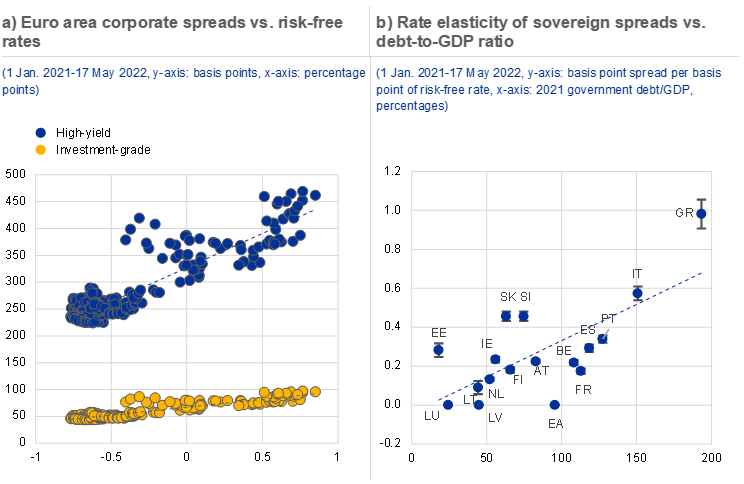
Sources: Bloomberg Finance L.P., ECB and ECB calculations.
Notes: Panel a: high-yield spreads refer to the five-year iTraxx Crossover CDS spreads; risk-free rate refers to the Germany five-year government bond yield. Panel b: spreads and rates refer to ten-year government bond yields of euro area countries; risk-free rate refers to German government ten-year yields. Error bars indicate a two standard deviation confidence interval around the parameter estimate. There are not sufficient data for Cyprus and Malta.
2.3 Commodity price shocks may lead to a reassessment of risks in the corporate sector
Corporate spreads increased in a challenging environment of higher commodity prices, higher inflation, higher interest rates and a weaker growth outlook. After a brief spike, spreads on high-yield corporate bonds returned to pre-invasion levels, but remain elevated compared with 2021, reflecting the more challenging macro-financial environment (Chart 2.8, panel a). Higher commodity prices and inflation will probably translate into higher cost and input prices, which can, in turn, erode earnings. Rising financing costs may further impair earnings as rates increase, especially for firms with variable-rate loans (e.g. leveraged loans) or floating-rate bonds, and for firms with significant near-term refinancing needs. Since the invasion, issuance of high-yield corporate bonds has remained subdued. Rating agencies have recently upgraded their predictions for speculative grade defaults and also indicated that risks are seen to the upside (Chart 4, panel a, Overview).
Sector-level equity performance over the course of 2021 was closely related to firms’ ability to maintain or increase margins (Chart 2.8, panel b). Pricing power is a key factor determining firms’ ability to cope with higher inflation and higher commodity prices (Chapter 1). In particular, a high energy intensity in production does not automatically imply that earnings will be materially compressed by higher energy prices. Firms might be able to pass on much of the cost increases to their customers, depending on their pricing power. Indeed, equity sub-indices for several industries with a high energy intensity in production[22] (e.g. paper products, metals and mining, and chemicals) have outperformed the broader EURO STOXX index in recent months. Data suggest that firms in these industries are able to exploit their pricing power to pass on cost increases to their customers (Chart 2.8, panel b). Ultimately, higher commodity prices permeate through production chains and affect the economy as a whole, leaving firms with lower pricing power most vulnerable (Box 1 and Box 3). In the euro area, some firms might struggle to maintain their margins if they face competition from producers in countries with lower energy cost.
Chart 2.8
Corporate spreads have widened, and equity performance suggests that pricing power is key in this more challenging environment
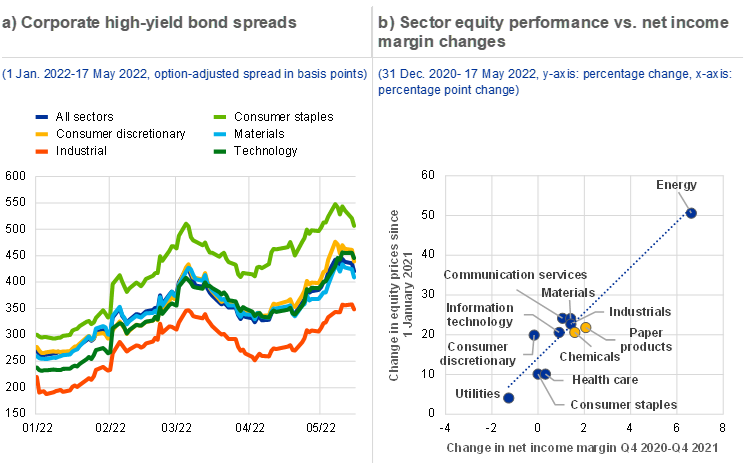
Sources: Bloomberg Finance L.P. and ECB calculations
Notes: Panel a: euro area. Panel b: change in equity prices refers to percentage change of subsector equity indices between Q4 2020 and Q4 2021; change in net income margin refers to change of the median net income margin between Q4 2020 and Q4 2021, at sector-level. Panel of 1,524 unique euro area non-financial corporations. Yellow dots indicate industries with a high energy intensity of production.
Firms are facing elevated uncertainty and upside risks to future energy prices. Oil prices have increased sharply in 2022, but in addition, the option-implied probability density of future oil prices has also broadened, pointing to high uncertainty (Chart 2.9, panel a). As oil prices peaked in March 2022, the implied volatility for call options exceeded that for put options for an extended range of maturities (Chart 2.9, panel b); this reflected market participants’ concerns over upward tail risks for oil prices, and/or that there was relatively more demand for insurance against price increases, as opposed to price decreases.[23] More recently, this dynamic has normalised, as downward risks for demand are seen in light of global growth concerns.
Hedging helps energy suppliers and users manage price changes, but it does not fully shield firms from volatility and price increases in commodity markets. Firms can hedge their exposures to commodity prices (e.g. utilities) in derivatives (e.g. futures) markets. Hedging helps firms to offer longer-term fixed contracts to customers or suppliers, while offsetting resulting risk exposures. In other words, hedging can reduce uncertainty across production chains and indirectly for consumers as well. Other, typically smaller firms do not hedge, as the cost and expertise required may be prohibitive for them. These firms are directly exposed to price changes and volatility.[24] But even for firms that actively hedge, the protection may be somewhat limited: as existing derivative contracts settle, new contracts need to be entered into at prevailing market prices. Furthermore, hedges are often imperfect or partial and leave firms partially exposed to underlying risks (“basis risk”).
Hedging of energy exposures became more challenging and complicated for some participants as commodity price volatility jumped. More recently, central counterparties have substantially increased their initial margin requirements on commodity futures contracts in response to elevated volatility (Chart 2.9, panel c). This means that a clearing bank (clearing member) must post a sizeable upfront margin to the central clearing counterparty (CCP), which might increase further at a later point of time. In turn, the clearing members require their clients to post similar or larger initial margins to them. For natural gas and electricity, these initial margins have reached up to 80% of the contract price,[25] meaning that hedgers are faced with larger liquidity needs.[26] In other words, firms can only hedge if they are willing and able to post such margins. For some firms, the cost of hedging may have started to outweigh the perceived benefit. While the posted initial margins limit counterparty risk and help to safeguard the financial system against systemic risk, the liquidity needs can be prohibitive for some firms with hedging needs. Firms that decide to remain unhedged retain their exposure to the underlying asset. Risks stemming from such exposures can ultimately threaten their solvency, if underlying (commodity) prices swing in a disadvantageous direction. Other firms might attempt to hedge their exposures through non-centrally cleared derivatives, although open interest for contracts such as (centrally cleared) natural gas futures did not show a major decline.[27] If firms were to hedge their exposures in this way, both the firm and the counterparty could be more exposed to counterparty credit risk. More broadly, this raises the question of whether margining practices, including those between the clearing member and their clients, are simply appropriately reflecting the more volatile market conditions, or whether there might be some unnecessary procyclicality (Chapter 5).
Chart 2.9
Energy prices increased, but also became more uncertain and more volatile, which increases the liquidity demands for hedging with cleared derivatives
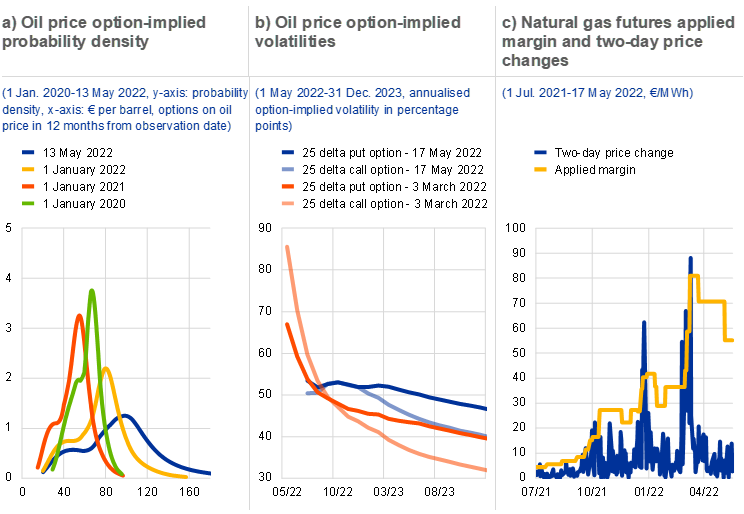
Sources: Bloomberg Finance L.P., ECB, ICE Clear Europe and ECB calculations.
Notes: Panel c: data on margins are provided by ICE Clear Europe in accordance with the Terms of Use. Applied margins are based on the scanning ranges published by ICE Clear Europe. Full initial margins should be computed with the CCPs’ proprietary risk models, in this case those of ICE Clear Europe, taking into account all risk parameters and full exposures.
Box 3
Financial stability implications of higher than expected inflation
Global inflation rates have increased substantially over the past year, driven by high energy prices, supply chain constraints and a rebound in demand. Inflation in the euro area is expected to remain elevated throughout 2022. Since the end of 2020, professional forecasters have repeatedly revised up their inflation projections as outturns surprised to the upside (Chart A, panel a).[28] Future developments in terms of energy prices and supply bottlenecks present upside risks to inflation.[29] This box assesses the channels through which higher than expected inflation could affect financial stability, taking into account the effects for governments, firms, households and financial markets.
Box 4
The impact of Chinese macro risk shocks on global financial markets
Since the middle of last year, global investors have stepped up their scrutiny of risks emanating from China as it experiences rising defaults and a slowing economy.[30] In the past, spillovers from China to other financial markets were typically judged to be small,[31] reflecting China’s less developed financial markets, a largely closed capital account regime, a managed exchange rate and a relatively small share of foreign investors in the domestic market. Yet China’s footprint in the global economy has grown rapidly over recent years, while domestic financial markets have deepened and integrated more with global capital markets.[32] This box looks at how Chinese macro risk shocks identified from movements in Chinese and US asset prices can affect global and European financial markets.
3 Euro area banking sector

3.1 Asset quality continues to improve, but higher energy prices revive risks for some loans
The asset quality of euro area banks improved during 2021 as stocks of non-performing loans (NPLs) continued to fall and inflows into riskier asset stages decelerated. In the fourth quarter of 2021, the aggregate NPL ratio fell further, to 2.1% of total loans, its lowest level since 2008. This was 58 basis points lower than in the fourth quarter of 2020, and continued the downward trend that had been sustained throughout the previous two years of the coronavirus (COVID-19) pandemic (Chart 3.1, panel a). At the same time, the ratio of loans classified as “underperforming” stage 2 remained stable at elevated, end-2020 levels of around 9%, well above pre-pandemic levels. Loans subject to forbearance measures[33], have stabilised at around 1.5% of total loans since the second quarter of 2021. The reduction in NPLs was driven by disposals and securitisations of loan portfolios between late 2020 and early 2021 (Chart 3.1, panel b). Cure rates of loans brought back to performing forborne status remain low, which underlines the importance of a functioning, liquid secondary market for NPL sales and securitisations as the primary measure for reducing larger NPL volumes.
Chart 3.1
Asset quality ratios continued to improve throughout 2021 on the back of sales and securitisations
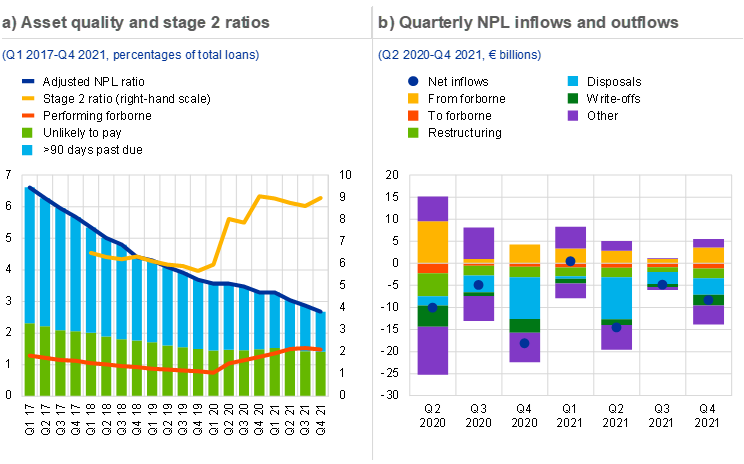
Sources: ECB (Supervisory Banking Statistics) and ECB calculations.
Notes: Panel a: the adjusted NPL ratio displayed deducts central bank cash reserves from the total loan denominator. The category “Performing forborne” excludes non-performing measures. Panel b: the “Restructuring” category consists of restructuring measures that have led to the partial repayment of outstanding debt and the seizure of collateral. Disposals relate to the sale of NPL portfolios as well as the securitisation of NPLs. “Other” captures flows that cannot be linked to any of the other, specified sources of flows. Among other things, it includes changes in the gross carrying amount of non-performing exposures due to additional amounts disbursed during the period, the capitalisation of past due amounts including capitalised fees and expenses, and changes in exchange rates related to non-performing loans and advances that were classified as non-performing at the end of the preceding financial year and have been continuously classified as such ever since.
Although the surge in “underperforming” stage 2 loans tapered off in 2021 on aggregate, the volume remains above pre-pandemic levels and has continued to increase in some sectors which are still affected by the pandemic. New flows into stage 2 loan classification stabilised at between 1.3% and 1.4% per quarter, based on four-quarter moving averages. This is still 70 basis points above pre-pandemic levels. The recovery in loan quality since the start of the pandemic has been widespread across most corporate sectors and for household (HH) loans (Chart 3.2, panel a). However, credit risk is still struggling to fall in some sectors that had already demonstrated vulnerabilities to economic shocks during the pandemic. Given their pre-existing vulnerabilities, these sectors remain sensitive to a slowing economy, higher interest rates, the intensification of supply chain bottlenecks and rising energy prices (Chapter 1).
Chart 3.2
Net stage 2 inflows stabilised in 2021 at elevated levels, but below the pandemic peak, while corporate fundamentals underlying new stage 2 loans improved
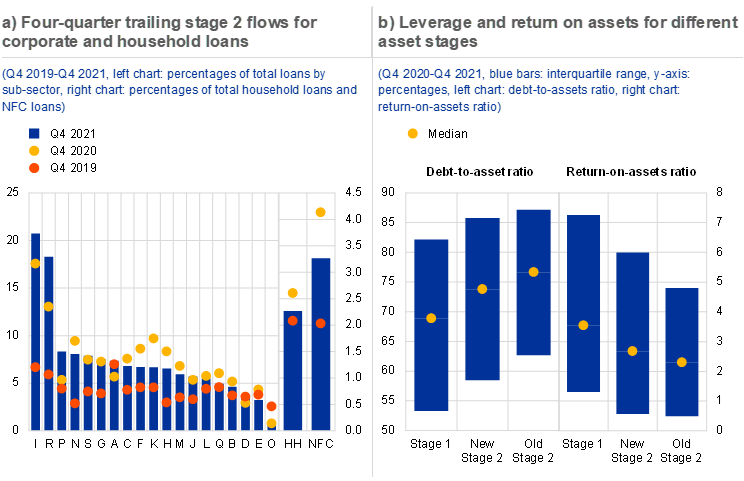
Sources: ECB (AnaCredit and Supervisory Banking Statistics), Bureau van Dijk’s Orbis database and ECB calculations.
Notes: Panel a: NACE codes and corresponding economic activities: A – Agriculture, forestry and fishing, B – Mining and quarrying, C – Manufacturing, D – Electricity, gas, steam and air conditioning supply, E – Water supply; sewerage, waste management and remediation activities, F – Construction, G – Wholesale and retail trade; repair of motor vehicles and motorcycles, H – Transportation and storage, I – Accommodation and food service activities, J – Information and communication, K – Financial and insurance activities, L – Real estate activities, M – Professional, scientific and technical activities, N – Administrative and support service activities, O – Public administration and defence; compulsory social security, P – Education, Q – Human health and social work activities, R – Arts, entertainment and recreation, S – Other service activities. Panel b: sample of 533,167 firms with an active lending relationship with a euro area bank at end-2020. New S2 loans are loans to firms that were classified as stage 1 in Q4 2020 and are classified as stage 2 in Q4 2021. Old S2 loans are loans to firms that were classified as stage 2 in Q4 2020 and are still classified as stage 2 in Q4 2021.
Debtors of corporate loans which moved from stage 1 to stage 2 during 2021 have better than expected corporate fundamentals. Compared with the pre-existing stock of stage 2 loans, loans that are newly transitioned to stage 2 are less leveraged and more profitable (Chart 3.2, panel b). Concerns about cliff effects associated with the phasing-out of pandemic support to corporates, which would have left corporates in distress, have therefore not materialised despite the expiration of most moratorium schemes and a halt to additional state-guaranteed funding. However, individual sectors – notably those that were most affected by the pandemic – have experienced significant reductions in profitability coupled with increased leverage ratios, leaving pockets of vulnerability on banks’ balance sheets. In parallel, euro area banks have also increased their exposure to leveraged lending,[34] which is at its highest level since 2008 and has increased strongly after 2017. Although outstanding amounts originated by euro area banks are manageable, activity is concentrated in a few large institutions.
The aggregate provision coverage ratio for euro area banks has been stable, albeit with signs of misalignment between coverage and credit risk at both the bank and the sector level. For “underperforming” corporate loans, the marginal amount of additional provision and collateral coverage for increases in credit risk is falling as risk increases for some sectors (Chart 3.3, panel a). Typically, banks provision more or ask for additional collateral coverage for loans to counterparties with a higher estimated probability of default (PD), as this would indicate a higher likelihood of loss materialisation. Looking at PD buckets across sectors, the increase in coverage ratios is small compared with the corresponding relative increase in counterparty credit risk in stage 2 loans, revealing a decreasing trend for marginal loan coverage per unit of risk in several sectors. This leaves exposures to riskier counterparties within the stage 2 classification relatively less protected against loan default, increasing tail risks of uncovered losses for stage 2 loans.
Chart 3.3
Coverage ratios for riskier counterparties are lagging behind in some sectors, and euro area banks’ Russian exposures are limited and often locally funded

Sources: ECB (AnaCredit and Supervisory Banking Statistics) and ECB calculations.
Notes: Panel a: “All sectors” is a weighted average of all NACE subsectors. The coverage ratio per unit of risk is calculated by dividing the additional coverage ratio per PD decile relative to the first decile by the spread between the average PD in the respective decile and the average PD in the lowest decile for each sector. PDs follow a through-the-cycle concept based on the IRB approach. X-axis values indicate the ranges of PD buckets. Each tick on the x-axis refers to PD values that are greater than the value displayed and smaller than the next value on the right. “PD” stands for probability of default. Panel b: Q4 2021 data include some subsidiaries of Russian banks that ceased operating in the euro area due to the war.
The economic impact of the Russian invasion of Ukraine has exposed banks to a number of risks, although direct credit exposures to Russia are limited, locally funded and mainly via subsidiaries. Russian banks have been the most severely affected by the invasion: their problems include stress in their euro area subsidiaries that has led to several resolutions and wind-ups. For euro area banks, credit to Russian borrowers amounted to around 0.2% of total assets at end-2021, with a selection of banks from Italy, Cyprus, Latvia, Luxembourg and Austria having relatively higher exposures in terms of total assets (Chart 3.3, panel b). Most credit exposures were funded by Russian deposits, reducing the net exposure to Russia.[35] Recently, large euro area banks with sizeable exposures to Russia reported increases in their loan loss provisioning for Q1.
Chart 3.4
Euro area banks’ exposures to energy-intensive sectors and to direct risks from energy prices are concentrated in certain sectors and the derivatives market
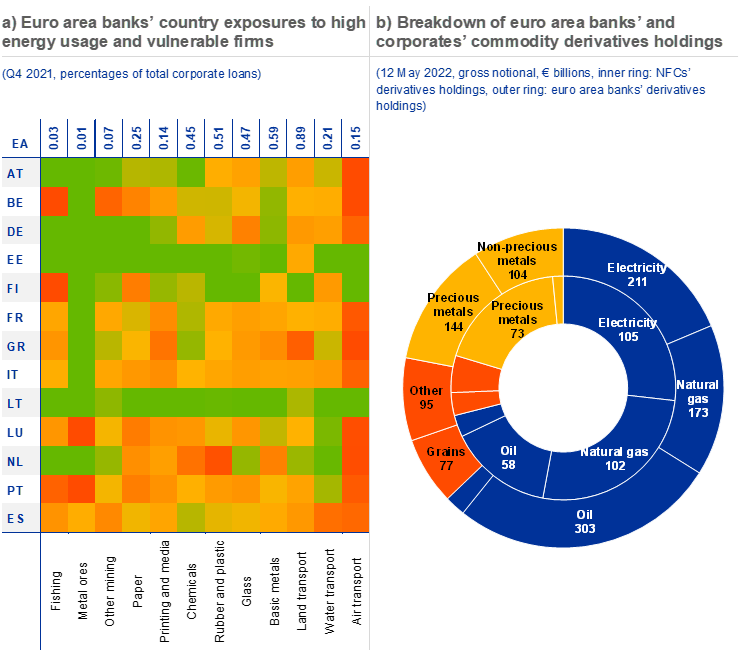
Sources: ECB (AnaCredit, Supervisory Banking Statistics and European Market Infrastructure Regulation), OECD Trade in Value Added (TiVA) database (2018) and ECB calculations.
Notes: Panel a: colour scale from green to orange to red. Green indicates small exposures to vulnerable firms; cells become orange/red if share of exposure increases. Vulnerable firms are entities with an Altman z-score below 1.81. The Altman z-score is calculated as 0.717 x working capital/total assets + 0.847 x retained earnings/total assets + 3.107 x EBIT/total assets + 0.420 x equity/debt + 0.998 sales/total assets. Sector average energy intensity is measured by the share of input from the energy-producing mining and quarrying sector, coke and refined petroleum products as well as the electricity, gas, steam and air conditioning industries, classified according to the United Nations International Standard Industrial Classification for All Economic Activities, Rev. 4., and is attributed to the sector based on the four-digit Standard Industrial Classification code. Firms in sectors above the 75th percentile of the energy intensity ratio are regarded as high-energy consumers. Panel b: the rings represent the gross notional outstanding (€ billions) in energy (blue), agricultural (red) and metal (yellow) derivatives for which at least one of the two counterparties of the trade is a bank domiciled in the euro area (outer ring) and for which at least one of the two counterparties of the trade is a non-financial firm.
Looking ahead, elevated and volatile energy and commodity prices have increased credit risk, especially for more vulnerable corporates. The shift in the outlook for euro area growth and inflation is, in general, likely to weigh on corporate profitability and debt sustainability (Chapter 1). Credit granted by euro area banks to firms with significant reliance on energy and specific forms of fossil fuel[36], and weak corporate fundamentals[37] amounts to 3.8% of total corporate lending.[38] Loans to the transport and manufacturing sectors appear to be the most vulnerable, although total exposure is limited at both the country and the euro area level (Chart 3.4, panel a).
Euro area banks also have some exposures stemming from their role in intermediating derivatives markets, as they act as counterparties in over half of euro area core commodity derivatives contracts. Commodity derivatives account for less than 1% of the overall euro area derivatives market’s size in terms of gross notional. However, the business is highly concentrated in a few large banks which provide both client clearing services and ancillary financing services to commodity traders and energy sector firms.[39] Financial stability considerations might arise with regard to substitutability, given that a limited number of large NFCs access the commodity derivatives market via a few large banks. These banks offer liquidity through market making in the bilateral market segment and act as clearing members of the few central counterparties clearing commodity derivatives (Chart 3.4, panel b).
The prices of futures on commodities rose rapidly during March 2022, and this was accompanied by corresponding increases in margin calls. The recent volatility in energy prices has also seen liquidity pressures in some derivatives markets (Chapter 2). The surge in commodity prices and volatility exerted liquidity pressure on NFCs with hedging activities, especially for energy derivatives, given their need to meet initial and variation margin calls. Initial margins posted by NFCs on cleared commodity derivatives more than doubled between December 2021 and March 2022. The high proportion of centrally cleared trades (68% in terms of gross notional), especially for energy derivatives, decreases banks’ counterparty credit risk towards their clients; this does, however, introduce some residual step-in liquidity risk to cover the margins required by CCPs if some NFCs are unable to meet margin calls. Banks’ exposures to NFCs in this market are limited, though, and should therefore not add significant counterparty risk to banks’ balance sheets.
Overall, euro area banks’ asset quality has remained stable, albeit with material risks to corporate loans persisting. Concerns about aftershocks from 2020 have not materialised over the last year, although some sectors of NFCs remain vulnerable to shocks. Overlaps between firms affected by weak debt sustainability and high energy prices have led to pockets of default risks in the corporate sector. Looking ahead, the combination of existing vulnerabilities and effects of inflation and the war in Ukraine increases risks to asset quality.
3.2 Profitability above pre-pandemic levels, but outlook weaker
The financial performance of euro area banks improved substantially during 2021 and exceeded pre-pandemic levels, amid lower loan loss provisions. On aggregate, euro area significant institutions recorded a return on equity (ROE) of 6.6%, up from 1.7% a year earlier (Chart 3.5, panel a).[40] Looking at a sample of listed euro area banks, for which the data span a longer period, reveals that this was their strongest performance in a decade. Weak profitability in the euro area banking sector has been a concern as it affects financial stability by reducing banks’ intermediation capacity and resilience.[41] While banks’ performance was adversely affected by pandemic-related impairments during 2020, robust economic growth, lower loan loss provisions and higher operating profits contributed to the marked improvement in 2021. With net interest income (NII) remaining unchanged and expenses rising, the improvement in operating profits was largely down to higher net trading income (NTI) and, especially, net fee and commission income (NFCI). Results for listed banks’ first quarter 2022 earnings suggest that profitability remained robust in Q1, albeit slightly lower than in Q4, amid weaker other profit and loss items and higher provisions, while operating income improved on the back of stronger NII.
Chart 3.5
Profitability in 2021 exceeded pre-pandemic levels on the back of lower loan loss provisions and higher non-interest income components
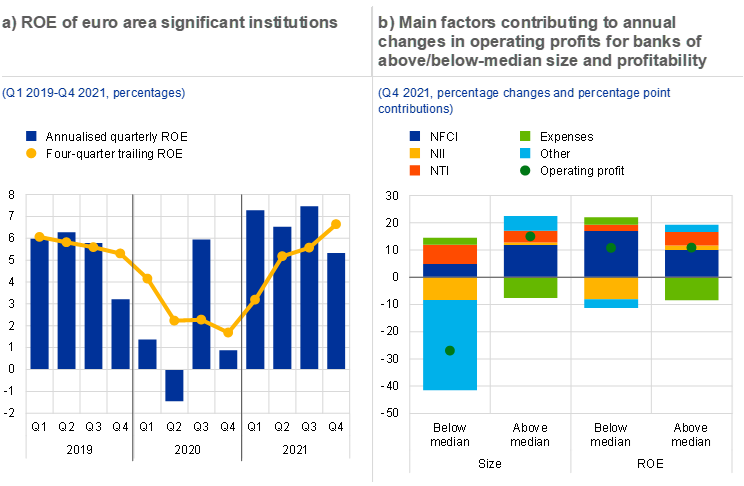
Sources: ECB (Supervisory Banking Statistics) and ECB calculations.
Notes: Based on a balanced sample of 89 significant institutions. Panel b: “Other” stands for other operating profits.
Net fee and commission income, driven by asset management activities, strongly supported profitability in 2021, while net interest income remained flat. In 2021, euro area banks saw their NFCI grow by almost 12%, by far the largest increase observed over the past few years, thanks to the economic recovery and strong growth in assets under management. The positive role played by NFCI in supporting operating profits was more pronounced for larger banks and for those with below-median ROE, as the latter faced a decline in their NII (Chart 3.5, panel b). NFCI might, however, be vulnerable to stock market corrections. The decline in operating profits for smaller banks was driven to a large extent by NPL sales of Greek banks. On aggregate, NII remained broadly unchanged on the previous year and is slowly climbing back towards pre-pandemic levels on the back of rising lending volumes and a bottoming-out of margins. However, heterogeneity among banks continues to be pronounced, with around 45% of banks still reporting lower NII than in the previous year.
Chart 3.6
Downward revisions in 2022 ROE projections as a result of the war in Ukraine, with higher impairments seen as the main driver

Sources: Bloomberg Finance L.P., Refinitiv, ECB (Supervisory Banking Statistics) and ECB calculations.
Notes: Panels a) and b) are based on a sample of 32 listed euro area banks. Actual and projected ROEs are averages weighted by banks’ total assets. Panel b: LLP stands for loan loss provisions; OPC stands for operating costs. Panel c) is based on a sample of 28 listed euro area banks. Raiffeisen Bank International has been excluded from the sample in the interests of better readability. EA indicates the euro area average.
The Russia-Ukraine war casts uncertainty on the economic outlook and implies a downward revision of bank profitability for this year. After strong profitability results in 2021, the ROE of listed euro area banks is expected to be lower this year before gradually improving over the next few years to 8.2% in 2024, although analysts have lowered their bank profitability projections on account of the economic fallout from the war (Chart 3.6, panel a). The downward revisions of ROE this year are attributed to higher impairments and rising costs, coupled with lower NFCI while NII is expected to be higher (Chart 3.6, panel b). Since the direct exposure of euro area banks to Russia and Ukraine, comprising 5% of Common Equity Tier 1 (CET1) capital, is rather limited, market analysts consider the impact on aggregate euro area bank profitability to be contained. The differences at the bank level are pronounced, however; analysts have lowered their profitability projections for a few listed banks more substantially to reflect their more elevated exposures to Russia and Ukraine, but even for these banks the impact appears manageable (Chart 3.6, panel c).
Net interest income is expected to benefit from higher interest rates from 2023 onwards, although some banks might face challenges in the medium term. Forward rates imply an improvement in NII from next year. Supervisory data on interest rate risk in the banking book suggest that, in the short run, higher rates appear to be beneficial for almost all banks (Chart 3.7, panel a). The median change in NII, an earnings-based measure of interest rate risks over a one-year horizon, caused by a parallel upward shift of the yield curve by 200 basis points amounts to 2.8% of CET1 capital. As loans have increasingly been granted with longer interest rate fixation periods in recent years, these long-dated assets need to be funded at costs which rise alongside gradually higher rates. While banks hedge some of their interest rate risks, rising interest rates might adversely affect some banks in the medium term. This is reflected in the change in a bank’s net worth, an economic value-based measure of interest rate risks that takes the entire maturity spectrum of the banking book into account (Box 5). Indeed, the economic value of banks with a higher share of fixed-rate asset cash flows seems to decline more under a scenario of higher rates (Chart 3.7, panel b).
Chart 3.7
The impact of higher rates on banks may vary over time, as the relative repricing of liabilities and assets depends on the share of fixed-rate assets
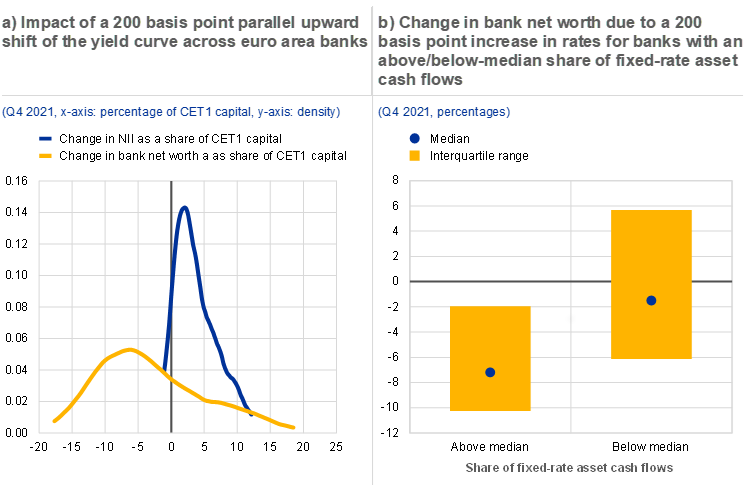
Sources: ECB (Supervisory Banking Statistics) and ECB calculations.
Note: Based on a sample of 80 significant institutions.
Lending to the non-financial private sector recovered in 2021, but tighter lending standards, lower confidence and revised growth expectations might weigh on future lending. Bank lending to households and NFCs recovered in 2021 to exceed pre-pandemic levels. Average monthly lending flows to the non-financial private sector amounted to €39 billion in 2021, which is 40% above the levels observed between 2017 and 2019. While mortgages accounted for most of the lending at the beginning of the year, corporate lending picked up significantly in the second half of 2021. Annual growth rates of lending to households for house purchases and to corporates are, at 5.4% and 4.2% respectively, substantially above the median for their historical range since 2010, with only consumer lending growth, at 2.5%, remaining substantially below its pre-pandemic levels (Chart 3.8, panel a). According to the ECB’s bank lending survey, the share of banks reporting a tightening of credit standards declined over the last four quarters across all loan types, while loan demand picked up over the same period (Chart 3.8, panel b). However, banks expect both a significant tightening of lending standards in the second quarter, in particular for corporate lending, and weaker loan demand. In addition, since confidence indicators, which typically lead lending growth, have fallen recently because of the war in Ukraine, and economic growth for both 2022 and 2023 has been revised downwards, loan growth may well slow going forward.
Chart 3.8
Except for consumer lending, loan growth is back above pre-pandemic levels, although lending standards are expected to tighten and loan demand to weaken
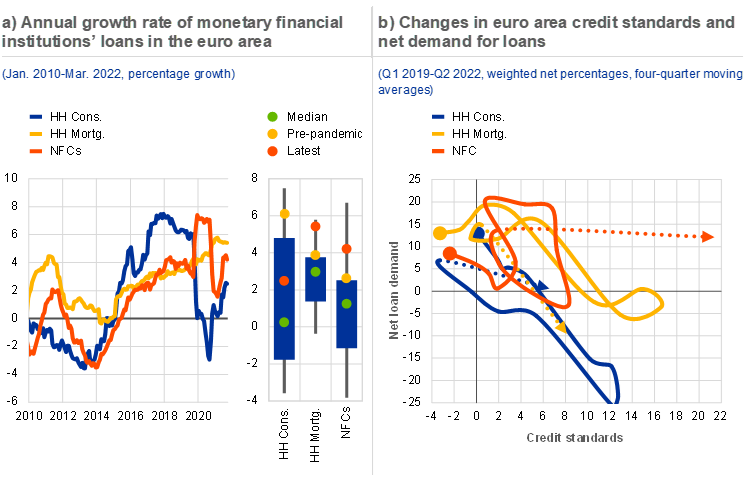
Sources: ECB and ECB calculations.
Note: Panel b: the solid lines represent four-quarter moving averages, backward-looking three months until Q1 2022, while the dotted lines represent the trend towards the expected values for Q2 2022.
The number of major, global cyber incidents targeting financial institutions has increased since 2019, and euro area banks lag behind their peers in terms of IT investment. The number of major cyber incidents targeting global financial institutions has increased substantially in recent years, although it has declined somewhat since the peak reached in 2020 (Chart 3.9, panel a). In terms of attacks targeting significant institutions in the euro area, this global trend was mirrored by the number of cyber incidents reported to the ECB, which reached the highest level ever in the fourth quarter of 2020. It is also worth noting the change in rankings for euro area bank regarding incident types, with a higher share of social engineering and third-party provider incidents as well as accidental data leakages in 2021 than in the previous year. Banks need to invest in their IT infrastructure if they are to deal with cyberattacks adequately. Compared with US banks, euro area banks have invested much less into information technology, despite the fact that this is essential to remain ahead of cyberattacks in the future (Chart 3.9, panel b).
Chart 3.9
The number of cyber incidents targeting global financial institutions has increased in recent years, but euro area banks’ IT investment lags behind that of their US peers
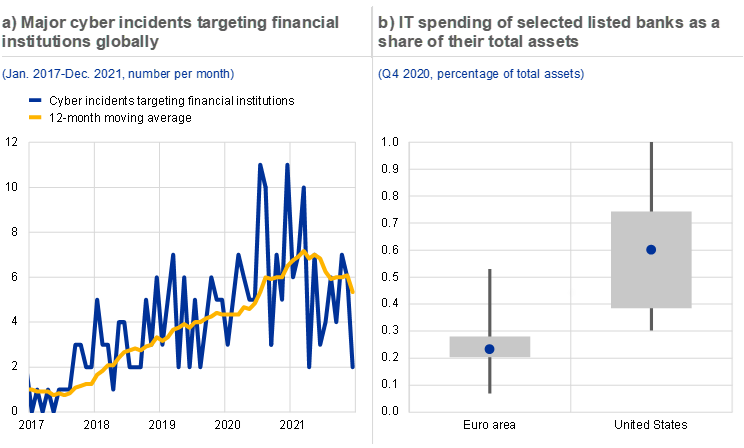
Sources: Carnegie Endowment for International Peace and bank annual reports.
Notes: Panel a: some of the events are related to financial institutions in the broader sense and might ultimately affect the clients of financial institutions. Panel b: based on a sample of ten euro area and six US listed banks.
Box 5
Interest rate risk exposures and hedging of euro area banks’ banking books
While rising interest rates are expected to improve banks’ net interest income in the short term, they may also weigh on banks’ net worth in the medium term. On aggregate, euro area banks exhibit a positive duration gap,[42] which implies that if interest rates rise, assets will lose more value than liabilities, thus reducing banks’ economic value of equity. After narrowing in 2020, the duration gap started widening again as of the first quarter of 2021 (Chart A, panel a), signalling that banks were reverting closer to pre-pandemic levels of interest rate risk. Over time, derivatives have, on aggregate, played an offsetting role; in other words, banks’ interest rate risk (IRR) exposure arising from their non-derivative positioning was partly counterbalanced by their derivative positions in the banking book.
3.3 Higher market funding costs and improved capital ratios
Low, stable deposit funding rates have insulated banks from the increase in funding costs associated with a notable rise in bank bond yields since the end of 2021. Higher risk-free rates, reflecting inflationary pressures, have brought the yields of covered bonds for the euro area on aggregate back to levels last seen in 2014, while yields for riskier instruments have remained below those observed at the start of the pandemic (Chart 3.10, panel a). This is because the risk premia embedded in the more junior instruments have remained relatively contained compared with March 2020. Low, stable deposit funding rates, coupled with an increase in deposit volumes, have helped to keep banks’ overall funding costs favourable. Banks have reduced their issuance of bail-inable debt, mainly as a consequence of the substantial rise in market funding costs. For senior bail-inable bonds, the cumulative issuance volume in the first four and a half months of this year was almost 11% lower than the average observed in the period from 2017 to 2019, while for Tier 2 (T2) and Additional Tier 1 (AT1) instruments volumes were close to 23% and 52% lower (Chart 3.10, panel b). Although forward rates suggest that banks’ bond funding costs could rise further, the impact on funding costs will be limited as the majority of maturing bonds were issued at higher yields (Chart 3.11, panel a).
The expected reduction of banks’ Eurosystem funding is likely to return bank balance sheet size and the composition of liquid assets to pre-pandemic levels. Based on the median estimate obtained from the ECB Survey of Monetary Analysts[43], €700 billion of repayments of targeted longer-term refinancing operations (TLTRO) are expected to be made by the end of December 2022. Since TLTRO repayments are likely to be made using excess liquidity, this implies that liquidity coverage ratios and the composition of high quality liquid assets (HQLA) will return to pre-pandemic levels, with the share of government bonds in HQLA rising from 25% to 45%.
Chart 3.10
Banks’ bond funding costs have increased substantially since end-2021 amid higher risk-free rates and have prompted banks to reduce their issuance of bail-inable debt
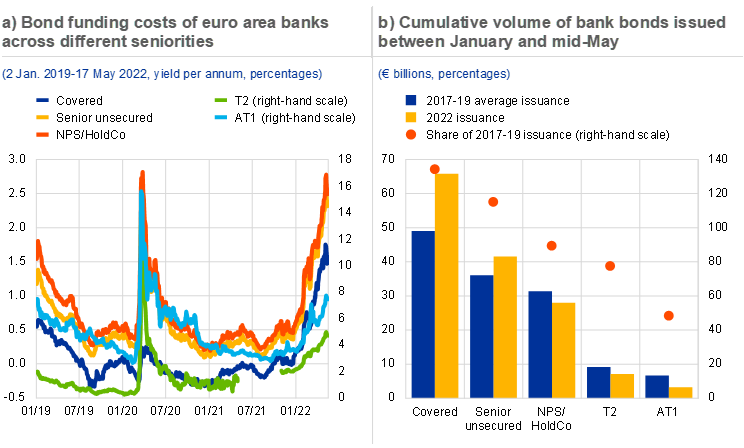
Sources: IHS Markit, Dealogic and ECB calculations.
Notes: NPS stands for non-preferred senior; HoldCo stands for holding company. Panel a: the T2 index shows no values between May and October 2021 since at that time there were no Tier 2 bonds matching the eligibility criteria for being included in the index. Panel b: the years 2020-21 are excluded from the benchmark of average issuance volumes shown as the blue bars since their values might be biased due to the pandemic.
The phasing-out of favourable TLTRO funding rates in June is likely to weigh on bank profitability in 2022. According to two scenarios which take into account the new TLTRO rates and the distribution of excess liquidity between Tier 1 and Tier 2 reserves, bank profitability could be adversely impacted by between 60 basis points and 130 basis points this year (Chart 3.11, panel b). In the first, most likely scenario, banks meet the lending threshold and benefit from a TLTRO rate of -0.5%. Depending on the magnitude of excess reserves, the net effect from the change in TLTRO funding costs would result in profitability which is around 60 basis points lower. In the more extreme scenario, banks fail to meet the lending threshold and receive a TLTRO rate of 0%, leading to a greater reduction in profitability. However, the expected earlier rise in interest rates compared to the beginning of the year appears to reduce the incentive for banks to repay TLTRO funding sooner, which is likely to reduce the resulting adverse impact on profitability.
Chart 3.11
Rolling over maturing bonds would not affect overall bank funding costs, but the phasing-out of special TLTRO discounts is likely to impact bank profitability in 2022
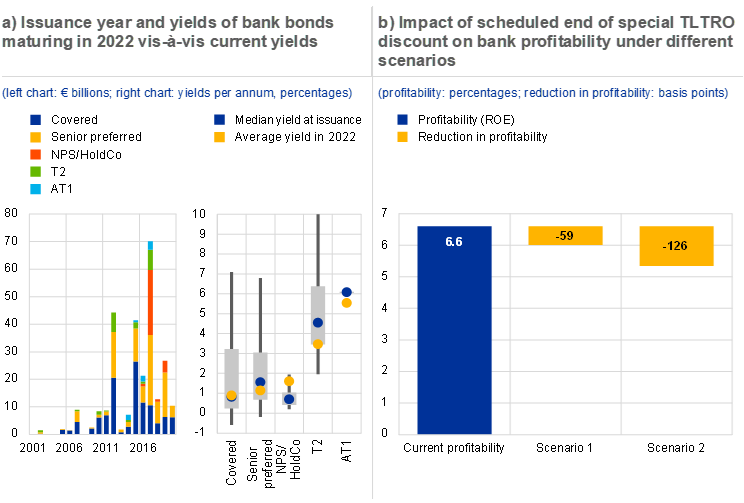
Sources: Dealogic, IHS Markit, ECB (Statistics Bulletin and Supervisory Banking Statistics) and ECB calculations.
Euro area banks’ regulatory capital ratios increased slightly in 2021 on the back of the de-risking initiated at the start of the pandemic. CET1 ratios for euro area significant institutions rose by 50 basis points in 2021 to 15.2%.[44] The positive contributions from retained earnings and lower average risk weights more than offset the negative impact of balance sheet expansion. The contribution from de-risking shrank in 2021, however, due to a pick-up in lending activities and the associated higher risk weights in the fourth quarter (Chart 3.12, panel a). The average CET1 capital requirement including Pillar 2 guidance amounted to 11.7% in the last quarter of 2021, with an average trigger point for automatic restrictions on distributions (maximum distributable amount, MDA) at around 10.6% (Chart 3.12, panel b).
Analysis suggests that the euro area banking system should be largely resilient to any extreme macroeconomic risks emanating from the Russia-Ukraine war. The invasion of Ukraine has led to disruptions in energy and commodity markets and increased uncertainty around the outlook for euro area economic growth. A severe impact on euro area production, prices and demand could adversely affect euro area bank asset quality and solvency. A vulnerability analysis considering adverse and severely adverse economic scenarios over a three-year horizon indicates that, overall, the euro area banking sector is resilient, with the aggregate CET1 ratio estimated to total around 11% even under the severely adverse scenario (Box 6).
Chart 3.12
Bank capital ratios rose slightly in 2021 and are, on aggregate, comfortably above requirements, while credit losses from macroeconomic consequences of the war in Ukraine will probably only have a limited impact
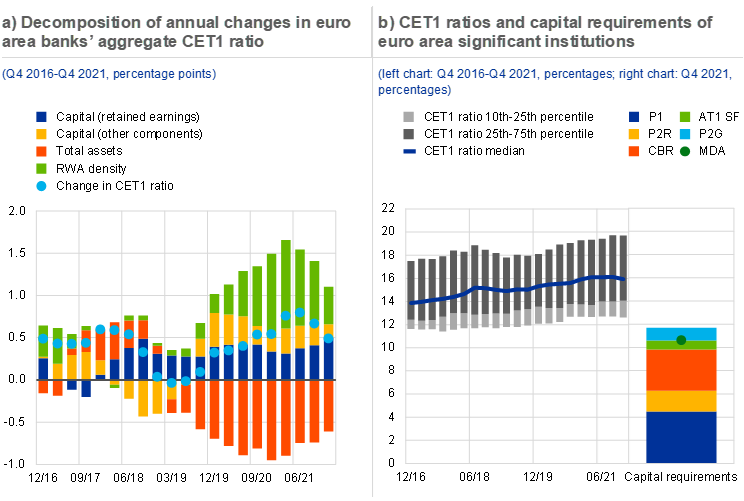
Sources: ECB (Supervisory Banking Statistics) and ECB calculations.
Notes: Based on a balanced sample of 89 significant institutions. Panel a: RWA stands for risk-weighted assets. Panel b: P1 stands for Pillar 1 requirement; P2R stands for Pillar 2 requirement; CBR stands for combined buffer requirement; AT1 SF stands for shortfall of Pillar 1 (AT1/T2) requirement; P2G stands for Pillar 2 guidance; MDA stands for maximum distributable amount.
Euro area banks’ share prices rallied strongly towards the end of 2021 before dropping sharply due to the uncertainty arising from the war in Ukraine. Banks benefited in early 2022 from the prospect of earlier rate hikes than previously anticipated but then, after the Russia-Ukraine war broke out, underperformed all other sectors over fears that higher credit risks would result. The declines in bank share prices since then were driven by the notion that higher inflation could potentially put the brakes on new mortgage lending, and amid higher credit and foreign exchange risks (Chart 3.13, panel a). Since the restriction on dividend payments expired and profitability, as well as market valuations, have exceeded pre-pandemic levels, banks with capital ratios above regulatory requirements have announced higher payouts (both dividends and buybacks) than banks which are closer to their capital thresholds (Chart 3.13, panel b).
Chart 3.13
Bank share prices suffered at the outbreak of war in Ukraine amid credit risks, but market valuations have improved and banks have increased payouts
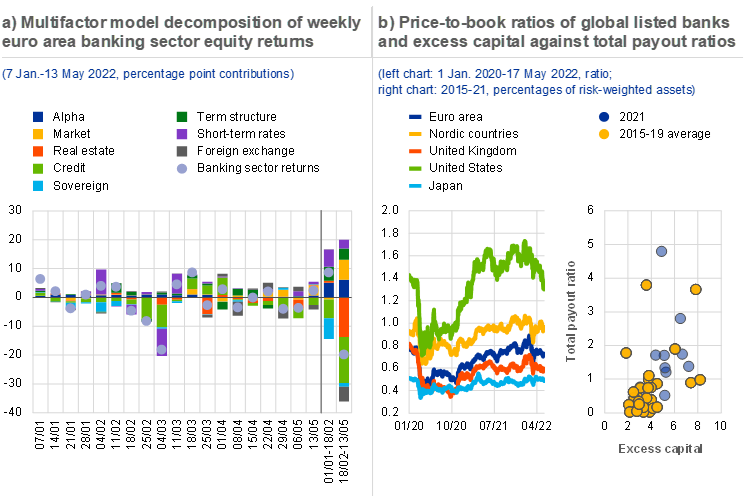
Sources: Refinitiv, Bloomberg Finance L.P., S&P Global Market Intelligence, bank financial reports and ECB calculations.
Notes: Panel a: the calculations are based on the Datastream Eurozone Banks index. Panel b: left chart: based on simple averages of a sample of 32 listed euro area banks, 6 listed Nordic banks, 5 listed UK banks, 19 listed US banks and 12 listed Japanese banks; right chart: the total payout ratio is the sum of dividends and share buybacks as a percentage of risk-weighted assets in the respective financial year. Long-term averages (in yellow) are based on a sample of 36 listed euro area significant institutions. The blue dots refer to 15 banks that have already announced their distribution plans attributable to 2021 profits.
Box 6
Assessing the resilience of the euro area banking sector in light of the Russia-Ukraine war
This box presents an assessment of the euro area banking sector’s resilience to adverse macroeconomic scenarios in the light of the Russian invasion of Ukraine. While euro area banks’ direct exposures to Russia are limited overall, disruptions in energy and commodity markets pose risks to economic activity in the euro area that could adversely affect banks’ balance sheets. To examine these risks, the ECB has combined three macroeconomic scenarios (a baseline scenario, an adverse scenario and a severely adverse scenario) with stress-testing tools to perform an in-house assessment of the solvency of significant euro area banks. The resulting vulnerability analysis (VA) is a desktop exercise which does not include interactions with banks. The exercise estimates the impact on bank capital of potential losses arising from (i) exposures to euro area economic sectors which have strong trade links with Russia or are dependent on commodity imports from the region, (ii) broader macro-financial stress triggered by current events and (iii) revaluation risks related to increased market volatility and reduced liquidity. For this purpose, top-down models, which are consistent with the EBA 2021 Methodological Note[45], were used to assess banks’ credit, market and profitability risks. The estimated impacts are contingent on the underlying scenario assumptions, which are characterised by a high degree of uncertainty.
4 Non-bank financial sector
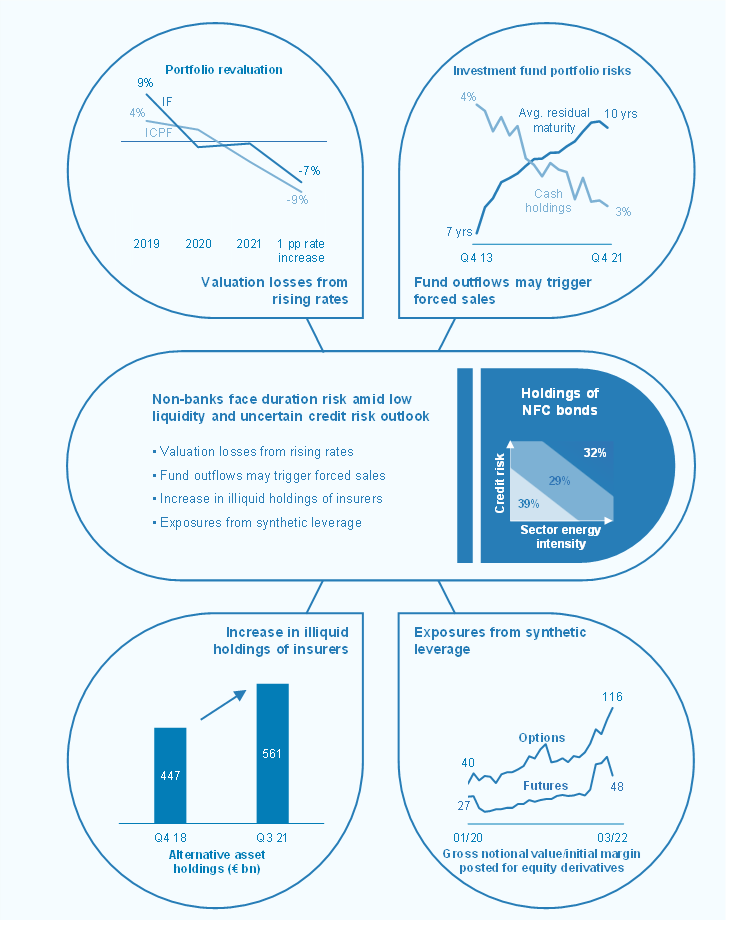
4.1 Non-bank financial sector faces higher credit risk as duration risk starts to materialise
Duration risk in the non-bank financial sector has started to materialise recently and valuation losses may increase further in an environment of rising interest rates. Yields have continued on their upward trend that started at the end of 2021. Over the course of the past year, rising rates have led to a decline in the value of bond portfolios of around 3.7% for insurance corporations and pension funds (ICPFs) and 0.4% for investment funds (IFs) (Chart 4.1, panel a). Given that the share of interest rate sensitive assets in ICPF and IF portfolios remains high, in the absence of hedging strategies a further rise of 1 percentage point in all yield to maturity would imply additional bond portfolio valuation losses of around 9% for ICPFs and 7% for IFs. ICPFs and IF shareholders are therefore increasingly shifting their investments towards equities as well as towards alternative assets (Sections 4.2 and 4.3). In the medium term, however, rising interest rates could reduce the incentives for the non-bank sector to search for yield and could improve ICPFs’ capital positions, mitigating overall financial stability risks.
Chart 4.1
Non-banks’ debt portfolios face revaluation losses amid rising rates, while direct exposures to Russian assets and commodity derivatives are limited

Sources: Eurostat, ECB (Securities Holdings Statistics and European Market Infrastructure Regulation) and ECB calculations.
Notes: Panel a: estimated risk shown in the shaded bars assumes an increase of 1 percentage point in the yield to maturity of all securities held at the end of 2021. Estimated values are calculated as the sum of modified durations multiplied by the amounts held at the security level, multiplied by 0.01. Panel b: the chart includes all debt securities and equities issued by Russian-domiciled financial and non-financial corporations (NFCs), as well as Russian sovereign debt securities. Panel c: initial margins include all margins posted with euro area central counterparties.
The non-bank financial sector has so far proven to be resilient to increased uncertainty following the Russian invasion of Ukraine. At the end of 2021, euro area non-banks’ direct exposures to debt securities and equities issued by Russian entities were below 1% of their total assets (Chart 4.1, panel b). While fund categories with higher Russian exposure have experienced significant outflows and some funds have had to be suspended, there have been no widespread redemptions or spillovers to the broader euro area non-bank financial sector (Sections 4.2 and 4.3). Furthermore, the increase in volatility in derivatives markets has remained contained to the commodity segment (Chapter 2), while margins on interest rate derivatives – the segment to which non-banks are significantly exposed – have been affected much less than those on commodity derivatives (Chart 4.1, panel c). Nevertheless, the non-bank financial sector could face second-round effects stemming from economic uncertainty and rising commodity prices.
Chart 4.2
Non-banks may be exposed to rising credit risk from NFCs in energy-intensive industries

Sources: Eurostat, ECB (Securities Holdings Statistics), OECD Trade in Value Added (TiVA) database (2018) and ECB calculations.
Notes: Panel a depicts all broad non-financial sectors of the economy, ranked according to their average energy intensity. Firms in sectors above the 75th percentile of the energy intensity ratio are regarded as high energy consumers, firms in sectors below the 25th percentile are considered low energy consumers. For a detailed definition, see also Chart 3.4 panel a. Energy intensity may vary across subsectors within the broader sectors. Sector free float in NFC free float is the respective sector’s amount of outstanding debt and equity securities as a percentage of total NFC debt and equity securities held in the euro area, excluding Eurosystem holdings, at the end of 2021. Sector gross value added shares are based on 2020 data. Panel b: energy intensity of sectors is defined as in panel a. “Other IG” includes all investment grade ratings except BBB (AAA to A). “HY” includes all high-yield ratings, i.e. ratings below BBB (BB to D). The chart excludes all bonds with no available rating.
Rising energy prices increase the vulnerabilities of non-bank financial institutions (NBFIs), as corporate bond and equity portfolios of pension funds (PFs) and investment funds are somewhat concentrated in energy-intensive industries. While the economic recovery from the coronavirus (COVID-19) pandemic has mitigated NFC default risk in the euro area, there are new risks stemming from firms heavily reliant on energy. Non-banks’ investments in NFCs are, overall, mostly proportional to the individual sectors’ available free-float equity and debt securities outstanding (Chart 4.2, panel a). However, given the greater propensity of larger firms to issue equity and marketable debt, securities issued by a number of energy-intensive sectors (e.g. manufacturing) are overrepresented in capital markets relative to their share of euro area economic value added.[46] Non-banks’ NFC portfolios may therefore be especially sensitive to heightened corporate credit risks resulting from rising energy prices.[47] This increases pre-existing vulnerabilities in the debt portfolios of PFs and IFs, as more than 10% of their holdings are already in the high-yield segment (Chart 4.2, panel b).
4.2 Bond funds are vulnerable to rising yields and uncertain second-round effects from the war
Recent fund flows reflect investors’ expectations of higher inflation and financial fragmentation going forward. Although a higher interest rate environment can bring benefits for financial stability as incentives to take on risk are reduced, the transition to a new equilibrium could lead to losses on unhedged bond portfolios. Investors had already started to rotate away from bond funds before the Russian invasion of Ukraine, likely indicating concerns regarding duration and credit risk with an emphasis on the latter, as outflows occurred primarily from corporate bond funds (Chart 3, panel a, Overview). Inflation-linked bond funds, whose returns are hedged against rising inflation, saw renewed inflows after the invasion, which turned negative again in late April, in line with inflation expectations (Chart 4.3, panel a). The extent to which continued outflows from bond funds will affect non-financial corporations’ financing needs remains to be seen, as their reliance on market-based and non-bank credit has increased substantially over the past decade.[48] Beyond sizeable outflows from euro area bond markets, recent flows may also reflect an increase in the perceived risk of financial fragmentation (Chapter 2). The gap between global fund outflows from bond markets of lower-rated euro area countries compared with bond markets of higher-rated euro area countries widened at the beginning of February, at the same time as government bond spreads increased (Chart 4.3, panel b).
Chart 4.3
Fund investors reposition for higher inflation and financial fragmentation risks

Sources: EPFR Global, Bloomberg Finance L.P., Refinitiv and ECB calculations.
Notes: Panel a: inflation swap rates do not purely reflect inflation expectations, as they also include a risk premium. Panel b: a rating above/below AA- is defined as higher/lower. The GDP-weighted government bond spread is the difference between the GDP-weighted average of government bond yields of lower-rated countries and the GDP-weighted average of government bond yields of higher-rated countries. There are slight differences in country samples for fund flows and GDP government bond spread due to data availability.
The direct impact of the Russia-Ukraine war on the euro area investment fund sector has been limited so far, even though several funds have been suspended. The sector’s overall direct exposure to Russian securities is negligible, standing at well below 1% of total assets as of the fourth quarter of 2021 (Section 4.1), although it is concentrated in funds with a focus on emerging markets (EMs). Russian equity holdings are also concentrated in specific funds, with only the top 1% of exposed funds holding more than half of their portfolio in Russian equities.[49] The Russian invasion of Ukraine and the related financial sanctions triggered several suspensions as funds were not able to price and trade Russian securities. Most index providers also removed Russian securities from their indices, which meant that index-tracking funds had to dispose of or mark down their Russian exposures. Nevertheless, these developments did not cause a wider run on funds. Global EM funds investing in emerging Europe and BRIC countries experienced an acceleration of outflows after the invasion, which subsequently receded (Chart 4.4, panel a). More broadly, the wider euro area fund sector did not suffer from the kind of long-lasting or large-scale outflows seen at the start of the pandemic (Chart 4.4, panel b).
Chart 4.4
Spillovers from the war to the broader euro area investment fund sector have been limited so far
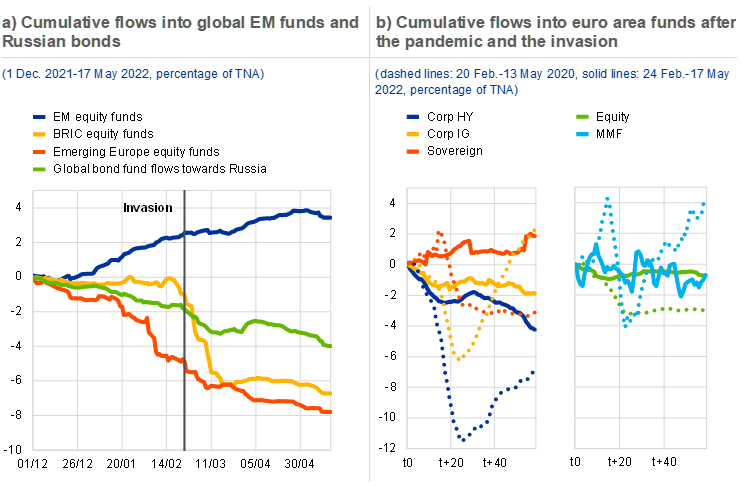
Sources: EPFR Global and ECB calculations.
Notes: Panel a: global bond fund flows towards Russia are estimated flows from global funds into Russian bonds, which differs slightly from the other categories which show flows into funds based on their respective investment focus. Panel b: cumulated flows into euro area-domiciled funds after the start of the COVID-19 market turmoil (dashed lines) and after the Russian invasion of Ukraine (solid lines). x-axis indicates business days after 20 February 2020 and 24 February 2022 (t0). TNA stands for total net assets; Corp HY stands for corporate high-yield bond funds; Corp IG stands for corporate investment-grade bond funds: MMF stands for money market funds.
Investment funds are vulnerable to uncertainty and second-round effects stemming from the Russia-Ukraine war, which may exacerbate pre-existing risks. A broader range of funds could face valuation losses and renewed outflows, should economic sentiment deteriorate. Second-round effects related to increasing energy prices and lower economic growth, for example, might result in valuation losses for funds that hold debt securities issued by companies with a high energy intensity and low credit quality (Chart 4.2, panel b). A reassessment of longer-term inflation and credit risk, coupled with rising risk-free rates, could also lead to a reallocation to cash and low-risk assets, triggering outflows from riskier fund types. Some funds with high directional exposures through derivatives might also face liquidity challenges from margin calls and could be forced to deleverage, should market volatility spike more broadly (Chapter 2). In adverse scenarios, money market funds (MMFs) could experience large outflows, as institutional investors might redeem their fund shares to service margin calls.[50] This underscores the need to strengthen the regulation of MMFs (Chapter 5.2).
Chart 4.5
Bond funds remain vulnerable to losses from credit and duration exposures amid low liquid holdings
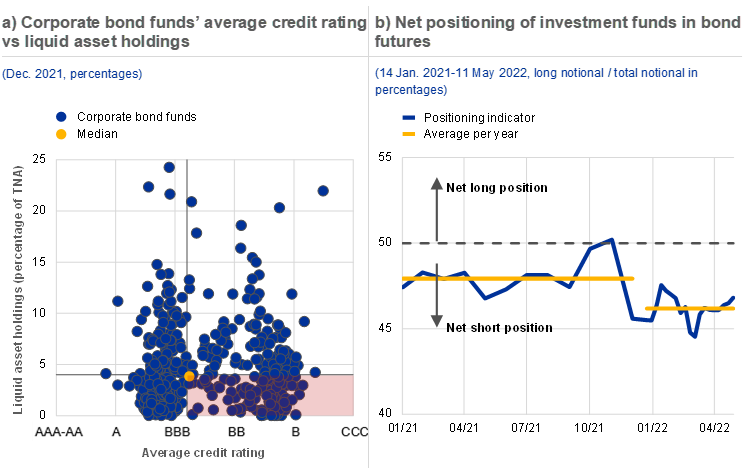
Sources: Refinitiv, ECB (Centralised Securities Database and European Market Infrastructure Regulation) and ECB calculations.
Notes: Panel a: the scatter plot shows a sample of 458 corporate bond funds domiciled in the euro area irrespective of invested credit quality. One dot represents one fund. Liquid assets include cash, cash equivalents, and government, supranational and central bank bonds from euro area issuers or from other issuers, if the rating is at least AA-, similar to Level 1 high-quality liquid asset (HQLA) bonds according to Basel liquidity coverage ratio requirements for HQLA (Commission Delegated Regulation (EU) 2015/61*). 12 funds were removed from the chart as outliers as they had negative liquid asset holdings or liquid asset holdings above 25%. Grey lines represent median liquid asset holdings and median average credit rating. Panel b: monthly data for 2021 and weekly data for 2022. The yellow line indicates the average for the monthly values in 2021 and for the weekly values in 2022. The dashed grey line indicates 50%, the neutral position for which long and short notional are of same size.
*) Commission Delegated Regulation (EU) 2015/61 of 10 October 2014 to supplement Regulation (EU) No 575/2013 of the European Parliament and the Council with regard to liquidity coverage requirement for Credit Institutions Text with EEA relevance (OJ L 11, 17.1.2015, p. 1).
Investment funds remain vulnerable to shocks stemming from duration and credit risk amid low liquidity buffers. Investment funds’ duration exposure has remained elevated in recent quarters. As a result, bond funds continue to be vulnerable to losses stemming from increases in yields. Corporate bond funds are also exposed to credit risk, while median liquid holdings remain low. Funds with low credit quality and low liquid asset holdings – around a quarter of funds in the sample observed – are especially vulnerable (Chart 4.5, panel a). Risks to such funds could amplify adverse market developments going forward if the funds had to engage in forced asset sales due to their low liquid holdings being insufficient to cover large-scale redemptions triggered by portfolio losses. At the same time, the investment fund sector has had a small, but increased, net short position in bond futures since the beginning of the year. This indicates that direct portfolio revaluation losses from higher interest rates might be partly mitigated by hedging strategies (Chart 4.5, panel b).[51]
Some funds exhibit additional vulnerabilities from investments in crypto-assets or heavy use of synthetic leverage. Asset managers have started to move into Bitcoin and other crypto-assets in response to growing demand from their clients. Should such exposures grow further, risks stemming from this asset class could spill over to other financial institutions (Special Feature B). Funds can also take on further risks by leveraging up their positions, either financially through borrowing or synthetically through derivatives. Synthetic leverage, which is difficult to quantify, can materialise through margin calls and uncovered counterparty exposure during periods of high market volatility. In particular, while margining provides coverage for counterparty exposure in derivative positions, a significant rise in margin calls can result in a gap in such coverage and can also lead to potential liquidity stress (Box 7).[52] The potential for spillover effects from the investment fund sector to the wider financial system and real economy amid high liquidity mismatch and pockets of leverage highlights the need to strengthen its resilience from a macroprudential perspective (Chapter 5).
Box 7
Synthetic leverage and margining in non-bank financial institutions
Synthetic leverage has become an important feature of the financial system. It refers to the exposure embedded in derivative contracts. These instruments enable market participants to take on synthetic market exposure, sometimes at little cost (for certain types of derivatives and underlying assets), and allow them to amplify gains at the risk of magnifying losses. Leverage tends to be less strictly regulated in parts of the non-bank financial sector than it is for banks, and non-bank institutions are able to increase leverage synthetically at little cost. During events such as the failure of Long-Term Capital Management and the collapse of AIG, and more recently Archegos, losses on derivative exposures spread to bank counterparties.
4.3 Insurers face near-term headwinds from inflation, while benefiting from rising interest rates
Euro area insurers are indirectly affected by the Russia-Ukraine war and associated sanctions amid pre-existing elevated vulnerabilities. In the weeks preceding the Russian invasion of Ukraine, insurance companies’ stock prices had started to decline on the back of growing uncertainty and continued to do so after the event (Chart 4.6, panel a). As was the case for other financial sectors, insurers’ equity prices fell by more than the broad market before temporarily recovering in mid-March and falling again amid high market uncertainty. While aggregate direct exposures to Russian assets are very limited (Chart 4.1, panel b), the war has exacerbated inflation risks (Chapter 2), increased uncertainty and could be a catalyst for broader asset repricing, especially in energy-intensive sectors (Chart 4.2, panel a). These developments could dampen insurers’ near-term profitability and solvency.
Chart 4.6
Insurers’ equity prices declined by more than broad market indices, but profitability and solvency positions remain solid

Sources: Refinitiv, Bloomberg Finance L.P. and ECB calculations.
Notes: Panel a: the chart shows daily observations. Panels b and c: the charts are based on a sample of 25 large euro area insurers offering life and non-life products.
Despite these threats, insurers’ solvency and profitability remain strong. At the end of 2021, euro area insurers’ Solvency Capital Requirement (SCR) ratio remained well above the regulatory minimum of 100% (Chart 4.6, panel b), despite a small decrease in the second half of 2021 amid more general risk-off sentiment. The SCR ratio is likely to decrease further in the first months of 2022 on account of lower equity valuations and higher credit spreads. This decline might be offset by rising interest rates and the volatility adjustment.[54] Profitability was above pre-pandemic levels at the end of 2021 (Chart 4.6, panel c), despite a small decline in the third quarter of 2021 attributable to increased insured losses from natural catastrophes.
Chart 4.7
Insurers’ profitability is exposed to inflated claims and claim normalisation in the aftermath of the pandemic

Sources: ECB (Insurance Corporations Statistics and Insurance Corporations Operations) datasets and ECB calculations.
Notes: Panel b: insurance technical reserves consist of the actuarial reserves covering all outstanding potential claims by policyholders. Technical reserves constitute the largest share of insurers’ liabilities.
While insurers face challenges from increased inflation risk and rising claims frequency, they could benefit from higher interest rates. In the short term, inflationary pressures could affect profitability because of higher than anticipated future claims payments (for example, if claims costs increase by more than insurers estimated when calculating their reserves). This might be particularly relevant for those segments of the non-life insurance sector facing more intense competition and rising claim frequencies as economies reopen (Chart 4.7, panel a). While only representing around 10% of total insurance technical reserves[55], euro area non-life insurers decreased their reserves in the last quarter of 2021 (Chart 4.7, panel b). Furthermore, persistent higher inflation could affect insurance affordability, which would influence new business and increase lapse rates. That said, higher inflation is likely to be associated with higher long-term interest rates. This is particularly relevant for life insurers, where higher interest rates reduce investment risks and make rate guarantees to policyholders easier to service. More broadly, a gradual shift towards a higher interest rate environment would benefit the insurance sector overall thanks to negative duration gaps, meaning that reductions in insurers’ liabilities would normally more than offset asset valuation losses.
Chart 4.8
Exposures of euro area insurers to alternative assets, particularly to real estate, have continued to increase across all types of business
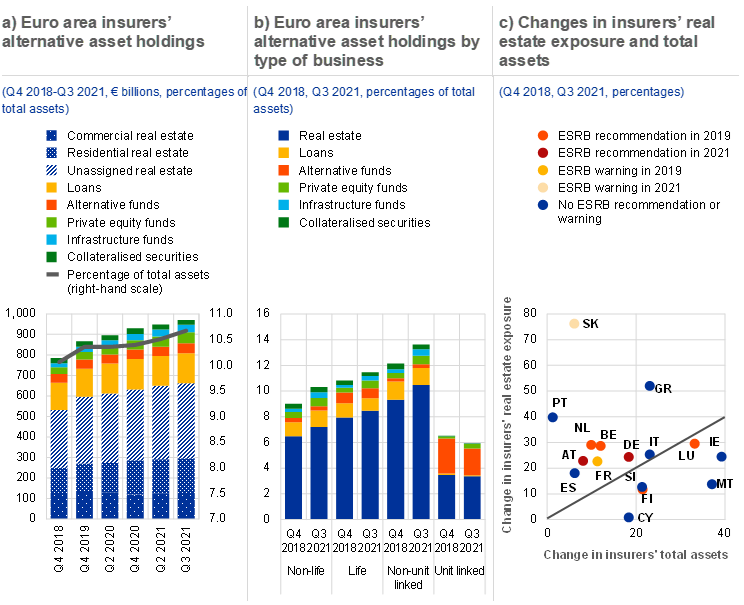
Sources: EIOPA and ECB calculations.
Notes: Panels a, b and c: the charts are based on aggregate asset exposure statistics published by EIOPA (solo Solvency II reporting; template S.06.02). The “real estate” category includes exposures to residential and commercial properties (excluding those for own use), mortgages, corporate bonds and the equity of real estate-related corporations and real estate funds. Panel b: the chart is based on a set of 14 euro area countries for which a split between exposures of life and non-life insurers is available. Panel c: data points for Estonia, Latvia and Lithuania are not shown.
While interest rates may rise going forward, prolonged low interest rates in recent years have affected insurers’ business activities. Low rates fuelled an increase in insurers’ holdings of alternative assets, which now represent about 10.5% of insurers’ total assets (Chart 4.8, panel a).[56] Increased exposure to alternative assets is common across different types of insurer (Chart 4.8, panel b) but is more pronounced for non-unit linked life insurers, which faced the greatest squeeze in the low interest rate environment. Investment in alternative assets can help insurers tackle profitability concerns and diversify their portfolio if they maintain a sufficient level of liquidity. However, exposure to higher-yielding and illiquid alternative assets might also contribute to wider financial sector exuberance in markets such as real estate. Real estate-related investments (both residential and commercial) account for more than two-thirds of insurers’ alternative asset exposures and have grown by over 25% since 2018. This expansion has outpaced growth in insurers’ total assets in most euro area countries, including those that received an ESRB recommendation linked to real estate in December 2021 (Chart 4.8, panel c).[57] Property price corrections are more likely to occur in overvalued markets, increasing the risk of material valuation losses in insurers’ portfolios in such countries (Chapter 1).
Over the longer term, insurers will continue to face several structural vulnerabilities, such as climate change and cyber security. Estimated global insured losses of USD 111 billion made 2021 one of the costliest years ever in terms of natural catastrophes, particularly for some euro area countries.[58] Last summer’s floods in Belgium, Germany and the Netherlands generated economic losses of more than USD 40 billion and insured losses of USD 13 billion, putting the insured loss potential from a single flood on a par with losses from primary peril events such as earthquakes or winter storms. The rising frequency of severe flood events due to climate change and the growing magnitude of associated losses have also pushed up reinsurance prices. This adds to the profitability challenges faced by non-life insurers and might widen protection gaps (the proportion of economic losses that are not covered by insurance), with potential adverse consequences for the wider macroeconomy.[59] Insurers are also struggling to provide coverage against cyber risk amid growing demand driven by the increased frequency and severity of ransomware incidents in 2021. In addition, the war in Ukraine may increase the risk of large cyberattacks. Available insurance capacity for cyber risk currently appears to be limited by lack of expertise, data availability issues and inappropriate modelling.[60]
5 Macroprudential policy issues
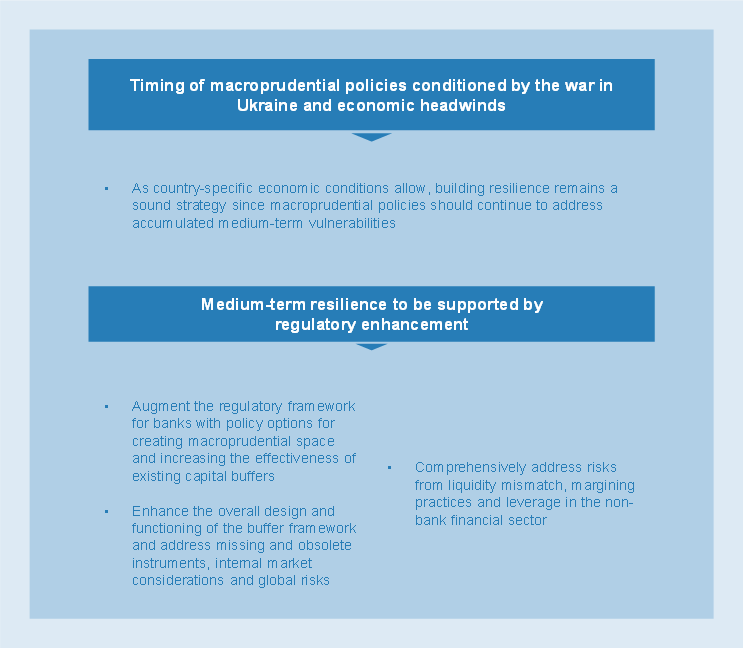
5.1 Setting the appropriate pace of policy action to address medium-term vulnerabilities
Several euro area macroprudential authorities had already started to tighten some of their policies prior to the outbreak of war in Ukraine. At the end of 2021 and beginning of 2022, the near-term economic outlook revolved around the strong recovery continuing, on the back of robust labour markets and gradually receding pandemic headwinds. At the same time, vulnerabilities with macroprudential policy relevance continued to build-up. This was especially significant for residential real estate markets, but also occurred more broadly, on the back of robust credit growth and increasing indebtedness in the non-financial private sector (Chart 5.1, panel a).[61] Against this background, several macroprudential authorities have taken action and tightened capital-based and/or borrower-based measures of late.[62]
Chart 5.1
Cyclical risks continued to accumulate during the pandemic while banks’ capital headroom remains sizeable
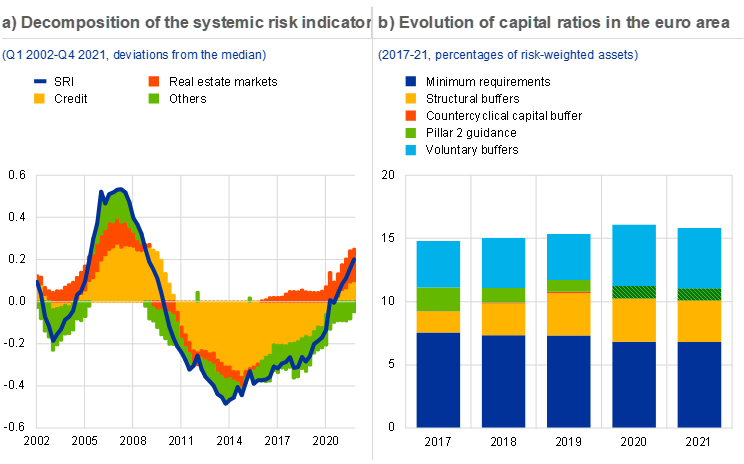
Sources: Eurostat, ECB, ECB (Supervisory Banking Statistics) and ECB calculations.
Notes: Panel a: the systemic risk indicator (SRI) measures the build-up of risks from credit developments, real estate markets, asset prices and external imbalances; it has better early warning properties for financial crises in European countries than the Basel credit-to-GDP gap. The SRI is based on Lang et al.* “Credit” includes contributions of the two-year change in the bank credit-to-GDP ratio and the two-year growth rate of real total credit; “Real estate markets” denotes the contribution of the three-year change in the price-to-income ratio for residential real estate; “Others” includes the contributions of the current account-to-GDP ratio, the three-year change of real equity prices and the two-year change in the debt-service ratio. Panel b is based on a large sample of significant and less significant institutions, consolidated at the euro area level. Minimum requirements include P1 CET1 + P1 shortfall AT1/T2 + P2R, while structural buffers include CCoB + O-SII/G-SII + SyRB. The bars displaying the P2 guidance (P2G) for 2020 and 2021 are shaded to indicate the full usability of the P2G buffer during the pandemic.
*) Lang, J.H., Izzo, C., Fahr, S. and Ruzicka, J., “Anticipating the bust: a new cyclical systemic risk indicator to assess the likelihood and severity of financial crises”, Occasional Paper Series, No 219, ECB, 2019.
While building further resilience in a timely manner remains a robust policy strategy, the timing and pace of the prudential response needs to take country-specific economic conditions into account. Banks have ample capital headroom on top of their regulatory requirements (Chart 5.1, panel b). Moreover, a vulnerability analysis specifically assessing the consequences of the war in Ukraine indicates that the euro area banking system remains resilient under the scenarios considered (Box 6). Nevertheless, authorities should closely monitor the potential repercussions of the heightened uncertainty. Macroprudential policy action should seek to further enhance resilience against risks materialising from vulnerabilities that have already accumulated. At the same time, the macroprudential policy response should consider near-term headwinds to economic growth, including those related to energy price developments and broader confidence effects, and should not result in an unintended tightening of credit conditions. If economic conditions were to deteriorate markedly, macroprudential authorities could still act swiftly to provide banks with the necessary flexibility, although additional macroprudential tools could further enhance the toolkit, including for exceptional circumstances.[63]
Notwithstanding the uncertainty, macroprudential authorities should continue to address existing vulnerabilities, as conditions allow. Prior to the outbreak of the war, conditions for addressing the continued build-up of vulnerabilities in several euro area countries appeared to be favourable. The economic cost (via the impact on credit conditions) of activating additional capital buffers appeared to be low, especially set against the benefits of enhancing resilience sufficiently early to counter identified vulnerabilities (without necessarily reducing them in the near term) and to facilitate the response to the materialisation of systemic risk (Box 8). Moreover, capital buffers are important complements to borrower-based measures when addressing real estate vulnerabilities,[64] in particular over the short term, as the additional resilience benefits of the borrower-based policies accumulate only gradually over time. Accordingly, authorities should stand ready to respond promptly to accumulated vulnerabilities, taking into account the uncertainty surrounding the economic developments. The associated calibration of instruments should balance risk signals, uncertainty in risk measurement and the possible costs of policy action in terms of reduced credit supply. Overall, existing bank capital generation capacity and headroom should mitigate a detrimental impact on credit supply from increasing capital buffers, as long economic conditions do not deteriorate significantly. Moreover, there are also costs associated with delayed action, in particular if uncertainty persisted into the medium term and vulnerabilities remained unaddressed or continued to build.
Over the medium term, the resilience of the financial system would be reinforced by creating more macroprudential space through an increase in the amount of releasable buffers, complemented by enhancing the effectiveness of the existing countercyclical capital buffer (CCyB). Recent experience, including from the coronavirus (COVID-19) pandemic, shows that at the onset of severe stress episodes, banks that have limited capital space above regulatory buffers relative to their peers tend to adjust their balance sheets by reducing lending.[65] In its recent response to the European Commission’s call for advice on the review of the macroprudential framework, the ECB called for more macroprudential policy space in the form of a higher amount of releasable capital buffers. It argued that this would further improve banks’ capacity to absorb losses while maintaining the provision of key services in a downturn. The policy options identified in the ECB response were (a) a fully or partially releasable capital conservation buffer (CCoB); (b) a positive neutral rate for, or more active use of, the countercyclical capital buffer (CCyB); (c) a core rate for the releasable systemic risk buffer (SyRB); or a possible combination of the three.[66] In addition, the response suggested that flexibility in the CCyB framework be increased to foster timely policy action in both the activation and the release phases. This could be achieved by adjusting the design or the calibration of existing buffers.[67]
Box 8
Transmission and effectiveness of capital-based macroprudential policies
One important lesson learned from the use of capital-based macroprudential policies in recent years is that tightening such policies during boom phases is unlikely to have a notable impact on credit supply and the build-up of imbalances, while the accumulated resilience and the release of buffers in downturns produces large benefits. Capital-based policies are particularly relevant to the ECB since they are a focal point for the ECB’s macroprudential tasks as enshrined in European legislation.[68] A prime example of a capital-based tool is the countercyclical capital buffer (CCyB). This instrument was designed in the aftermath of the global financial crisis to enhance the resilience of the financial system and reduce procyclicality.[69] Enacting capital-based policies such as the CCyB directly enhances banking system resilience by inducing banks to increase their capital ratios. Further transmission to the real economy by way of effects on bank credit supply depends on overall economic conditions and the relevance of capital constraints in the banking sector. While such constraints are unlikely to be binding when capital buffers are activated during economic booms, the coronavirus (COVID-19) pandemic has shown that the release of buffers and other requirements in a downturn can ease binding constraints and effectively support credit supply and economic activity.[70]
The current review of the EU macroprudential framework provides an important opportunity to improve the overall design and functioning of the buffer framework and address missing and obsolete instruments, internal market considerations and global risks.[71] The ECB has proposed actions to fill other gaps in the policy toolkit, promote the enhanced use of instruments at the national level (including supporting national authorities in using borrower-based measures by enhancing the comparability of both risk assessments and policy actions across jurisdictions, achieved by harmonising lending standards indicators), enhance information-sharing, streamline the activation and coordination procedures of macroprudential measures and address global risks. The set of legislative proposals potentially resulting from the review would aim to make the regulatory framework more consistent and streamlined, which would allow macroprudential authorities to react to emerging risks to financial stability in a more effective, flexible and timely manner.
Timely macroprudential policy action complements a data-dependent approach to monetary policy normalisation. If the need to counter inflation leads to gradual monetary policy normalisation under fragile economic conditions, medium-term risks could materialise earlier than anticipated. In this context, timely and cautious macroprudential policy action can help to build the necessary additional resilience against the materialising risks when needed, while avoiding procyclical effects if economic conditions deteriorate. Over a longer-term horizon, risks to financial stability could decline under monetary policy normalisation, as some of the factors driving the build-up of vulnerabilities, such as historically low borrowing costs or search-for-yield behaviour, could be mitigated. However, such potential longer-term developments should not preclude macroprudential action in the short to medium term if conditions allow, as this may be needed to address vulnerabilities that have already built up or may continue to build going forward.
5.2 Addressing both liquidity mismatch and leverage in the non-bank financial sector
It is essential to develop the policy framework for non-bank financial intermediation from a macroprudential perspective if structural vulnerabilities are to be tackled and the sector’s resilience strengthened. In particular, risks related to liquidity mismatches, leverage and margining practices have become evident during periods of market stress over recent years, including during the March 2020 market turmoil.[72] Given the increasing role played by non-bank financial institutions in financing the real economy[73] and their interconnections with the wider financial system[74], these vulnerabilities need to be tackled to mitigate system-wide risks.
During the past year, important progress has been made on reforming money market funds (MMFs), which came under severe stress in March 2020. The Financial Stability Board (FSB) has issued policy proposals aimed at tackling vulnerabilities in MMFs internationally.[75] These proposals aim to increase the resilience of MMFs by reducing liquidity mismatches and cliff effects arising from possible breaches of regulatory thresholds. In response to a consultation launched by the European Securities and Markets Authority (ESMA), a discussion of the reform proposals from the Eurosystem was also published in 2021[76], followed by a similar document from the ECB earlier this year.[77] The Eurosystem supports increasing the share of liquid assets and better diversifying liquidity buffers through minimum public debt requirements, which would strengthen MMF resilience. These proposals are also reflected in the recent ESRB recommendation[78], which serves to inform the European Commission’s ongoing review of the EU’s Money Market Fund Regulation.[79]
The focus of the international policy agenda has now shifted to structural liquidity mismatches in the broader investment fund sector. During 2022, the FSB will assess the effectiveness of its 2017 recommendations on liquidity mismatch in open-ended funds and consider what additional steps may be needed to address potential shortcomings.[80] A key priority should be to better align asset liquidity with redemption terms. There are various ways to achieve this, depending on the type of fund or underlying assets involved. These include mandating minimum notice periods, implementing lower redemption frequencies and requiring a certain level of portfolio liquidity by setting limits on less liquid assets or stipulating liquidity buffers. Liquidity management tools, such as swing pricing, anti-dilution levies, gates and suspensions, can usefully complement such measures, but they might be less effective in reducing systemic risk and mitigating the build-up of structural vulnerabilities before the event.[81]
The recent sharp increases in margin calls related to energy and commodity derivatives have further underlined the need to review margining practices. Clearing members and their clients faced high margin calls both following recent increases in volatility in energy and commodity prices and previously during the March 2020 market turmoil with respect to a broader set of underlying assets.[82] Although the recent episode has not yet resulted in a wider dash for cash, it has once again highlighted the need to advance international work on margining practices as a matter of priority. This work should focus in particular on increasing the transparency of initial margin models, evaluating the initial margin model’s responsiveness to market stress and enhancing the preparedness of non-banks from a liquidity risk perspective.[83], [84]
The use of leverage in a highly interconnected global financial system is a key financial stability concern which needs to be tackled using a comprehensive set of measures across entities and activities. Excessive leverage in the non-bank financial sector can increase the likelihood of default, with possible spillovers to banks and the broader financial system. The default of the Archegos family office in March 2021, and associated losses for banks, highlighted the close interconnections across bank and non-bank financial institutions globally. It also underlined how derivatives can be used to create leverage synthetically, including the important role of margining (Box 7). Furthermore, leverage in open-ended investment funds, even at moderate levels, can have a procyclical effect on the behaviour of asset managers and investors and thereby amplify other vulnerabilities, such as those arising from liquidity mismatches.[85] Given the complexities of addressing risks stemming from non-bank leverage, the policy framework should be enhanced along three main dimensions – a non-bank (“client”), a bank and an activity dimension.
- First, policies should aim at ensuring a consistent approach to leverage rules for non-bank entities, such as across the Alternative Investment Fund Managers Directive (AIFMD) and the Undertakings for the Collective Investment in Transferable Securities (UCITS) Directive. Supervisors should also take an active role in identifying excessively leveraged institutions and tackling the resulting risk. These measures would help to limit systemic risk from leveraged non-bank entities, while allowing for differentiated levels of permissible leverage, depending on the type of institution.[86] It is also important for such issues to be further discussed at the global level as part of the FSB agenda.
- Second, it is important to enhance risk management practices and regulation for dealer banks which either lend to non-bank financial institutions facing lighter or no leverage constraints or act as counterparties in derivatives transactions which embed synthetic leverage. Such rules usually aim at safeguarding banks from concentrated exposures and should be calibrated to the clients’ total risk position, including from leverage.
- Third, policies around haircuts and margins should reflect the possible indirect impact on synthetic leverage in derivatives portfolios. For instance, if initial margin requirements are set at very low levels in “good times”, this can allow entities that face limited leverage restrictions to magnify their exposure at low cost and with little additional funding. In this respect Archegos was a case in point. A higher level of initial margin in good times would increase the funding needs for leveraged positions, ultimately reducing the attractiveness of such trades while strengthening counterparty protection. In addition, further measures taken by central clearing counterparties or clearing members could be assessed in terms of their effectiveness in avoiding the build-up of large unbalanced positions. Any exploration of such policy options should also consider broader effects, including any possible side effects on the users of derivatives, such as limiting hedging opportunities, acknowledging the concentrated CCP market structure.
Moreover, globally consistent metrics and better data are needed to monitor synthetic leverage across the system, which should complement the International Organization of Securities Commissions’ (IOSCO) previous work on investment funds.[87] This may be supported by better international mechanisms for sharing data on leverage and derivatives across authorities.
5.3 Other ongoing policy initiatives that support euro area financial stability
Policy initiatives on climate change and crypto-assets
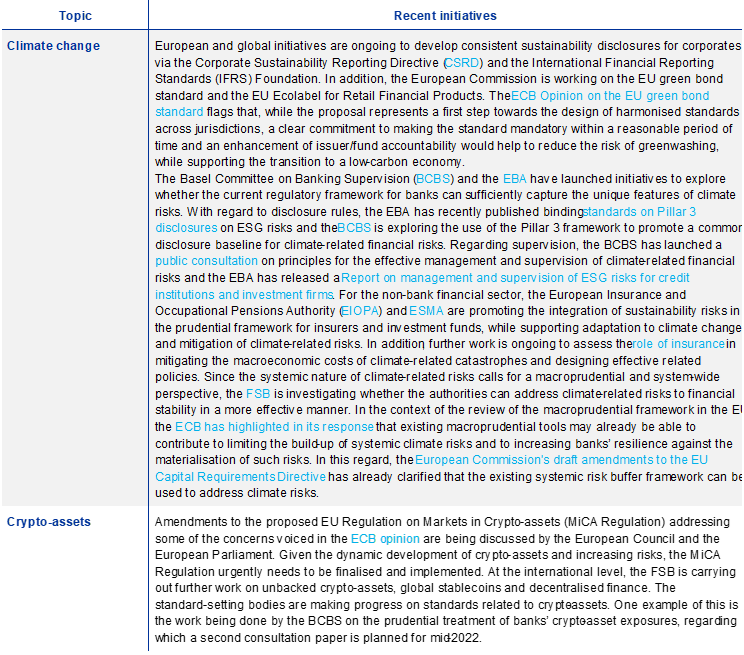
Updates on policy initiatives related to Basel III, the banking union and the capital markets union and Solvency II for reinsurance companies
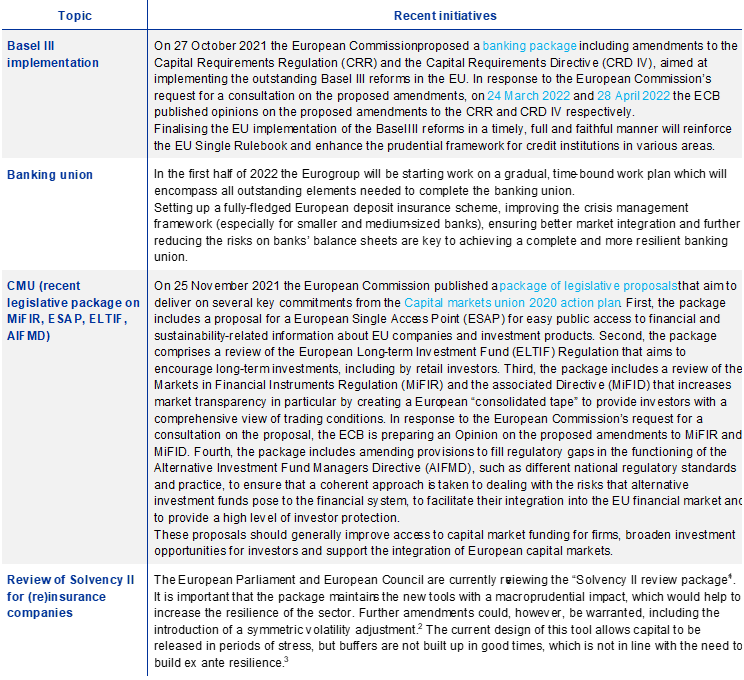
1) See the proposed amendments to the Solvency II Directive and the introduction of a new insurance recovery and resolution directive, adopted by the Commission in September 2021.
2) For further proposed amendments, see the ESRB letter to the European Parliament, 2 February 2022.
3) See also the ECB response to the European Commission’s call for advice on the review of the EU macroprudential framework, March 2020.
Special Features
Climate-related risks to financial stability
The ECB is continuing its work on incorporating climate-related risks into assessments of financial stability. This includes a new analysis of disclosure, pricing and greenwashing risks in financial markets, as well as continued monitoring of financial institutions’ exposure to transition and physical risks. There is some encouraging evidence of better disclosure by non-financial corporations and increasing awareness of climate-related risks in financial markets. Progress made by banks, however, has been more limited. Established and newer metrics show no clear evidence of a reduction in climate-related risks, revealing instead a potential for amplification mechanisms stemming from exposure concentration, cross-hazard correlation and financial institutions’ overlapping portfolios. These findings can inform evidence-based international and European policy debates around climate-related corporate disclosure, standards for sustainable financial instruments and climate-related prudential policies. More generally, amid high uncertainty around governments’ transition policies in an environment of volatile energy prices, further investments in the transition to a net-zero economy would also have a positive impact on medium-term growth and energy security.
Decrypting financial stability risks in crypto-asset markets
The stellar growth, volatility and financial innovation currently seen in the crypto-asset ecosystem, as well as the rising involvement of institutional investors, show how important it is to gain a better understanding of the potential risks that crypto-assets could pose to financial stability if trends continue on this trajectory. Systemic risk increases in line with the level of interconnectedness between crypto-assets and the traditional financial sector, the use of leverage and lending activity. It is important to close regulatory and data gaps in the crypto-asset ecosystem to mitigate such systemic risks.
The Financial Stability Review assesses the sources of risks to and vulnerabilities in the euro area financial system based on regular surveillance activities, analysis and findings from discussions with market participants and academic researchers.
The preparation of the Review was coordinated by the ECB’s Directorate General Macroprudential Policy and Financial Stability. The Review has benefited from input, comments and suggestions from other business areas across the ECB. Comments from members of the ESCB Financial Stability Committee are gratefully acknowledged.
The Review was endorsed by the ECB’s Governing Council on 18 May 2022.
Its contents were prepared by Katharina Cera, Nander de Vette, John Fell, Sándor Gardó, Benjamin Klaus, Julian Metzler, Benjamin Mosk, Tamarah Shakir, Manuela Storz, Eugen Tereanu, Josep M. Vendrell Simón and Jonas Wendelborn.
With additional contributions from Luca Bacciarelli, Emil Bandoni, Markus Behn, Paul Bochmann, Othman Bouabdallah, Lorenzo Cappiello, Olimpia Carradori, Dimitris Drollas, Michal Dvořák, Linda Fache Rousová, Maciej Grodzicki, Margherita Giuzio, Matilda Gjirja, Lieven Hermans, Paul Hiebert, Barbara Jarmulska, Sujit Kapadia, Jan Hannes Lang, Francesca Lenoci, Marco Lo Duca, Giulio Mazzolini, Barbara Meller, Luca Mingarelli, Seán O’Sullivan, Lorenzo Pangallo, Rita Periquito da Fonseca, Allegra Pietsch, Aurea Ponte Marques, Petya Radulova, Ellen Ryan, Julius Schneider, Martina Spaggiari, Mika Tujula, Dominik Vu, Michael Wedow, Christian Weistroffer and Balázs Zsámboki.
Editorial, multimedia and production assistance was provided by Anna Heckler, Will Knowles, Peter Nicholson, Katie Ranger, Simon Spornberger and Sophia Suh.
© European Central Bank, 2022
Postal address 60640 Frankfurt am Main, Germany
Telephone +49 69 1344 0
Website www.ecb.europa.eu
All rights reserved. Reproduction for educational and non-commercial purposes is permitted provided that the source is acknowledged.
For specific terminology please refer to the ECB glossary (available in English only).
PDF ISSN 1830-2025, QB-XU-21-002-EN-N
HTML ISSN 1830-2025, QB-XU-21-002-EN-Q
These were driven by higher than expected tax revenues, among others.
See the box entitled “Sensitivity of sovereign debt in the euro area to an interest rate-growth differential shock”, Financial Stability Review, ECB, November 2021.
This reflects consolidated debt securities and loans of non-financial corporations as a share of GDP.
For more details, see Casey, C.J., Bibeault, D. and Altman, E.I., “Corporate financial distress: A Complete guide to Predicting, Avoiding, and Dealing with Bankruptcy”, Journal of Business Strategy (pre-1986), Vol. 5, Issue 000001, 1984, p. 102f.
See also the article entitled “Assessing corporate vulnerabilities in the euro area”, Economic Bulletin, Issue 2, ECB, 2022.
The results reported in this box pertain to the specific sample at hand, which is not fully representative for the overall corporate sector as it contains relatively fewer micro firms.
See also the report “Vulnerabilities in the residential real estate sectors of the EEA countries”, ESRB, February 2022 and the overview of macroprudential measures.
Nominal house price growth in the euro area amounted to 9.6% in the fourth quarter of 2021, the second-highest rate since the first quarter of 2005, exceeded only by the growth rate of the third quarter of 2021.
See Box 2 entitled “Assessing the strength of the recent residential real estate expansion”, Financial Stability Review, ECB, November 2021. For tests of house price exuberance across advanced economies, see a modified unit root test of real house price growth in Pavlidis, E. et al., “Episodes of Exuberance in Housing Markets: In Search of the Smoking Gun”, Journal of Real Estate Finance and Economics, Vol. 53, Issue 4, November 2016, pp. 419-449, and the updated assessment based on this test provided by the Federal Reserve Bank of Dallas.
Average nominal euro area mortgage lending rates reached historic lows in 2021, and increased slightly at the start of 2022, back to levels observed in 2020.
As of 17 May 2022.
For example, Bank of America’s December Global Fund Manager Survey showed that a net 31% of fund managers were “bullish” on euro area equities. US equities came in second with a net 18% of fund managers.
In the monthly Bank of America Global Fund Manager Surveys conducted between December 2021 and February 2022, fund managers saw “Hawkish central bank rate hikes” as the biggest tail risk. In the March 2022 survey, this position was overtaken by “The Russia-Ukraine conflict”. The April survey listed “Global recession” as the largest risk (26%), closely followed by “Hawkish central banks” (25%). The leading position was taken once again by “Hawkish central banks” (31%) in the May edition.
In the ECB Survey of Monetary Analysts, the December 2021 results showed December 2023 as the median expected timing of the next increase in the deposit facility rate. This median had shifted forward by more than one year to September 2022 in the April survey results. In addition, the Bloomberg Economist Survey conducted between 1 and 6 April 2022 found -0.25% to be the median expectation for the deposit facility rate for December 2022 compared with a median expectation of -0.5% in the survey conducted between 8 and 14 December 2021.
See the Box entitled “Risk of spillovers from US equity market corrections to euro area markets and financial conditions”, Financial Stability Review, May 2021, ECB.
As measured by the standard deviation of the option-implied probability density functions.
In this exercise, the excess cyclically adjusted price/earnings (CAPE) yield, which is sometimes interpreted as the equity risk premium, is held constant. In addition, cyclically adjusted earnings – by design a relatively stable variable based on a long-term inflation-adjusted average – are also held constant. It would be possible to relax the assumption of a fixed equity risk premium, and in theory, there could even be a relationship between the equity risk premium and the risk-free interest rate. Evidence presented below (Chart 2.7) suggests that credit risk premia have shown a positive relationship with risk-free rates more recently. There have been historical episodes with both positive and negative relationships between the risk-free rate and the equity risk premium.
For example, between 17 November 2021 and 17 May 2022 the Nasdaq Composite declined by 25 percent. Sources: Bloomberg, ECB calculations.
Between 17 November 2021 and 17 May 2022 the Bitcoin lost 50 percent of its value versus the US dollar. Sources: Bloomberg, ECB calculations.
See also “The expanding functions and uses of stablecoins”, Financial Stability Review, ECB, November 2021.
See the updated “Assessment of Risks to Financial Stability from Crypto-assets”, Financial Stability Board, February 2022.
See the box entitled “Natural gas dependence and risks to euro area activity”, Economic Bulletin, Issue 1, ECB, 2022.
For most financial assets, the “risk reversal” – the difference between call and put option prices with the same exercise date and similar sensitivity to the underlying (delta) – is usually negative.
A number of smaller, relatively unhedged UK energy utilities have recently defaulted; see, for example, “Losing their hedge: why so many UK energy suppliers went bust”, Risk.net, 4 November 2021.
In March 2022, the applied margin by ICE Clear Europe to the active Dutch TTF Natural Gas Futures Contract amounted to above 80% of the futures price on several days. Sources: ICE Clear Europe, Bloomberg L.P. and ECB calculations.
In addition to initial margin, counterparties to a derivative trade also exchange variation margin, which moves mechanically with the price of the contract.
As margin requirements increased, open interest, weighted by contract size, showed some migration from the Intercontinental Exchange (ICE) towards the European Energy Exchange (EEX) for natural gas futures contracts. This may be related to differences in contract maturities and characteristics – but could also be related to differences in margining requirements. Sources: Bloomberg L.P. and ECB calculations.
See, for example, the Eurosystem and ECB staff macroeconomic projections.
In response to these developments, the Governing Council has stated that “If the incoming data support the expectation that the medium-term inflation outlook will not weaken even after the end of its net asset purchases, the Governing Council will conclude net purchases under the APP in the third quarter [of 2022]” (ECB Monetary Policy Decisions, 10 March 2022). In addition, the Governing Council has stated that it “judged that the incoming data since its last [April] meeting reinforce its expectation that net asset purchases under the APP should be concluded in the third quarter” (ECB Monetary Policy Decisions, 14 April 2022).
See Box 4 entitled “Downside Risks from Property Developer Stress”, Staff Report, International Monetary Fund, January 2022.
See Arslanalp, S. et al., “China’s Growing Influence on Asian Financial Markets”, IMF Working Papers, No 2016/173, International Monetary Fund, 2016, which documents how spillovers from China to Asian equity markets have increased during the period since the global financial crisis, though they remain lower than those from the United States.
However, the foreign ownership of the Chinese onshore bond market remains relatively low, accounting for around 4% of the total market.
Forbearance measures are concessions towards an obligor that is experiencing or is likely to experience difficulties in meeting its financial commitments. A modified contract is classified as performing if it has been classified as performing before the modification or would not be classified as non-performing in the absence of modification.
See the SSM letter to CEOs on leveraged transactions. See also the ECB opinion piece on Financial leverage and banks’ risk control.
Although linkages of euro area banks with Russia are limited to a few banks, exposures and deposits are not always located in the same entity but often separated between subsidiary and parent company.
For details on the identification and dependence of euro area firms on natural gas, see the box entitled “Natural gas dependence and risks to euro area activity”, Economic Bulletin, Issue 1, ECB, 2022.
For more details, see Casey, C.J., Bibeault, D. and Altman, E.I., “Corporate financial distress: A Complete guide to Predicting, Avoiding, and Dealing with Bankruptcy”, Journal of Business Strategy, Vol. 5, No 1, 1984, p. 102. See also the box entitled “Identifying the corporates most vulnerable to price shocks following the pandemic shock” in this edition of the Financial Stability Review.
3.8% of total corporate loans refers to exposures to corporates reliant on a high share of energy input to generate outputs as well as weak corporate fundamentals as measured by z-scores.
Universal and investment banks usually have the capacity to run proprietary trading, maintain a trading desk and play an active role in the derivatives market.
In the Financial Stability Review, the four-quarter average of stock variables is used, while flow variables are annualised using trailing four-quarter sums. In addition, to avoid composition effects, a balanced sample of banks is used, which might result in figures which are different from those in the published supervisory banking statistics.
See the special feature entitled “Euro area bank profitability: where can consolidation help?”, Financial Stability Review, ECB, November 2019.
The duration gap measures the mismatch between the repricing timing of cash inflows (assets) and cash outflows (liabilities) of instruments which are already on banks’ balance sheet. A positive duration gap indicates that the duration of assets is larger than the duration of liabilities. In this analysis, the duration gap is computed as in Esposito et al. (see Notes to Chart A) using supervisory data on behavioural cash flows for 62 euro area banks.
For more details, see the ECB Survey of Monetary Analysts, April 2022.
In the Financial Stability Review, the four-quarter average of total equity is used in the denominator, while net income is annualised using trailing four-quarter sums. In addition, to avoid composition effects, a balanced sample of banks is used, which might result in a figure for headline profitability which is different from that in the published supervisory banking statistics.
See the EBA 2021 EU-Wide Stress Test Methodological Note for details.
For an analysis of the determinants of NFCs’ decisions to issue debt, see also the article entitled “Market-based finance for corporations: Demand and supply of credit”, Economic Bulletin, Issue 4, ECB, forthcoming.
Exposures shown are based on broader non-financial sectors. The overall potential impact from rising energy prices may also vary depending on the allocation of portfolios across more or less energy-intensive subsectors within each sector.
See the box entitled “Measuring market-based and non-bank financing of non-financial corporations in the euro area”, Financial Integration and Structure in the Euro Area, ECB, April 2022.
77 funds in a sample of 9,624 funds with a Russian exposure greater than 0 in December 2021 (Refinitiv Lipper).
See the box entitled “Interconnectedness of derivatives markets and money market funds through insurance corporations and pension funds”, Financial Stability Review, ECB, November 2020.
This does not rule out the possibility of individual funds taking a stronger net short position or other interest rate derivatives such as swaps also being used for hedging purposes.
Further to the analysis on equity derivates in Box 7, there is evidence that some euro area bond funds and hedge funds are highly leveraged (see the special feature entitled “Towards a framework for calibrating macroprudential leverage limits for alternative investment funds”, Financial Stability Review, ECB, November 2016 and “EU Alternative Investment Funds”, Annual Statistical Report, ESMA, February 2022).
The authors express their gratitude to Linda Fache Rousová and Lorenzo Cappiello for their contributions and valuable feedback.
A regulatory mechanism that allows insurers to moderate the effect of falling bond prices on their capital under Solvency II.
See Euro area insurance corporation statistics: fourth quarter of 2021.
See also the box entitled “Insurers’ investment in alternative assets”, Financial Stability Review, ECB, May 2019.
See ESRB issues new warnings and recommendations on medium-term residential real estate vulnerabilities, ESRB, February 2022.
See, for example, Natural catastrophes in 2021: the floodgates are open, Swiss Re Institute, March 2022.
See Fache Rousová et al., “Climate change, catastrophes and the macroeconomic benefits of insurance”, Financial Stability Report, EIOPA, July 2021.
See the special theme entitled “Cyber risk and the European insurance sector”, Financial Stability Report, EIOPA, December 2021.
See “Vulnerabilities in the residential real estate sectors of the EEA countries”, ESRB, February 2022 and the associated recommended further policy actions in a number of European countries.
Authorities have decided to increase the countercyclical capital buffers (Bulgaria, Germany and France), activate a sector-specific systemic risk buffer (Germany, Lithuania and Slovenia) or strengthen the application of borrower-based measures (France, Latvia, Portugal and Finland). In addition, the ECB has also communicated that on the basis of ample headroom above capital and the leverage ratio requirements, banks are expected to operate above Pillar 2 guidance from January 2023 and to include central bank exposures in the leverage ratio once again from April 2022 (see the ECB Banking Supervision press release of 10 February 2022).
The policy chapters of the ECB’s Financial Stability Reviews in 2020 and 2021 provide an overview of the substance and the sequencing of prudential support measures during the pandemic. On the need to enhance the macroprudential toolkit, see the ECB response to the European Commission’s call for advice on the review of the EU macroprudential framework.
Borrower-based measures have been called for in the context of addressing the build-up of vulnerabilities in real estate markets (see the above ESRB report on vulnerabilities in residential real estate or the Financial Stability Review, ECB, November 2021).
See the special feature entitled “Bank capital buffers and lending in the euro area during the pandemic”, Financial Stability Review, ECB, November 2021; and Couaillier et al., “Caution do not cross! Capital buffers and lending in Covid-19 times”, Working Paper Series, No 2644, ECB, 2022.
The ECB is aware that creating more macroprudential policy space and facilitating the effective use of released buffers may also require additional work at the international level to better address shocks that may go beyond the unwinding of domestic imbalances and to ensure a global level playing field.
This can be achieved by moderating the dominant role of the credit-to-GDP ratio in the CCyB rate-setting practices of national authorities and by allowing for a shorter transitional period than one year for the implementation of CCyB decisions.
For an overview of the ECB’s macroprudential policy framework, see the chapter entitled “Topical issue: The ECB’s macroprudential policy framework”, Macroprudential Bulletin, Issue 1, ECB, 2016; for an overview of macroprudential policy and powers within the Eurosystem, see the box entitled “Macroprudential policy and powers within the Eurosystem”, Financial Stability Review, ECB, November 2019.
For a comprehensive discussion of the objectives and the rationale of the capital buffer framework, see, for example, the article entitled “Macroprudential capital buffers – objectives and usability”, Macroprudential Bulletin, ECB, October 2020.
For an analysis on the effects of capital release measures during the pandemic see, for example, the special feature entitled “Bank capital buffers and lending in the euro area during the pandemic”, Financial Stability Review, ECB, November 2021. Besides the CCyB, which made up only 0.1% of risk-weighted assets in the banking union before the COVID-19 pandemic, the analysis also considers the release of other buffers (such as the Systemic Risk Buffer) and the one-off change in the composition of microprudential Pillar 2 requirements (which effectively decreased banks’ CET1 capital requirements). The coupling of capital release measures with monetary policy action in the form of liquidity provision can help to further ease binding constraints and enhance banks’ risk-bearing capacity. See, for example, Altavilla, C. et al., “The great lockdown: pandemic response policies and bank lending conditions”, Working Paper Series, No 2465, ECB, September 2020, for an analysis of the complementarities between monetary policy and prudential policy.
See the ECB response to the European Commission’s call for advice on the review of the EU macroprudential framework. The European Commission is required to review the macroprudential provisions in the European legislation by June 2022 and is expected to prepare a legislative proposal by December 2022. In this context, the Commission addressed a call for advice to the European Systemic Risk Board (ESRB), the European Banking Authority (EBA) and also the ECB, acknowledging the important role the ECB plays in macroprudential policy in the banking union.
See, for example, “Holistic Review of the March Market Turmoil”, Financial Stability Board, 17 November 2020.
See the box entitled “Measuring market-based and non-bank financing of non-financial corporations in the euro area”, Financial Integration and Structure in the Euro Area, ECB, April 2022.
See the box entitled “The role of bank and non-bank interconnections in amplifying recent financial contagion”, Financial Stability Review, ECB, May 2020.
See “Policy Proposals to Enhance Money Market Fund Resilience – Final report”, Financial Stability Board, 11 October 2021.
See “Eurosystem contribution to the European Securities and Markets Authority (ESMA) consultation on the framework for EU money market funds”, 30 June 2021.
See “Mind the liquidity gap: a discussion of money market fund reform proposals” and “Assessing the impact of a mandatory public debt quota for private debt money market funds”, Macroprudential Bulletin, Issue 16, ECB, 21 January 2022.
See “Recommendation of the European Systemic Risk Board of 2 December 2021 on reform of money market funds”, ESRB, published 25 January 2022.
See “Targeted consultation on the functioning of the Money Market Fund Regulation”, European Commission, 12 April 2022.
See the letter of the FSB chair to G20 finance ministers and central bank governors, 14 February 2022.
See the article “Macroprudential liquidity tools for investment funds - A preliminary discussion”, Macroprudential Bulletin, Issue 6, ECB, 3 October 2018.
See the box entitled “Lessons learned from initial margin calls during the March 2020 market turmoil”, Financial Stability Review, ECB, November 2021.
See “Review of margining practices”, BCBS, CPMI and IOSCO consultative report, Bank for International Settlements, October 2021.
At European level, ESMA is consulting on central counterparty anti-procyclicality measures; see “Consultation Paper – Review of RTS No 153/2013 with respect to procyclicality of margin”, ESMA, 27 January 2022.
See Molestina Vivar, L., Wedow, M. and Weistroffer, C., “Burned by leverage? Flows and fragility in bond mutual funds”, Working Paper Series, No 2413, ECB, May 2020.
For example, ESMA published guidelines aimed at addressing leverage risk in the alternative investment fund sector; see “Final Report – Guidelines on Article 25 of Directive 2011/61/EU”, 17 December 2020. Other rules apply to investment funds under the UCITS Directive.
See “Recommendations for a Framework Assessing Leverage in Investment Funds”, Final Report, No 18/2019, IOSCO, December 2019.
This special feature has benefited from input received from Olimpia Carradori, Alberto Grassi, Giulio Mazzolini and Allegra Pietsch.
The authors are grateful to France Marie Alix De Pradier d’Agrain, Lorenzo Pangallo and Antonella Pellicani for data support.
-
25 May 2022


